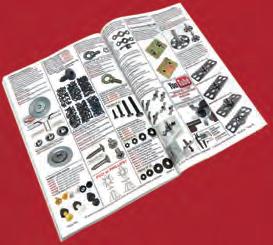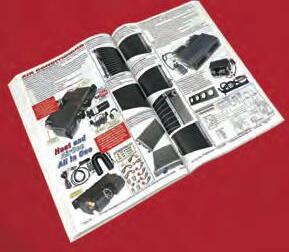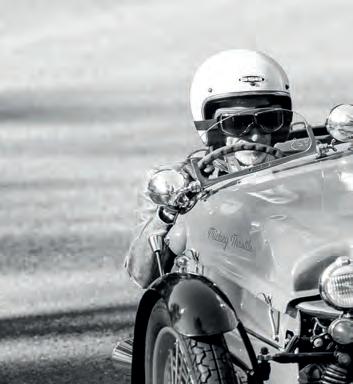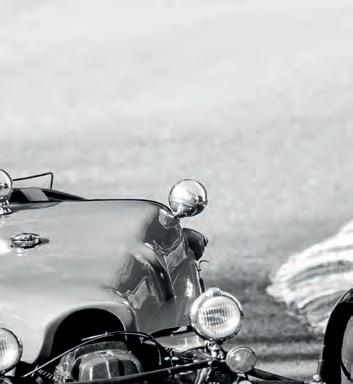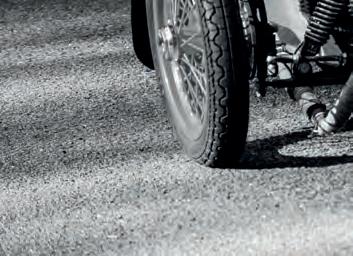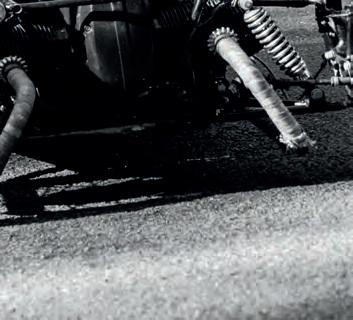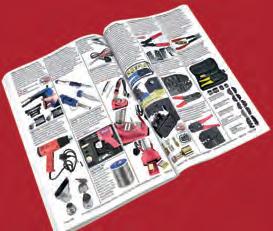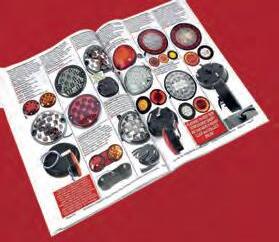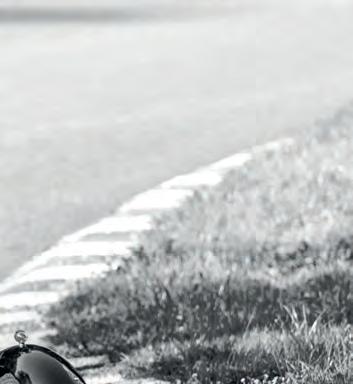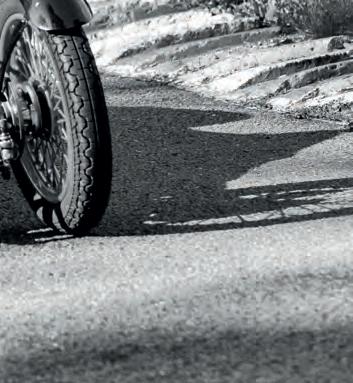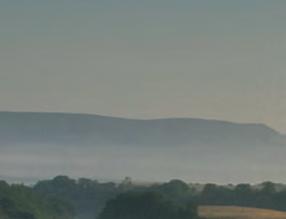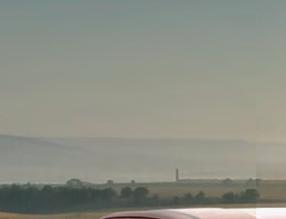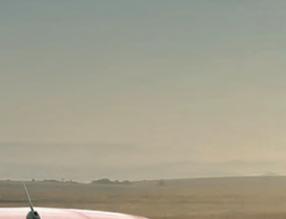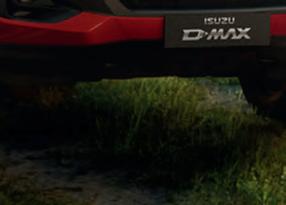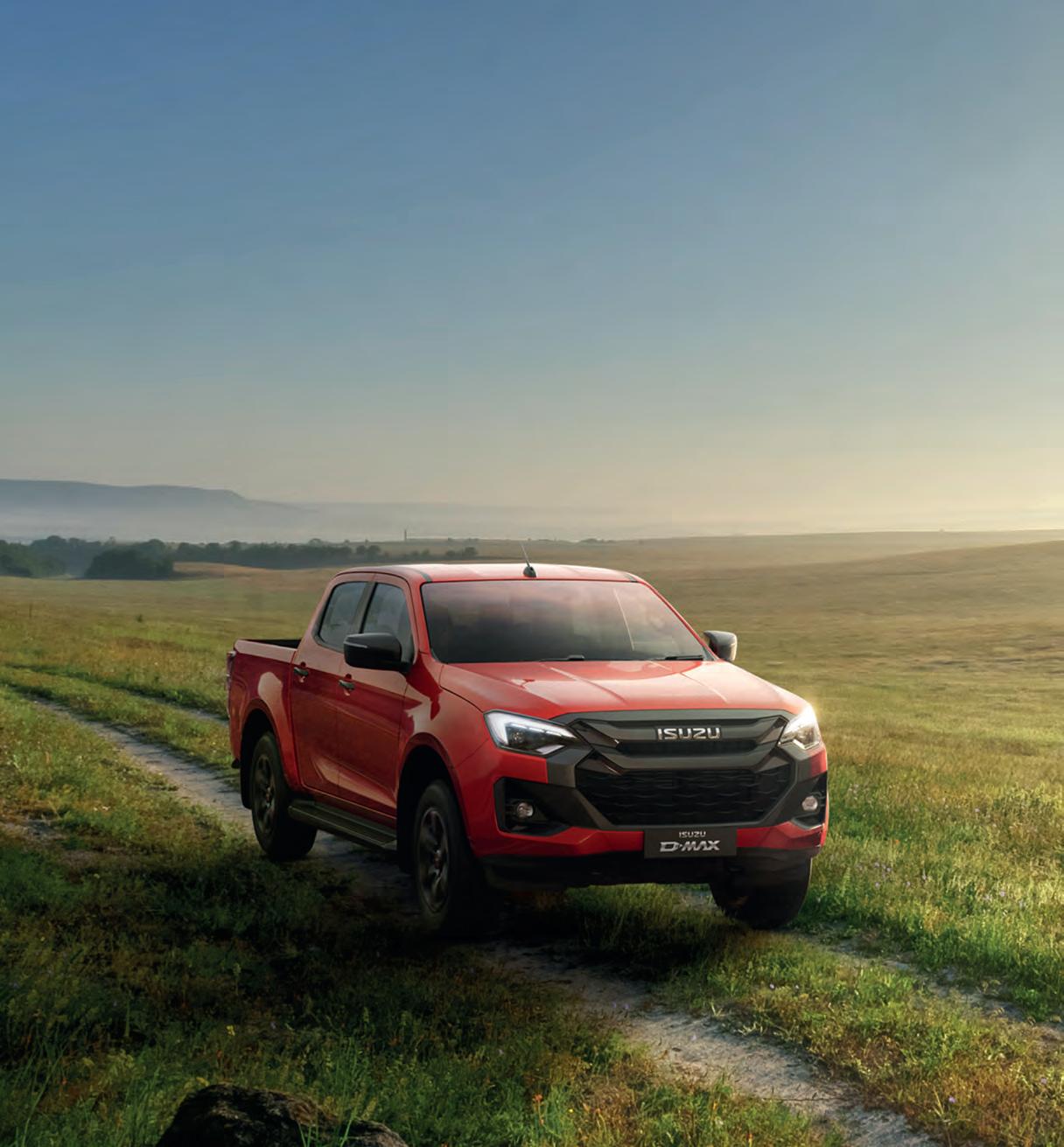




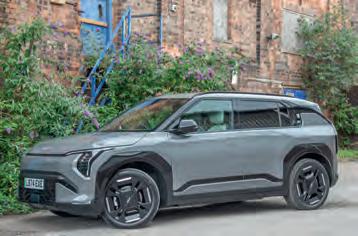






DRIVEN KIA EV3: Is this the new gold standard in affordable crossover SUVs?



















DRIVEN KIA EV3: Is this the new gold standard in affordable crossover SUVs?








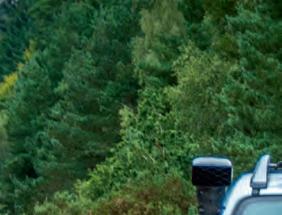







Helping you get the best from Britain’s wonderful rights of way – our legendary green lane roadbooks return after a couple of years’ hiatus




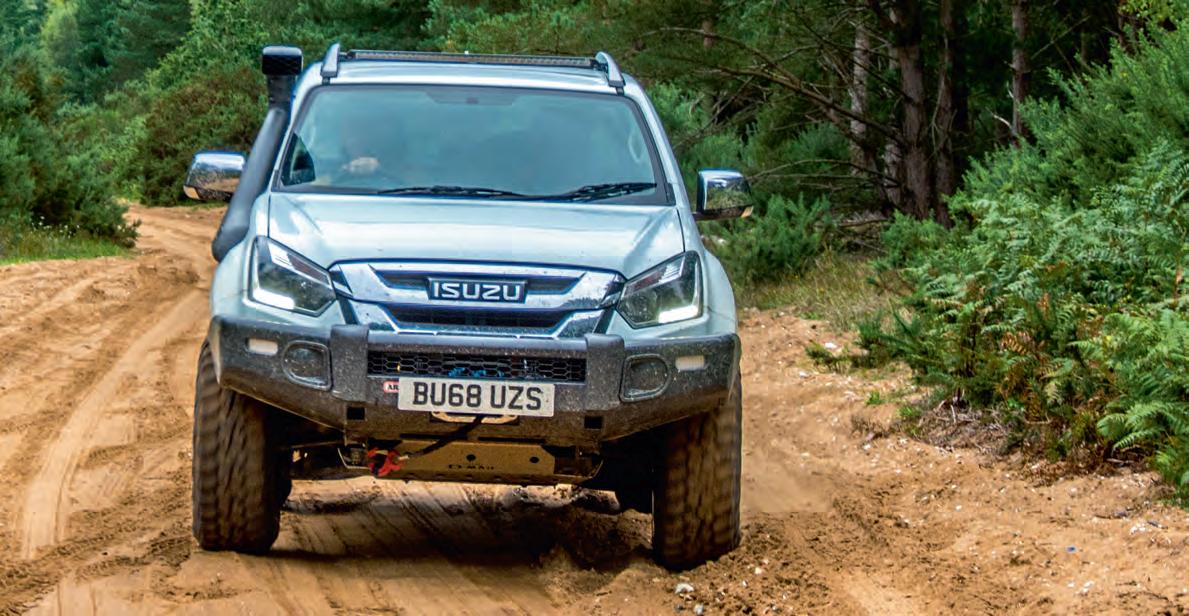

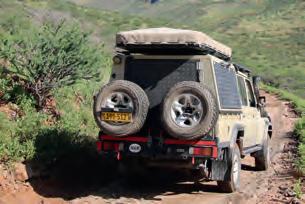
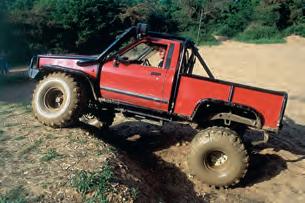
The Tomcat that kicked off the craze for winch buggies


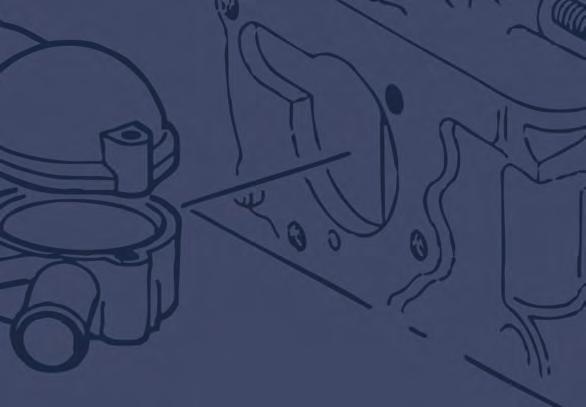

Own a piece of British motoring history with a classic British car! From the iconic Triumph to the beloved MGB, these legendary cars continue to capture hearts worldwide. Whether you’re restoring, maintaining, or upgrading your Triumph, MG, Rover, Mini, Morris Minor, Austin Healey, Land Rover, Range Rover or Jaguar we have the parts you need!
We guarantee the quality, we’re keen on price, we deliver fast and we know your car, ensuring your classic runs smoothly for years to come.
Join a passionate community of collectors and restorers who appreciate timeless British engineering. Explore our free catalogues today and keep your British car on the road where it belongs!
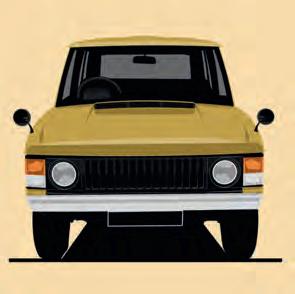

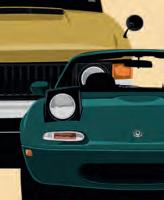
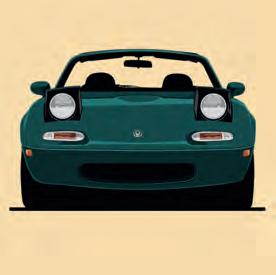

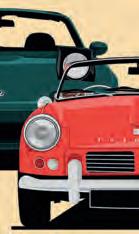


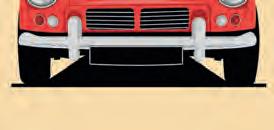
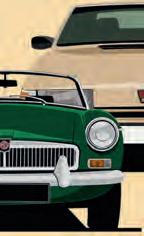
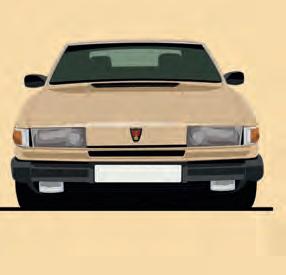
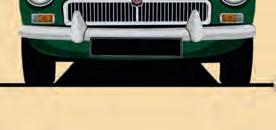
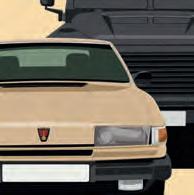

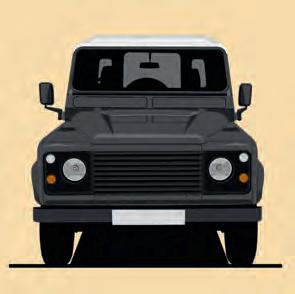


TF975 Roof Rack
TF1707 2.5m Hard Case LED Awning
TF1731 LED Shower Awning
TF705 Spot Lights
TF1038 Raised Air Intake
TF7220 Bulk Head Light Brackets
TF7116 Lights
TF31038 Halo & Bar Indicator & Side Light
TF7112 Halo & Bar LED Headlights
TF31011 Dynamic Side Repeaters
TF270 Grille & Headlight Surround
TF0028 TRED Winch Bumper
TF3360 12,500lb Twin Motor Winch with 50m Synthetic Rope
TF0017 Steering Guard
TF844 Front Diff Guard
TF662
TF667
TF488 2.5” Competition 8 Stage 12” Travel Remote Reservoir Shock Absorber
TF545 Mounting Kit
TF542 / TF544 / TF140 Bump Stops
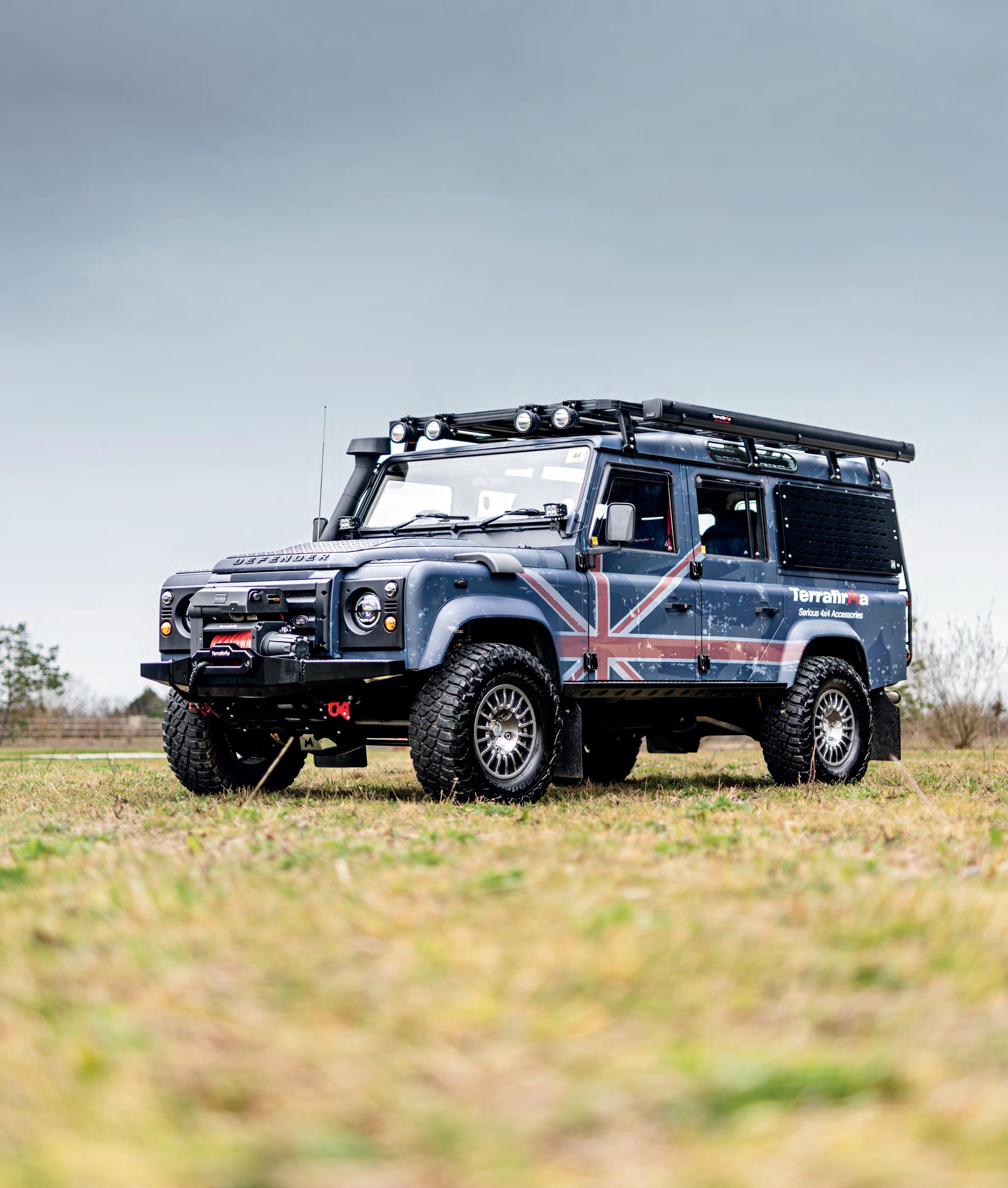
Wind Deflectors
Wind Deflectors
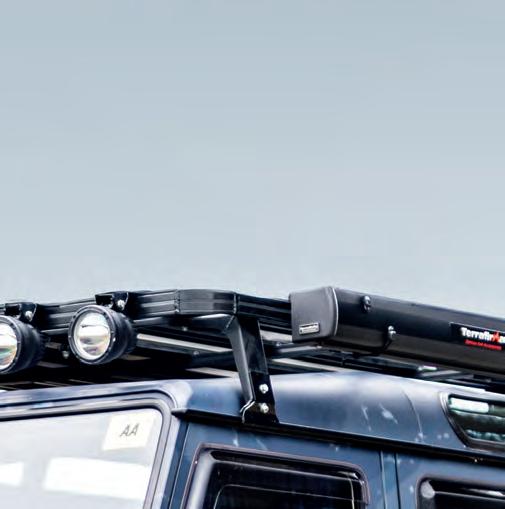
TF979 Flip Up Window
TF979BIN Internal Storage Bin
TF978 Fold Down Shelf
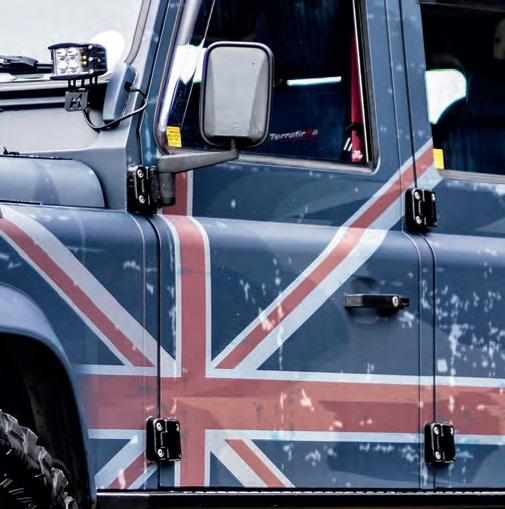
TF301 30mm Wheel Spacers
TF161G Winrace Aluminium Wheels
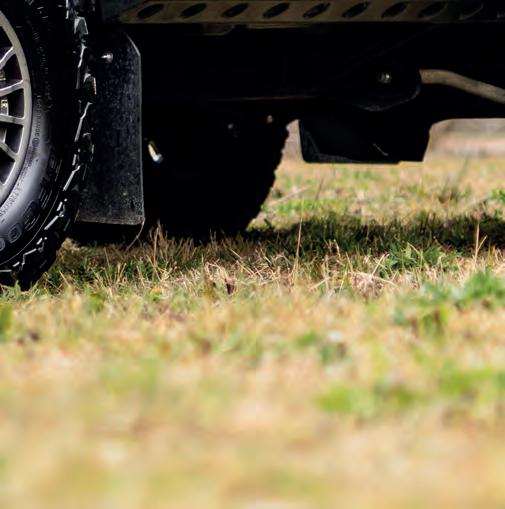

TF051 Swingaway Spare Wheel Carrier
TF980 Rear Ladder
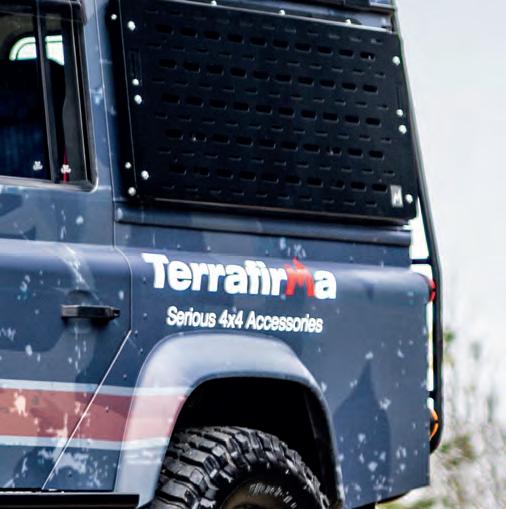
TF686 Big Brake Upgrade Front / Rear
TF645GD Stainless Steel +2” Braided Hose Kit
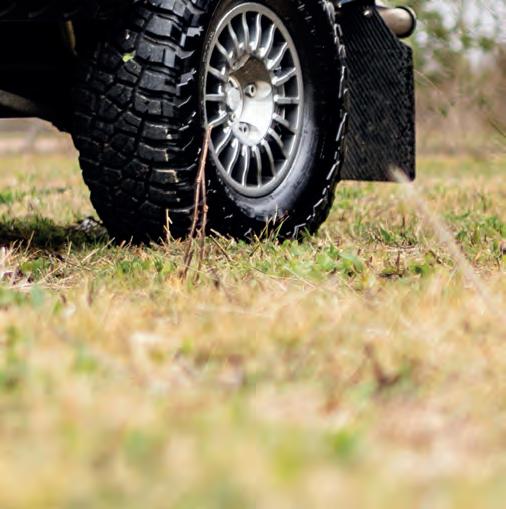
TF3010B Front Mudflap Brackets
TF3012B Rear Mudflap Brackets

range of Terrafirma Defender parts designed to enhance your journey.

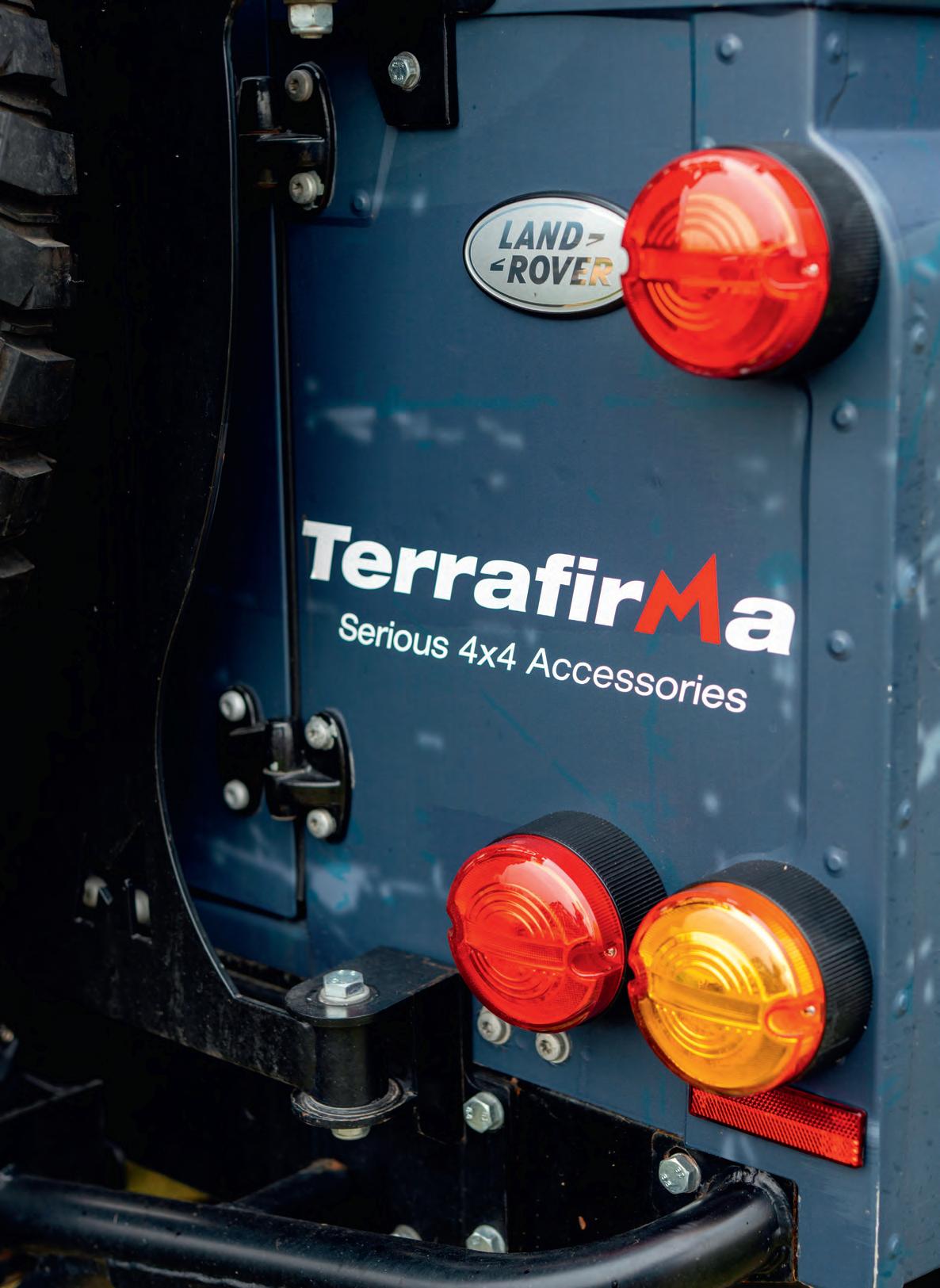





Tel: 01283 742969
Email: enquiries@assignment-media.co.uk
Web: www.totaloffroad.co.uk www.4x4i.com
Online Shop: www.toronline.co.uk
Facebook: www.facebook.com/totaloffroad www.facebook.com/4x4Mag
Editor Alan Kidd
Design Ian Denby-Jones
Contributors
Mike Trott, Gary Martin, Olly Sack, Dan Fenn, Gary Noskill, Paul Looe, Mark Fraser, Kenny Tucker, Tom Alderney, John Pearson
Photographers
Steve Taylor, Richard Hair, Vic Peel, Harry Hamm
Advertising Sales
Colin Ashworth
Tel: 01283 742969 isabelle@tandemmedia.co.uk
Subscriptions Agency
WW Magazines, 151 Station Street, Burton on Trent, DE14 1BG Tel: 01283 742970
Publisher and Head of Marketing
Sarah Moss
Email: sarah.moss@assignment-media.co.uk
To subscribe to 4x4, or renew a subscription, call 01283 742970. Prices for 12 issues: UK £42 (24 issues £76); Europe Airmail/ROW Surface £54; ROW Airmail £78
Distributed by Marketforce; www.marketforce.co.uk
Every effort is made to ensure the contents of 4x4 are accurate, but Assignment Media accepts no responsibility for errors or omissions nor the consequences of actions made as a result of these. When responding to any advert in 4x4, you should make appropriate enquiries before sending money or entering into a contract. The publishers take reasonable care to ensure advertisers’ probity, but will not be liable for loss or damage incurred from responding to adverts
Where a photo credit includes the note ‘CC BY 2.0’ or similar, the image is made available under that Creative Commons licence: details at www.creativecommons.org
Overlander 4x4 is published by Assignment Media Ltd, PO Box 8632, Burton on Trent DE14 9PR © Assignment Media Ltd, 2025


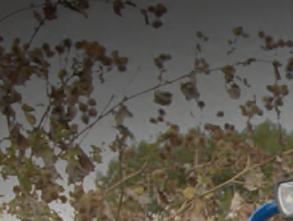




overlander4x4.co.uk
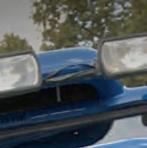


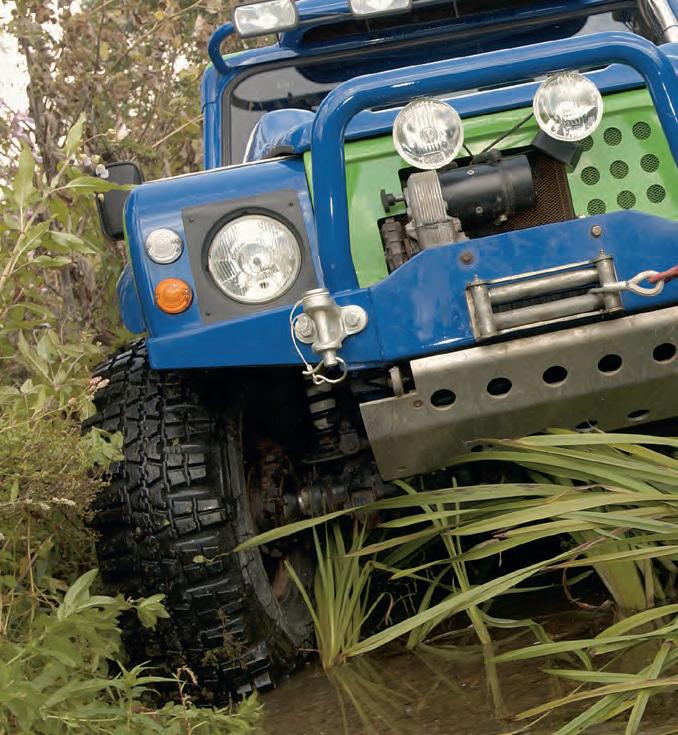

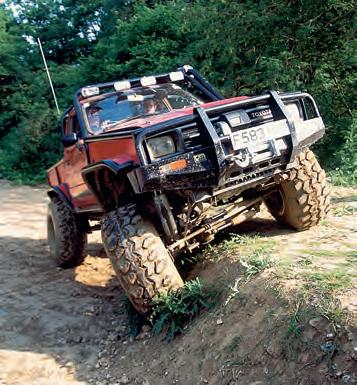













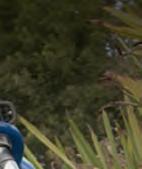

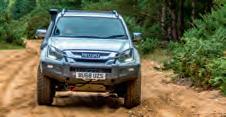





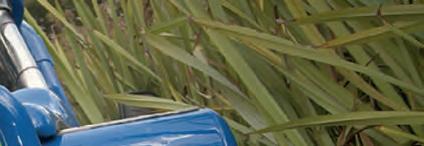
Pay quarterly by direct debit and you can get Britain’s only all-marques 4x4 magazine delivered to your door – for less than half the price on the front cover!






4 News
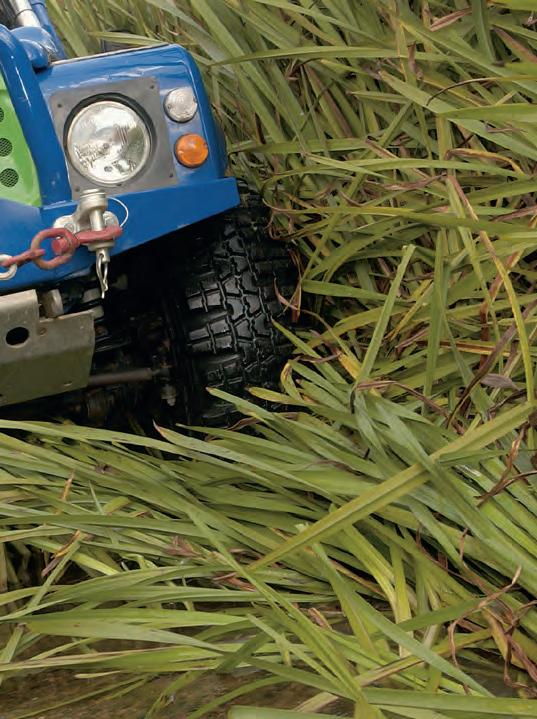
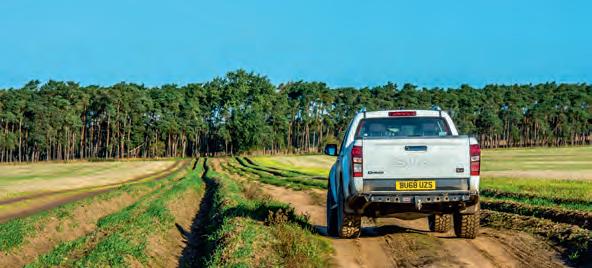
12 Products
Month
20 Subscribe



ARB and Isuzu team up to celebrate fifty years of the Aussie off-road giant, Twisted stakes a claim in America and a new design of restified Range Rover rises in the east
Suffering from condensation in your 4x4? The answer is in the mag…
Get Overlander 4x4 delivered for a fraction of the cover price
64 Next Month
One of the original super-diesel SUVs resurfaces as a highly individual modified off-road toy
12 Kia EV3
Little brother to the suave EV6 and mighty EV9 is one of the best crossover SUVs around
16 KGM Actyon
We’re always partial to a bit of green laning. Seems like this high-spec, high-value SUV wants to join in…
22 Winch Tomcat
A vehicle designed for comp safari racing but used for winching – making it one of the first purposebuilt lightweight buggies on the challenge scene
26 Bobtail Disco
Trayback special owned by a self-proclaimed ‘cabbage mechanic’
32 Monster Hilux
Huge tyres and big V8 – but get underneath and you’ll find that this is no redneck lash-up
36 V8 Series III Rebuild
Buying a car on eBay after a couple of drinks can be a recipe for disaster. Despite the journey from hell it took to collect it, this 88” Series III Land Rover turned out to be a triumph
44 Land Cruising in Namibia
When you’ve spent decades driving nothing but Land Rovers and suddenly you find yourself in the cab of a Land Cruiser, and there’s an elephant charging you, it’s time to learn fast
54 ROADBOOK Thetford
Our celebrated green lane roadbooks have been on hold for a while, but we’re pleased to announce that they’re back in all their glory!
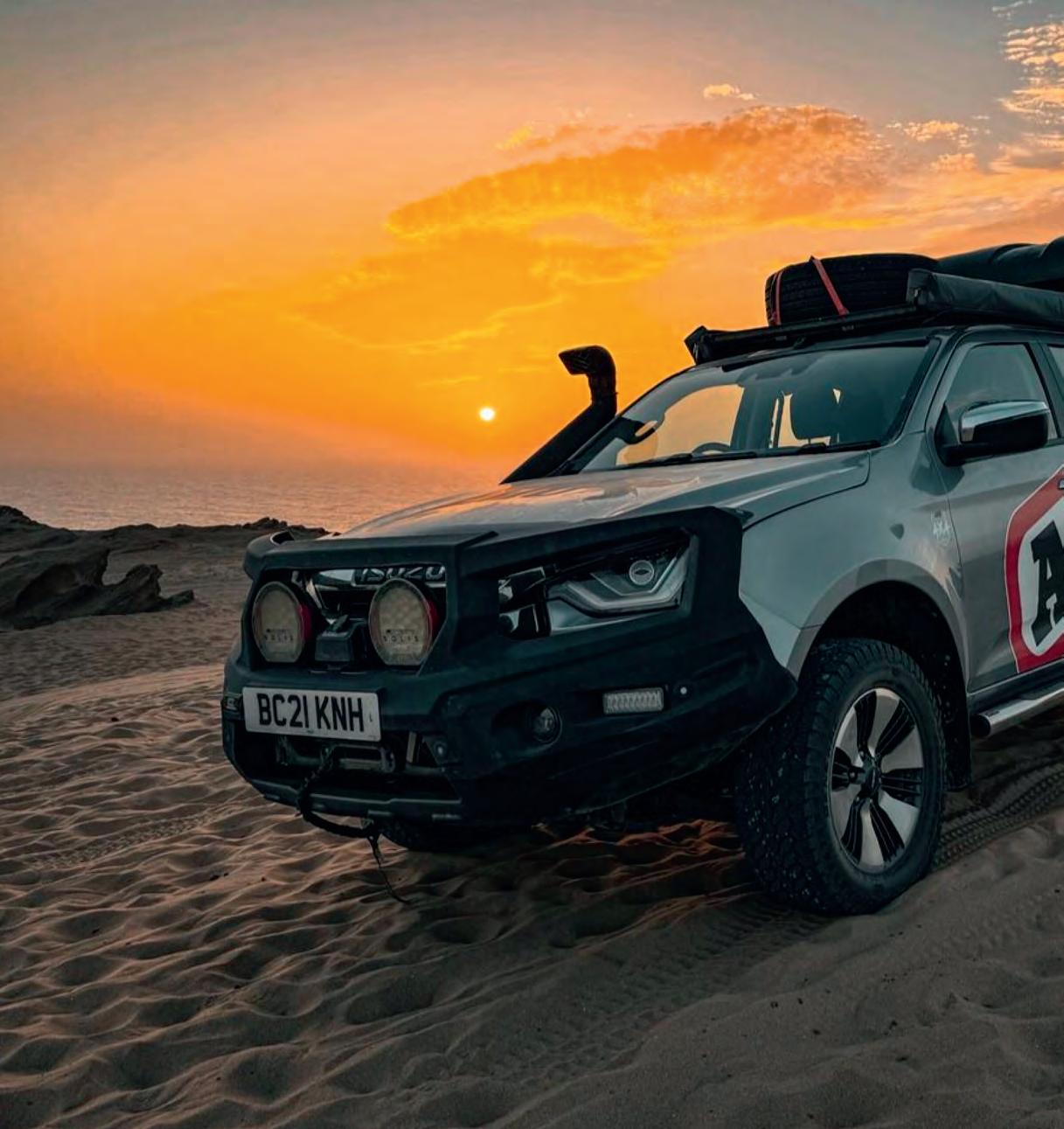


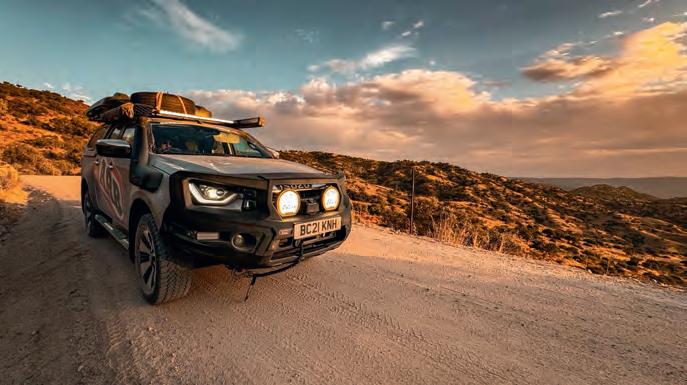
Australian off-road giant ARB was founded in 1975. To celebrate its half-century, it organised an expedition across the Outback –and here in Britain, the company’s UK arm decided to do something similar by driving to Morocco and back.

Dubbed ‘an expedition of a lifetime,’ the trip used a pair of Isuzu D-Maxes equipped with a variety of ARB accessories. ARB is an official supplier to Isuzu GB, with a number of the company’s dealers designated as ARB Hubs for customers looking to build expedition
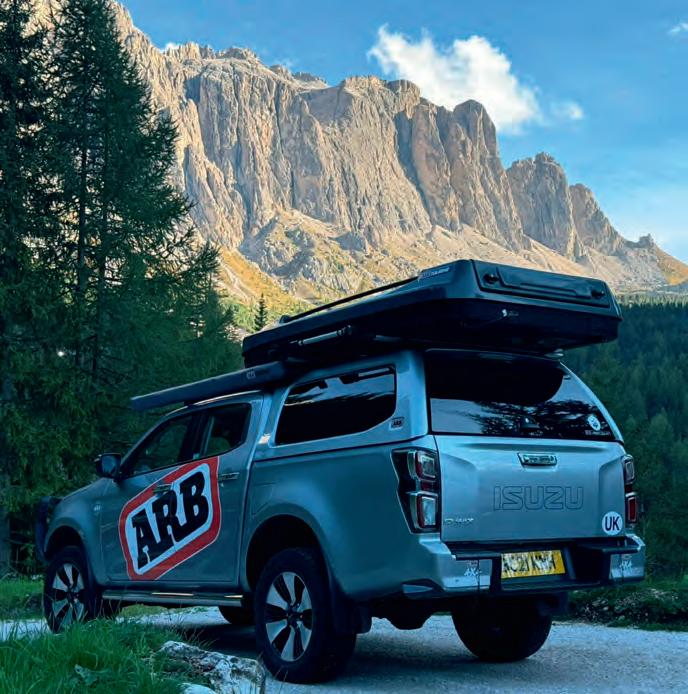
vehicles, and two of these, Bellinger Isuzu and Crawfords Automotive, were at the heart of an adventure that took them through France, Italy and Spain before crossing into Africa.
The vehicles were equipped with ARB’s Old Man Emu suspension and Stealth Bar to aid them off-road, the latter carrying winches and ARB recovery points. For living on and off the road, they also carried ARB’s Altitude roof tent atop the company’s modular BASE Rack, while beneath an Ascent Canopy they were equipped with an Outback Drawer System, Slide-Out Kitchen and ZERO Fridge. The tents were augmented with ARB’s Awning, Awning Room and Ensuite.
The base vehicles were both examples of the current D-Max, launched earlier this year in the UK, which features a newly added Rough Terrain Mode to go with its traditional dual-range 4x4 transmission. In Isuzu’s words, the trucks were ‘perfectly equipped for the demanding expedition, which was designed to test the limits of ARB and Isuzu D-Max engineering while showcasing the spirit of adventure that defines the two brands.’
The 10-day itinerary was split across various teams, with ARB UK Field Sales Managers Steve Waltho and Darryl Middleton kicking things off before Oxfordshire-based Bellinger Isuzu’s Alan Rixton and Thomas Zuidhof took over for the trek through the UK, France and Italy. Following this, Bellinger MD Oliver Dimbylow and Sales Manager Joe Bellinger took the wheel for the leg through Italy and into Spain, where the final outward changeover took place and Crawfords Automotive Chelmsford’s Marketing Manager Hannah Kelsey joined for the conclusion of the route to Marrakech.
‘The route ahead was packed with incredible landscapes,’ commented Zuidhof. ‘From alpine passes to desert dunes, we truly put the D-Max and ARB kit through their paces. This is what it’s all about: real-world adventure, shared with great people – in stunning locations.’
Dan Wallis, Sales Manager at ARB UK, added: ‘This expedition is much more than a celebration of five decades in business. It’s going back to our roots and showing what ARB is all about – adventure, exploration, and making fun memories.’

Velvet Motorworks is a new company with a new idea. Based in the Estonian capital of Tallinn, it’s taking L322 Range Rovers and restifying them into bespoke vehicles with the style of the original Classic.
Why? ‘I was a teenager when the L322 first came out,’ explains company founder Mihkel Külaots. ‘I vividly remember seeing it in real life for the first time. I was amazed by how powerful and luxurious that boxy machine felt.
‘Now, with the earliest examples over 20 years old, these vehicles deserve a proper tear-down, rebuild, and a bit of extra character. Not just a restoration, but a revival of a modern classic.’
What this means in practical terms is that the company plans to rebuild a series of third-gen Rangeys, in each case using a V8 Supercharged model as its base, ‘refining it for stronger performance and a more engaging, analogue feel – a return to the kind of connection modern SUVs have largely lost.’
It will do this using up-to-date chassis tuning techniques to improve the Range Rover’s comfort and handling still further (the L322 was never exactly a slouch in these areas) without losing any of the vehicle’s off-road capability. It will also fit the vehicle with a selectable active exhaust

system – allowing drivers to enjoy a quiet, refined drive or let the big V8 sing out in all its joyful glory. If you spent your formative years as a hot rodder running a big block on open headers, well, it won’t be like that. But it’s kind of the same idea.
Talking of hot rods, the art of mixing and matching from cars of various eras is a big part of the kustom game and that’s what Velvet Motorworks is doing with the way the Range Rover looks. The round headlamps and vertical grille slats take you straight back to the 1970s – though modern infotainment and safety features keep it up to date in the ways you would want it to be.

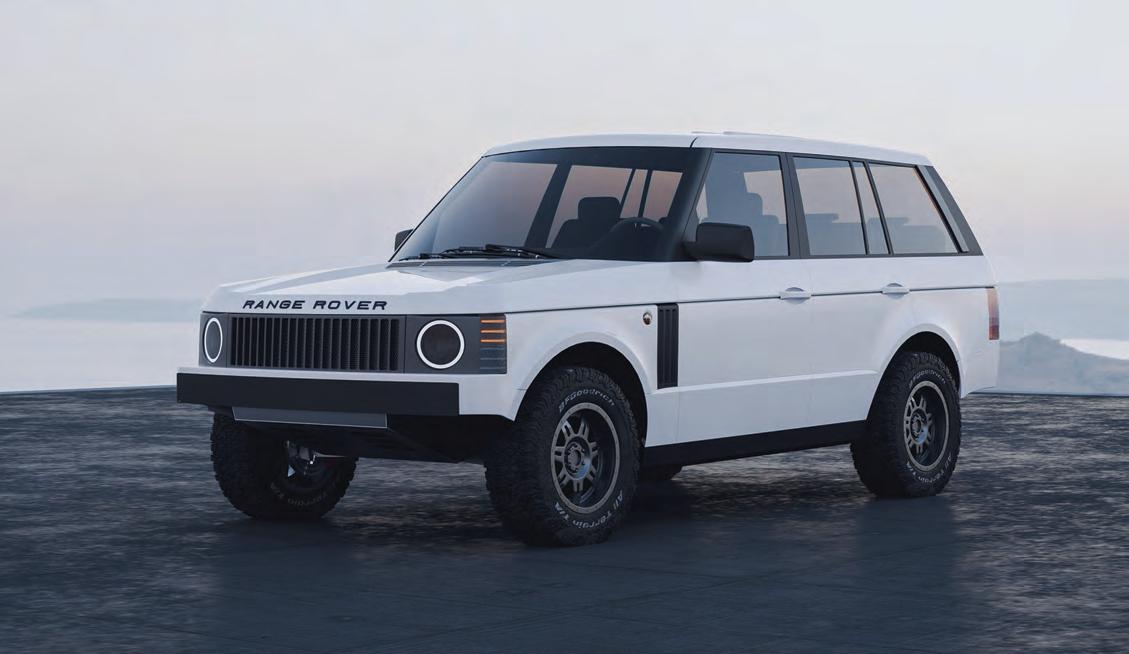
It has more presence on the road, too, thanks to a subtle lift which makes way for a bigger wheel and tyre combo. The company’s design renders suggest the latter will feature BFGoodrich All-Terrains, though we’d imagine most customers will want to keep it more road-focused than that. In the cabin, we’re promised ‘handcrafted interiors mixing premium materials with modern conveniences.’
Those renders are all we’ve got to show for now as a prototype won’t be completed until mid-2026. Limited production will begin straight after this, however, with the first customers due to receive their vehicles by Christmas of that year.
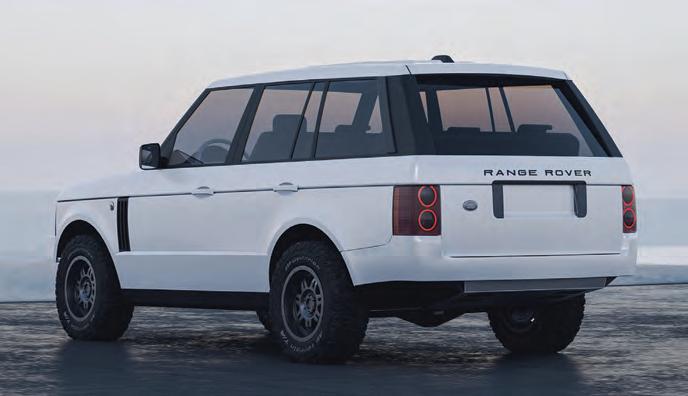
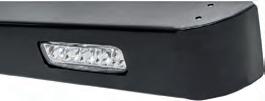

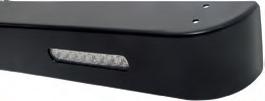

These smart and functional standard fit Defender bumpers are equipped with a pair of LED lights for additional lighting in the dark or day light running for safety.
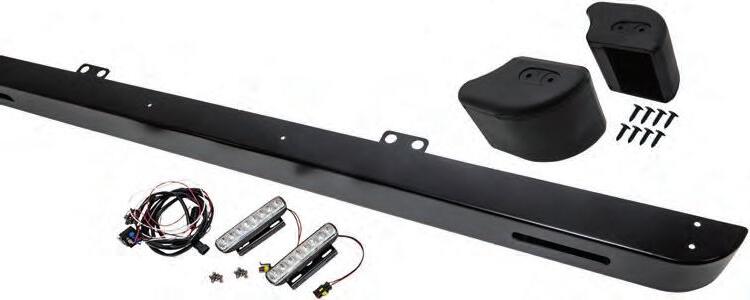






Twisted Automotive, which is a quarter of a century old this year, has for the first time launched an official presence in America. The Yorkshire company has partnered with the Monticello Motor Club (MMC), an exclusive automotive country club nestled in New York’s Catskill Mountains, whose final race meet of the 2025 season hosted its first US showcase.
The club is frequented by the sort of high rollers who can afford the £180£320,000 it typically takes to put a
Twisted rebuild in your garage. Guests at the event had the chance to browse a selection of the company’s products (‘a curated Twisted line-up,’ to quote: maybe it’s something to do with Land Rovers but really, what is it about that word that makes people so determined to misuse it) including a 110 TV8 double cab, a Series III 109” and TD5 110 and 130s.
The event also marked the international debut of the TBug, an original-shape Volkswagen Beetle inspired by the classic Baja Bug but packing twice the power and


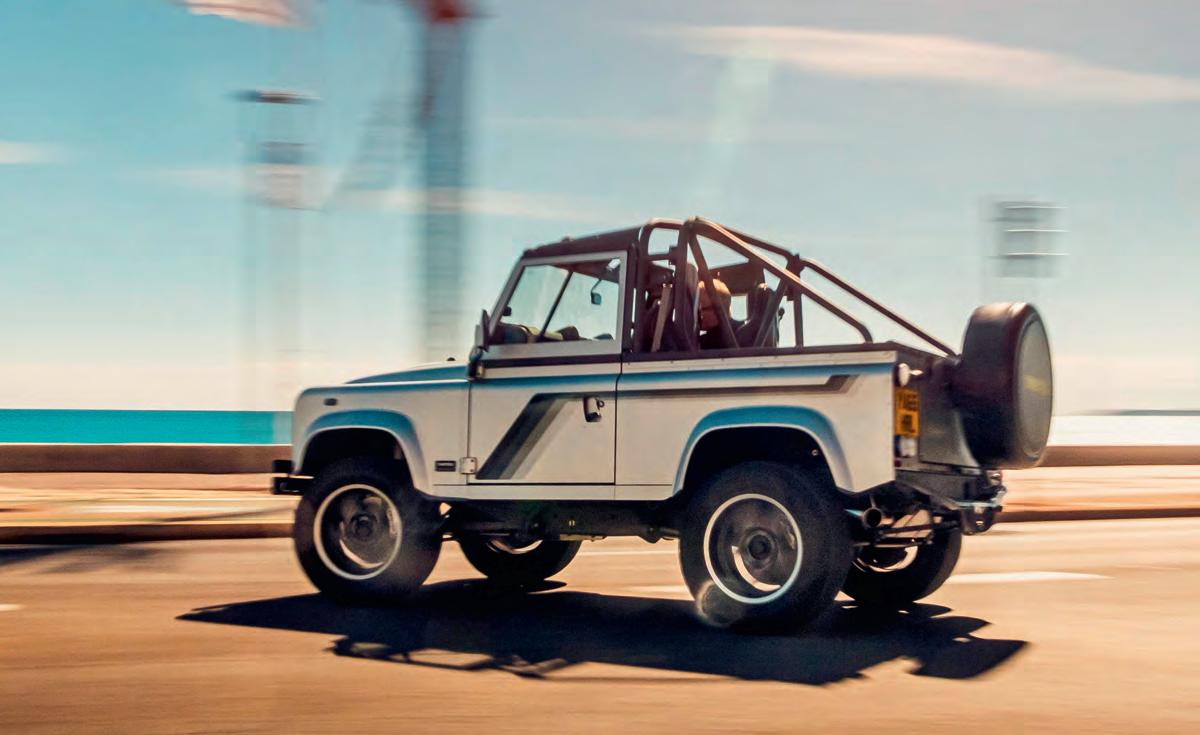
running performance off-road suspension. Not a Land Rover but certainly a fellow traveller. For those fortunate (and rich) enough to have been invited, an exclusive driving route in the scenic landscape of the Catskill mountains was followed by an afternoon of hospitality complete with roast beef and Yorkshire puddings from back in Twisted’s home county.
‘As Twisted takes root in America, our goal is to build a strong community of enthusiasts, adventurers, and collectors across North America,’ said director and
IN A WELCOME DIVERSION FROM THE FALLOUT FROM THE CYBER ATTACK THAT CRIPPLED JLR for much of the late summer and early autumn, the company’s operations have become more energy efficient thanks to the roll-out of three major solar installations. These include a 26-hectare, 18-megawatt ground-based solar farm at its HQ in Gaydon and the UK’s largest automotive roof-top solar array at its Wolverhampton engine plant.
In addition, a new 20-megawatt solar expansion was recently completed on the roof of JLR’s joint venture production facility in China, which now generates more than 50% of the site’s energy needs.
The Gaydon solar farm, which covers an area equivalent in size to 36 football pitches, supplies up to 31% of the site’s energy needs. JLR has also planted native wildflowers beneath and between the panels and restored hedgerows with bird and pollinator-friendly species, ‘targeting a biodiversity uplift well above mandated levels.’
The company is not resting on its laurels, however. An expansion to the roof-top installation at its Electric Propulsion Manufacturing Centre in Wolverhampton, is due for completion this autumn, with 18,000 panels generating around 9500 megawatts per year – some 40% of the factory’s needs.
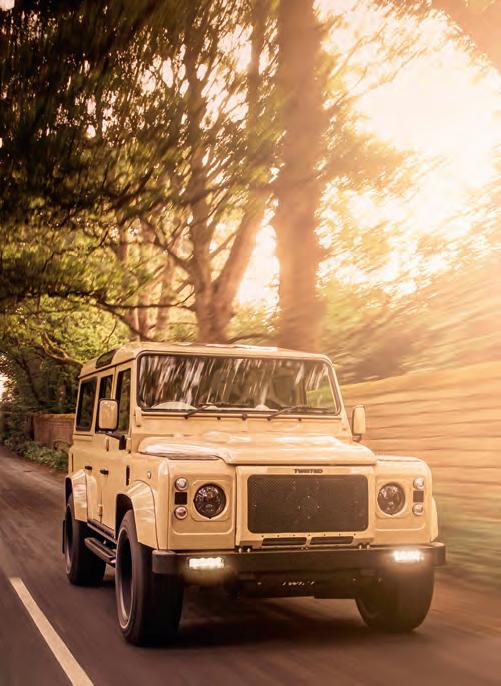
MMC member Jonathan Wilson. ‘As luxury carmakers explore lifestyle-driven experiences rather than just product launches, Twisted joins the likes of Aston Martin and Lotus in expanding into the US market. This is just the beginning.’
Twisted founder Charles Fawcett went still further, describing the company’s move into the US market as the most significant chapter in the company’s story to date. ‘America has always loved the Defender,’ he said, ‘but this is the first chance to experience it the Twisted way.
‘Monticello Motor Club is the perfect place to begin that journey. With expansion into Japan and now America, Twisted is cementing its position as a global luxury automotive brand, while staying true to our philosophy: stay anti-ordinary.’
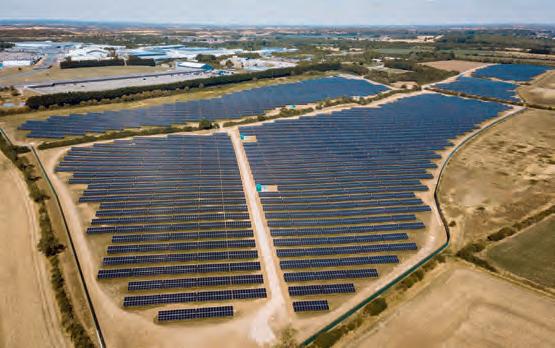

will look to determine why the problem occurred and discuss with you how you can avoid it happening
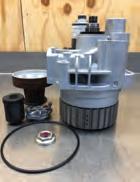
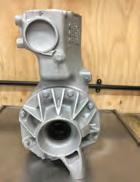
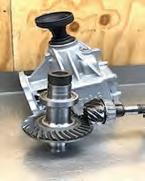
Summer has definitely given way to autumn now and if you haven’t already come down in the morning to be greeted by a vehicle full of condensation, you soon will. Obviously it helps if your vehicle is an old Land Rover, because they’re capable of finding condensation in a desert, and other proper off-roaders of a certain age are every bit as prone to it, but even the modern breed of SUVs that come with their own butler and chambermaid aren’t immune.
Which is why you ought to be interested in the Summit Reusable Dehumidifier Bag. Now available through the Britpart network, this absorbs excess moisture from the air to prevent the build-up of condensation and keep your windscreen clear – as well as preventing mould, mildew and musty smells in the process.
Measuring 200 x 115 x 35mm, the bag is filled with approximately 350g of activated

silica gel capable of absorbing up to 40% of its weight in moisture. In effect, it acts like a sponge, locking in moisture to keep your vehicle’s windscreen and windows mercifully clear and free of fog.
Made from eco-friendly materials and complying with the Restriction of Hazardous Substances directive, the bag has a round indicator panel on it which turns from blue to pink when it needs to be recharged.
Price: ca £250 plus VAT | www.lazerlamps.com
LAZER LAMPS HAS UNVEILED an upgraded version of its Carbon-2 LED driving lights. which now come with greater functionality, lower weight and UNECE Reg149 approval – making them road-legal. These now feature in a range of Lazer’s Fog Light Upgrade Kits, including for the current Toyota Land Cruiser.
Available with Spot and Drive beam patterns, the lights can operate in either High or Dipped beam modes and at a high and low output levels. The colour of light on the dipped beam can also now be optioned in either white or yellow; the latter is ideal in fog or falling snow, or in dusty conditions.
Housed in high-strength, heat-resistant PC-ABS material, the lamps are kept cool by an aluminium heat sink which helps keep their weight down to 192g apiece.
Inside, they feature dynamic drive modulation to protect their electronic components in extreme environmental conditions.
The lamps have a 5000K colour temperature for maximum sharpness and definition. They’re watertight to IP68 and come with what Lazer calls an ‘unbreakable’ polycarbonate lens – as well as the reassurance of a 5-year warranty.
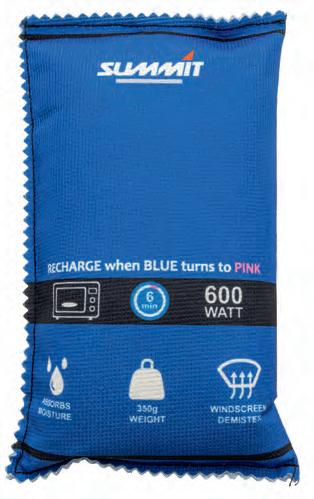
Doing this is simply a case of sitting it on a radiator or in your airing cupboard, or even chucking it in the microwave, to dry out the moisture held inside. You can then pop it back in your 4x4 to continue doing its job.
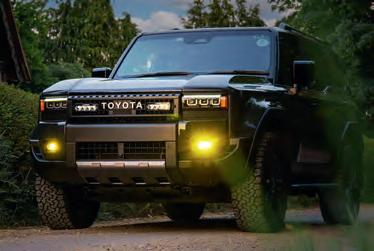
• The Fog Light Upgrade Kits for the 250-Series Land Cruiser features a pair of new Carbon-2 DRIVE lights with Yellow Dip function. Supplied pre-mounted into left and right-hand lamp holders, these deliver a supplemental high-beam driving light and at the flick of a switch, a yellow dipped beam light output for off-road use. In
addition, the lights have white and amber backlight functions and their housings have a textured finish meaning there’s no need for them to be painted.
The kit replaces the Land Cruiser’s original OE fog lights, with a cutting template supplied for their fitment. It comes complete with a twin-lamp wiring kit, while Lazer also supplies a direct connection interface for vehicles with LED headlights.
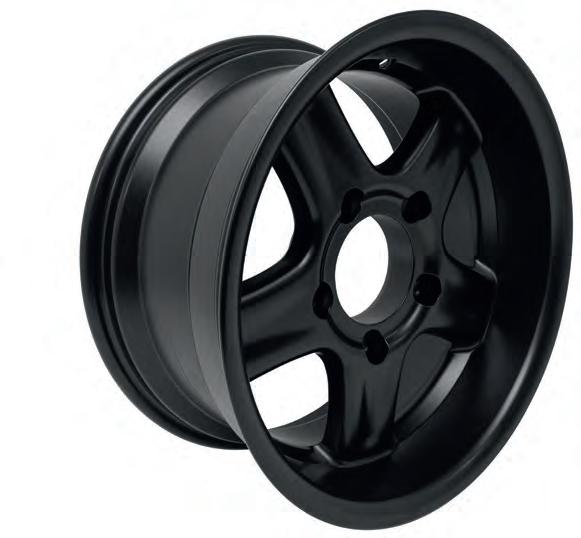
WE’VE ALL GOT AN OPINION on what’s the biggest diameter of wheel you should put on a Defender. Some have a view on the smallest, too. Depending on where you stand on these matters, 18” could be either a happy medium or neither one thing nor the other, but either way there are plenty of options out there.
There’s always room for another, though, and that’s exactly what this 18x9” satin black Caradoc alloy from Britpart is. It has a deeply dished design and an ET0 offset to go with its 5 x 165.1 PCD, so you’re looking at plenty of width without any need for spacers. Your Defender’s turning circle will love you for it, and if you’re running lifted suspension you’ll be able to work said turning circle with significantly less worry about it falling over.
The wheels have a load rating of 1100kg per corner. They’ll fit all original-shape Defender models, including pre-Defender 90s, 110s and 130s.
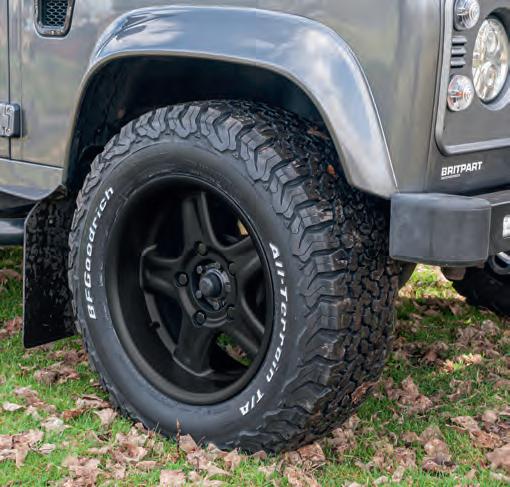



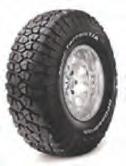
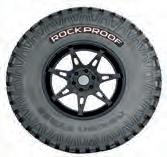

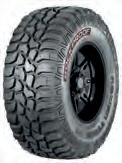








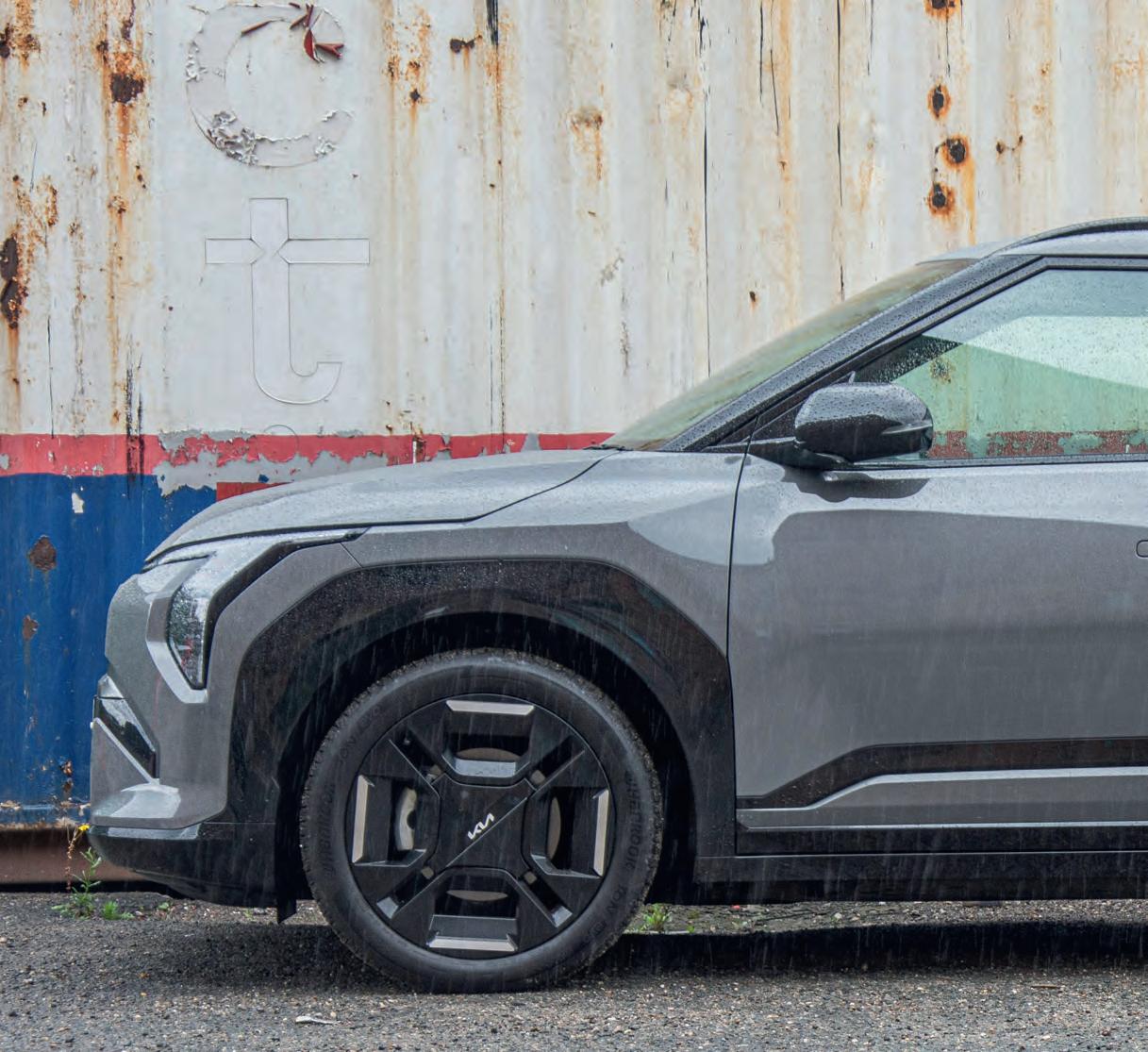
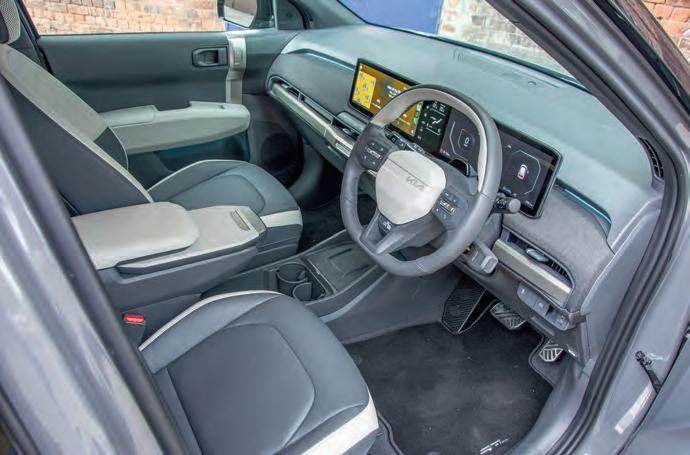

I’s been a long time since Kia made a false move. That the company has left behind its days as a budget brand is not exactly anything new – but it can still come as a surprise to be reminded how, the further it gets in its transition to the mainstream, just how premium its cars have started to feel.
Kia used to exemplify the pile-it-high ethos of tiger-economy car makers whose vehicles came with eye-popping kit lists but the kit itself was as cheap as the cars were bland to look at, stodgy to drive and trimmed with materials that aged about as appealingly as a kebab. But they’ve long since turned that on its head. Today’s Kias

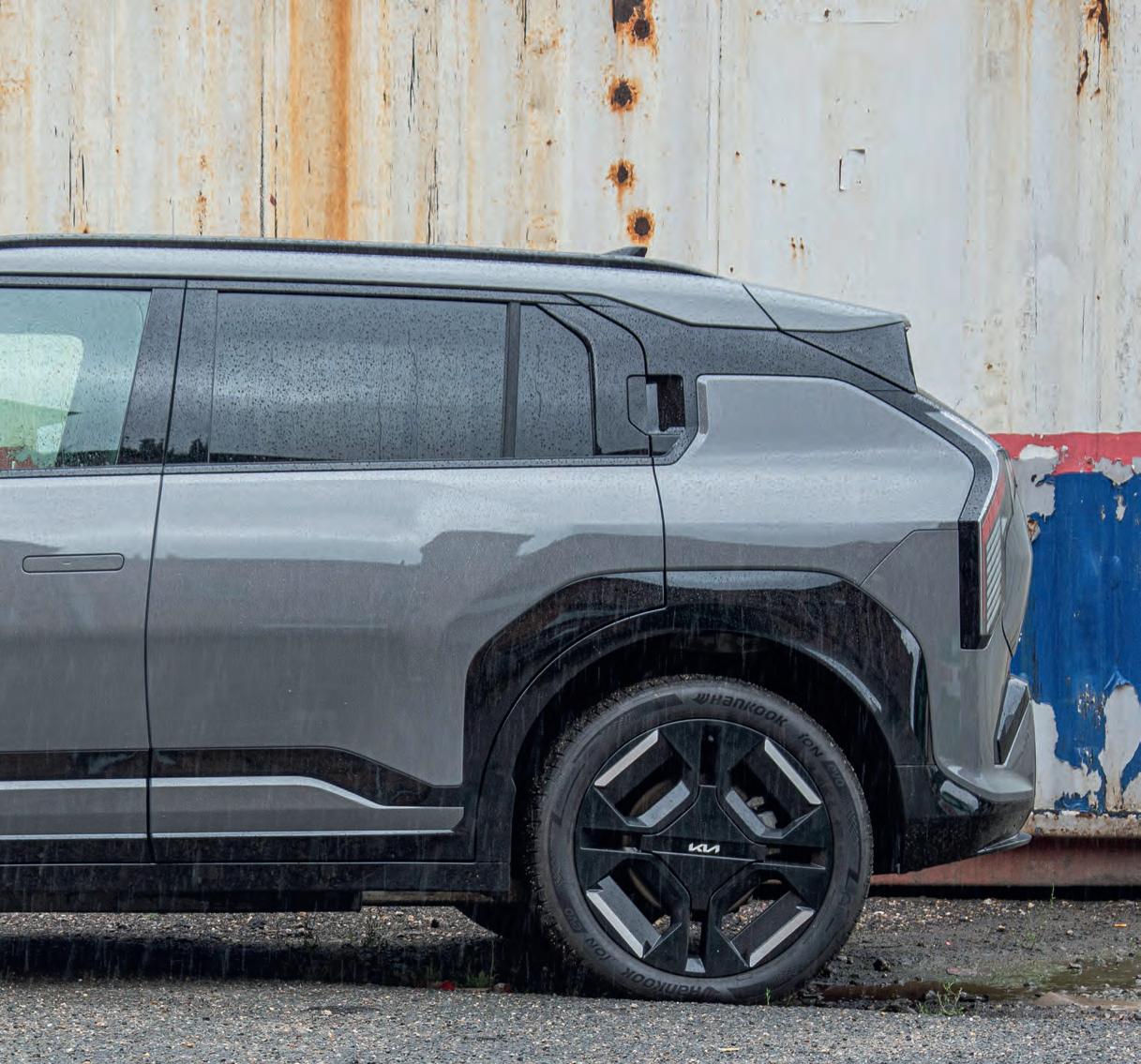
catch the eye and do a lot more besides: they’re engaging to drive, practical to use and beautifully laid out, they’re trimmed and equipped to a very high standard and they’re as well put together as they are reliable. They don’t cost Sunday market money any more, and at the top of the range they’re even priced into premium territory, but they still represent outstanding value. No wonder Kia has muscled in on the top end of the car market. In 2025 so far, it lies second overall for total sales, just behind BMW. It’s outselling Ford; think on that.
The Sportage is the one making the big numbers, which says something about what people want as it’s now one of the few Kias
not available as an EV. But the world is what it is and as more and more people come to accept that electric is the way it’s going (or in some cases, discover that EVs are not the devil incarnate after all), you’re seeing more and more of the company’s plug-in models on the road. Regular readers will know that we’re big fans of both the EV6 and the EV9 – so it won’t surprise you that we’ve been waiting with baited breath for their little brother, the EV3.
This is more of an urban-scaled SUV, if such a thing exists outside the minds of marketing people. It’s only available with two-wheel drive, so we won’t be repeating our EV9 trick and taking it laning on
Houndkirk Moor, but it starts at £33,005 and even at the top of the range, with GT-Line S trim, the biggest battery and a heat pump, it’s still only £43,905. Kia doesn’t rinse you with a load of options that ought to be standard, either – metallic paint will add £650 but that apart what you see is what you pay. Hiding ten grand in the options list doesn’t fool people, and if you want proof just look at how many more cars Kia sells than most of the brands that do it.
So, the EV3. You’re not getting stitched up and that’s a good start. We’d say avoid the very cheapest model, unless you’re literally never going to leave town, as that one comes with a significantly smaller
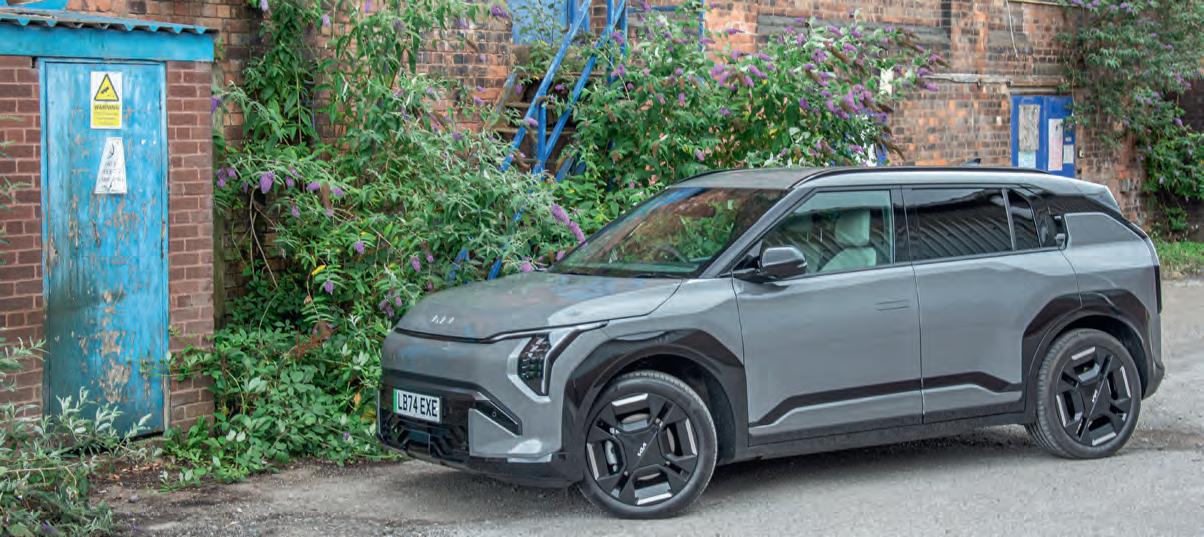
battery. After that, you’re simply choosing between three trim levels and, on the top one deciding whether to add the heat pump. For £900, we’d say you’d be mad not to.
The vehicle you see here is one level down from that, anyway. It’s the GT-Line, which loses a fair few luxuries to the GT-Line S but only costs £39,405, keeping it below the £40k tax threshold. It’s still very well equipped, with 19” alloys, heated faux leather seats, all-round parking sensors and reversing camera, Bluetooth, sat-nav, wireless phone pairing and a full-width screen containing a 12.3” digital dash and to its left, a 12.3” media unit – yet but what really strikes you when you climb aboard is the styling and quality of the cabin.
It doesn’t bash you over the head with what it’s got so much as reel you in with
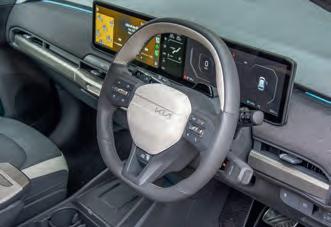
what it’s like. It’s airy, simple and comfy, and everything you touch feels classy and well made. If there’s an moan, it’s that the heating and air-con controls are obscured by the left of the steering wheel and being digital, you can’t feel for them, meaning you have to crane your neck to look at what you’re doing; that apart, it’s a pleasure to sit in and a piece of cake to drive.
The seats are lastingly comfortable, with very acceptable two-tone leather-look trim and the same soft, squashy headrests as the EV9. There’s plenty of room in every direction and an excellent view out that’s not obstructed by the waistline or A-posts. What you think is going to be a cubby box lid is just an armrest but there’s a huge tray below it with adjustable cup holders, an inductive charging pad and more than enough space for all the clutter you’re apt to bring with you when you climb aboard.
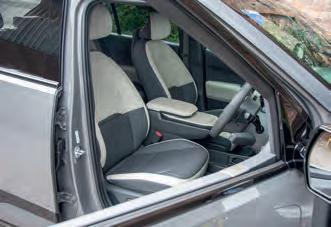
EV3’s cabin is elegantly simple and very well put together using high quality materials. It’s well enough equipped in this mid-range GT-Line form (GT-Line S gives you a lot more but is priced usefully higher), but it’s the overall look and feel of it that really gets you. The wide multi-function screen never loses its wow factor and the faux-leather seats are as comfy as they are eye-catching, with the same soft, pillow-like headrests as the EV9
There’s enough legroom to let a hefty six-foot unit get comfortable without fetching the seat all the way back, which is good as it means another hefty six-foot unit will be able to sit behind him. There’s plenty of headroom in the rear (this model doesn’t have a sunroof) and the seats are both roomy and comfortable enough for four adults to travel a good distance without anyone starting to get a lip on.
Talking of lips, the one at the back is a little high when you’re loading the boot, but there’s no shortage of space so you can load plenty. If you need to carry more besides, the seats fold down to lie a few degrees off flat, giving you a long, boxy area for carrying cargo. The tailgate is manual in this model – an electric one is among the perks you get with the top-speccer.
There shouldn’t be any difference in their drivability, though. Every model has the
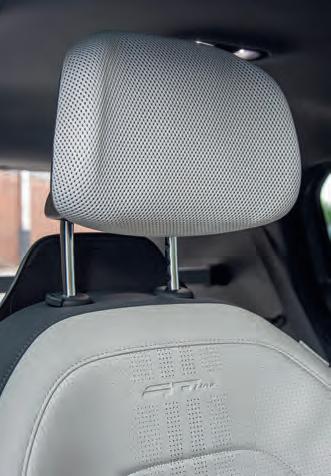
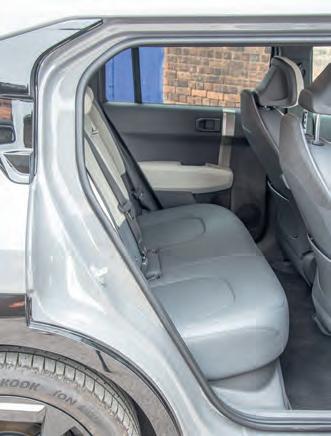
same 201bhp, 209lbf.ft motor, MacPherson strut front suspension and multi-link rear; the entry-level Air has 215/60R17s, which may give you some extra ride comfort, while the GT-Line and GT-Line S roll on more handling-focused 215/50R19s, but unless you’re really going for it we’d be surprised if you ever notice the difference.
What you will notice is a useful turn of pace, especially when you engage Sport mode. The book of words says 0-62 comes up in 7.9 seconds, which sounds quite conservative to us, but what’s good is that after the initial burst of hold-on-we’re-in-anEV acceleration from the line, it keeps going through the mid-range. There are EVs that make you hoot with glee at the lights but gasp in fear when overtaking; this is very much not one of those.
It’s even quite agile on the open road, with enough steering response at speed and
Rear seats have enough legroom for one six-footer to get comfortable behind another, so long as the one up front is not too greedy. They drop near-flat to make the most of the EV’3 angular body and create a very usable cargo space; even when they’re up, though, the boot behind them is still big enough for most needs
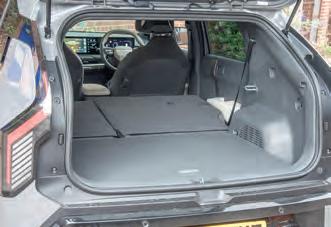
taut handling even when you’re chucking it about. It feels sporty and up for it, resisting body roll very well; there’s a sense of fun to it that you might not expect but you’ll certainly enjoy discovering.
You don’t pay for this with a go-kart ride in town, even on those lower-profile tyres. It’s not in magic carpet territory but it’s perfectly pleasing to drive, even on the tragic road surfaces Britain is known for. Without an engine to drown it out, you hear the suspension as it works, but it’s not intrusive and the bumps and shudders are kept comfortably at arm’s length.
Move on to the motorway and now it’s tyre noise you’ll be hearing. Again, however, it’s not intrusive; the EV3 settles well at cruising speeds and doesn’t need constant adjustments to keep it on track, so it’s a docile companion on a long run. It’s all-round pleasing to drive, easy when you want it to be and rewarding when you’re in the mood.
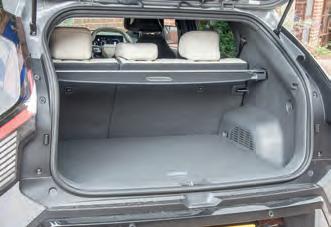
The big reward, of course, comes with its running costs. Kia quotes a range of up to 375 miles; filter that through your own personal sense of scepticism, cynicism or pure unbridled hate, but that many miles for a few quid’s worth of electricity out of a wall box at home sounds like a good deal to us. Of course, there are many factors that’ll bring the real figure down, and the cost of a long journey will be messed up by the mightas-well-stick-with-petrol price of commercial chargers but used properly this will be a lot of mobility for a little of your hard-earned. That could be the verdict on any EV, of course. It’s relevant here because we started off by talking about how Kias used to be cheap. The EV3 is exactly that to run and, by typical standards, to buy or lease. But more to the point, it’s yet another exceptional SUV from Kia – and another reminder of how premium its cars have started to feel. It might not be an off-roader - but it’s a great way of getting about.
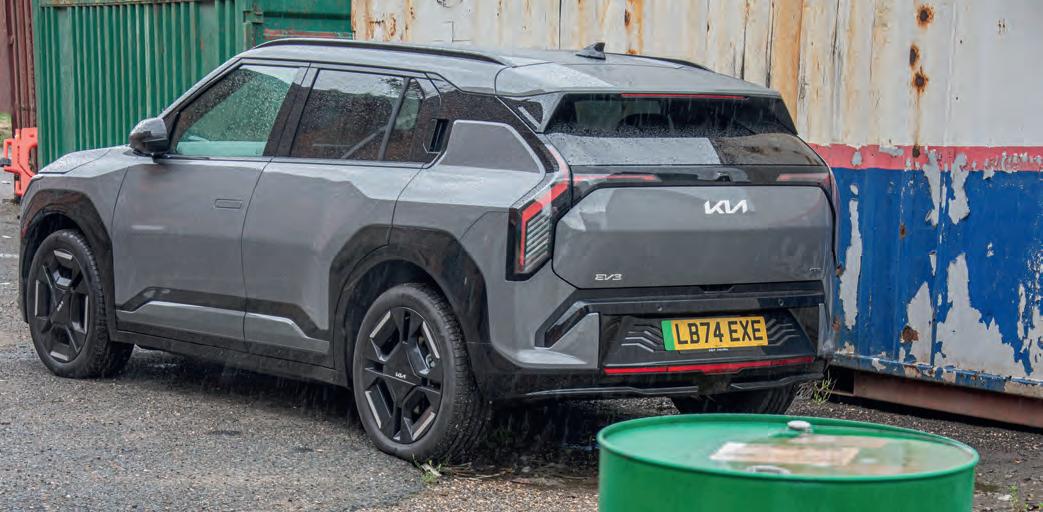




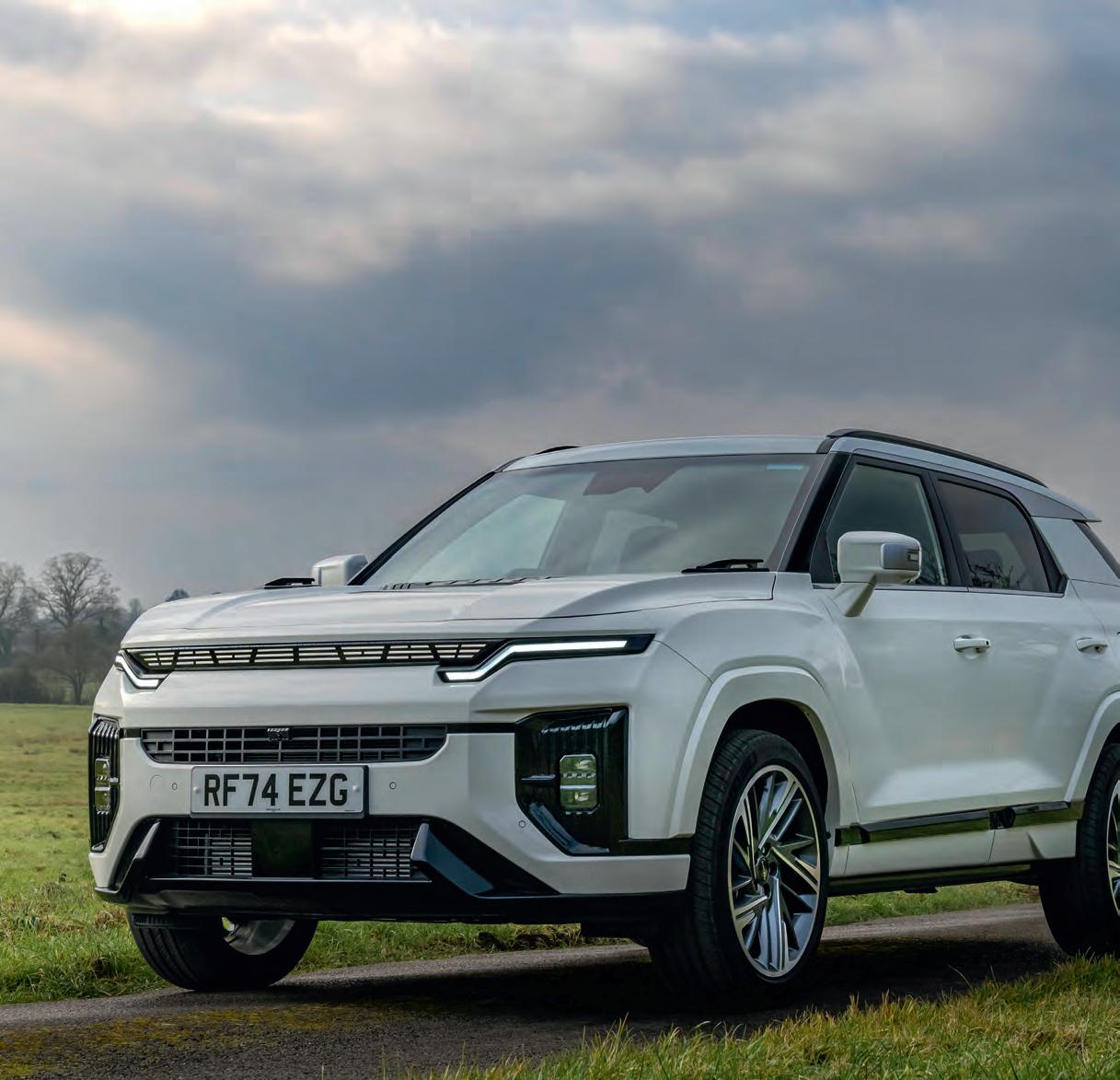
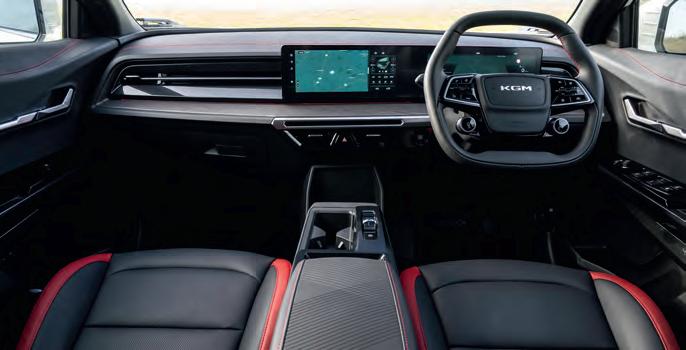

As I write this, I’m waiting to see whether a fixed penalty notice comes through the door. Or, worse, a summons.
The KGM Actyon has navigation built in. It doesn’t have wireless CarPlay, however, which (my fault for assuming it would) meant we were relying on the vehicle’s own TomTom system to get us from Quaint Yorkshire Village A to Quaint Yorkshire Village B. No problem, it said, I’ll have you there in 10 minutes – then took us up a long, narrow road which eventually turned into a gravel track.



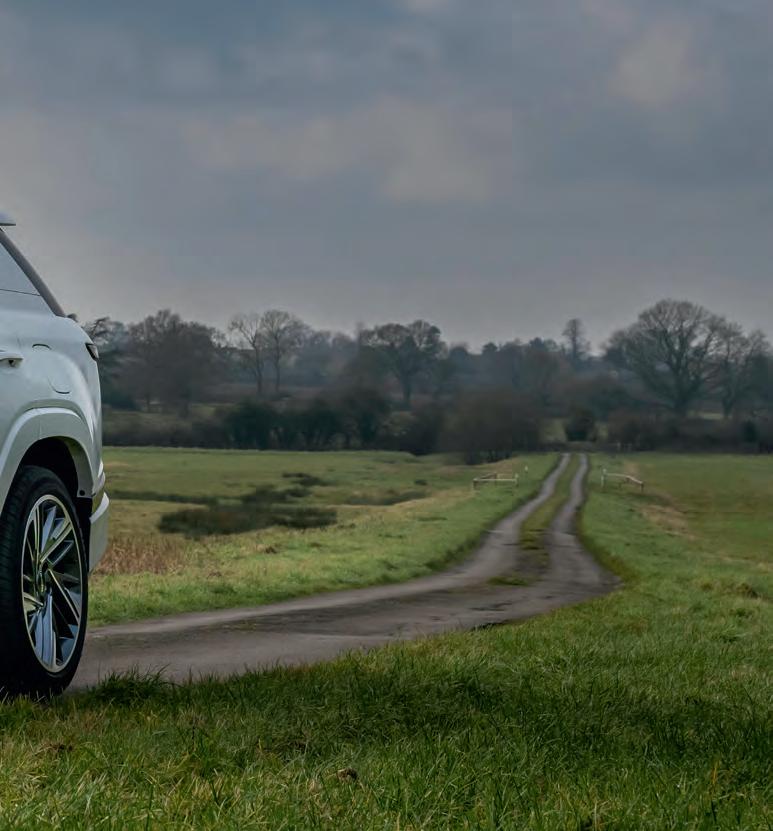
I like gravel tracks, though taking on the uncharted variety in an SUV with only frontwheel drive is a leap of faith. I mean, the route was lit up on the screen in front of me, which is some sort of comfort, but we’ve all heard the stories of drivers trusting their satnav and ending up stuck. Some of us have in fact published said stories (ahem).
Now, I’ve done enough green laning to know when a trail looks like it’s going to turn bad. And the ground was bone dry, so traction wasn’t going to be an issue. It’s never, ever a given, though. Just as I’ve done enough laning to be able to read the
route ahead, I’ve done enough to know that sometimes you simply can’t.
Max caution, then. The track dropped steeply (enough to make me wish I had low range available) before crossing a railway into a farmyard and skirting its way up the far side of a wide valley. It became a little rougher and at times looser on top, and I was definitely on high alert the entire way, but the Actyon dealt with it just fine.
Hopefully that’s the only sense in which I’ll be using the word ‘fine’ when I tell this story in future, though. Because when we reached the end of the ‘road’ we’d been
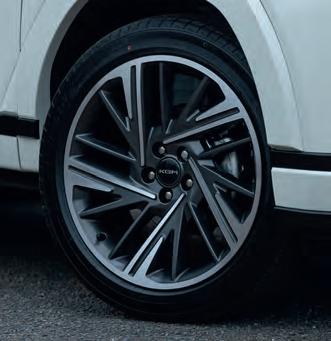
Tyres are from Michelin, and it’s good to see KGM using a premium supplier for the vehicle’s rubber. They’re designed to cancel noise and they do that pretty well, though they certainly weren’t made for when the tarmac runs out
The Actyon’s cabin (opposite page) never feels as dark as its trim materials should make it. It feels well put together and it’s very generously equipped
taken down, a sign told us that it was in fact a big fat bridleway – a fact that was confirmed later when I checked on a map.
I would argue that I was just following the sat-nav, that the nature of roads round there meant I wasn’t doing so blindly and that after that first steep descent, it was safer to push on to the end of the lane than to turn round. And of course that I was driving slowly, sticking to the route and closing the many gates we came to. But ultimately, we shouldn’t have been there and the buck stops with the driver.
Still, at least I know now that the Actyon is at home on everyday and at times moderately rough green lanes. I’d have baled early had the ground been even slightly wet but, without having to worry about only being on 245/45R20 road tyres, the vehicle’s natural tractability and adequate ground clearance made short work of the terrain.
Those tyres weren’t made to claw their way through mud, but they matter because they demonstrate how seriously KGM is taking the Actyon. They’re Michelins, for starters, which is a welcome step up from the budget brands we’ve seen on some of the company’s models, and they’re designed to subdue road noise.
The vehicle also has laminated front door glass and extensive sound deadening,
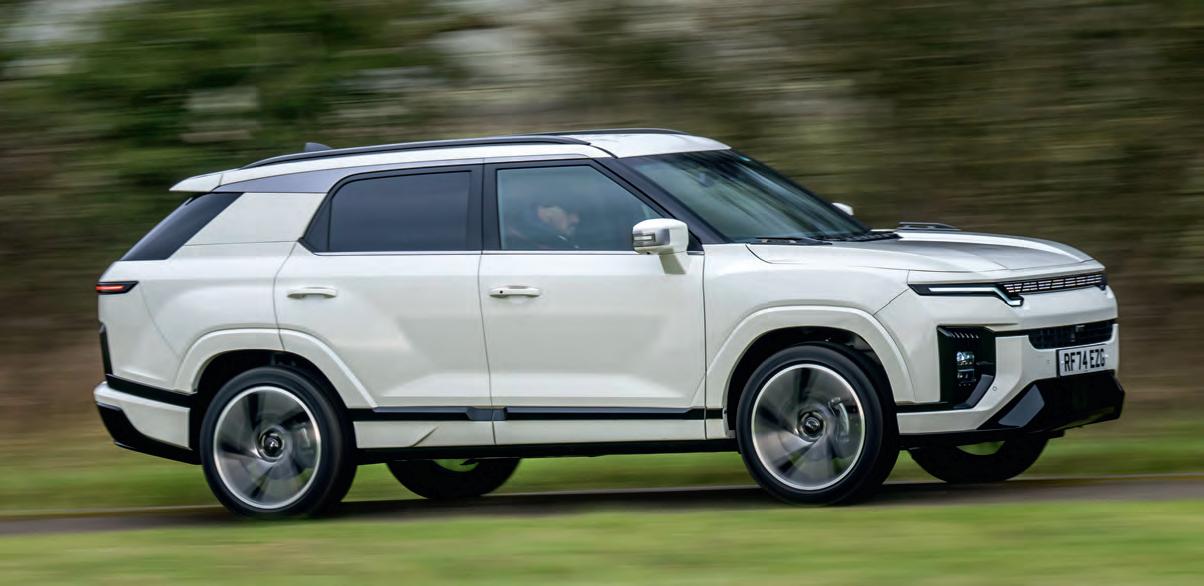
so they’ve gone for it on the refinement front. It’s a peaceful way to get about town as a result, and refined enough on the motorway too, though its ride is never quite as settled as we’d like. It’s fussy on broken surfaces around town and find the imperfections when you’re out on the open road; it’s not full-on harsh but when you set out hoping for a relaxed journey it does tend to be a bit demoralising.
Putting your foot down doesn’t produce a bucket of cold water, however. The Actyon is available only with a 1.5-litre petrol engine, whose 163bhp and 206lbf.ft gets the job done without asking either its gearbox or your ears to die for the cause. An average of 28.1mpg, though, ouch.
We have to balance that very poor economy figure (the official number is 33.1mpg, and even that stacks up badly next to comparable engines in similarly sized SUVs from other manufacturers) against a purchase price of £36,995. That’s a lot of car for your money however you look at it – and the single spec level on offer in the UK includes everything the factory has to offer. Not wireless phone pairing, as we mentioned up top, which seems like a bit of a basic omission these days, but the spec list is still pretty huge.
So too is the assortment of squeaks, beeps, bongs, twiddly-boop-bahs and diddlewhee-lulus you get assaulted with when you get in, switch on, switch off and do
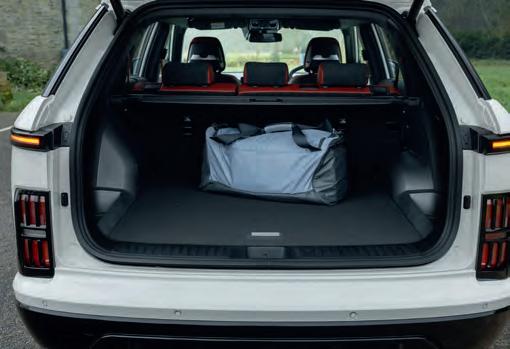
more or less anything else in between. It’s comical at times (the bye-bye music sounds for all the world like something from a Christmas movie) but downright infuriating at others; there are occasions when the warning sounds for traffic signs, white lines, oncoming cameras and so on are actually piling up on top of each other.
This is largely due to EU-led safety legislation (does a non-stop aural assault make cars safer: discuss), so it’s not KGM’s fault as such, but the industry’s job now is to prevent these requirements from making its products unusably distracting to drive and some manufacturers are doing a much better job of it. It would be a genuine dealbreaker for us.
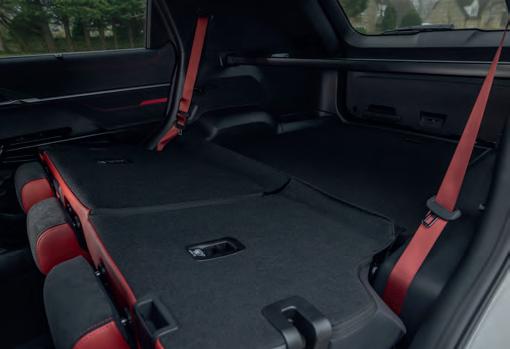
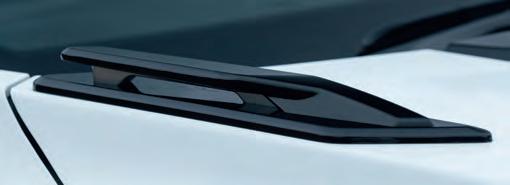
This is a shame, because you’re actually getting a comfy, classy and thoroughly practical interior here. There aren’t any options in terms of trim colour but although it’s dark it doesn’t feel sombre.
A big, wide curved glass screen containing a pair of 12.3” displays (a virtual dashboard and to its left an infotainment module) goes a long way to ensuring this. It’s bright and crisp, though the latter is a touch screen and it needed to respond much more quickly to inputs. When you tap and nothing happens for so long that you tap again, just as it finally gets the idea and now you’ve gone and given it an input you didn’t mean to that’s taken you down some dark alley to God knows where, all the squeedlyboo-wop quack safety noises in the world won’t change the fact that you’re being unnecessarily distracted from what you’re supposed to be doing. Yes, once again the buck stops with the driver, as no end of
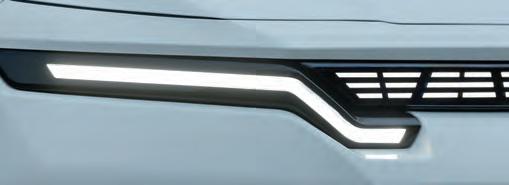
self-righteous social media jockeys would no doubt say while typing with their one free hand, but let’s be real.
You’re sitting in Nappa leather seats which are heated all round and also ventilated up front, and there’s plenty of space all round in both rows. They’re comfortable over a long distance, too, and the driving position gives you a good, commanding view of the road ahead.
We did indeed do a couple of long journeys in our Actyon, fully loaded with kids and luggage. There’s a hefty boot behind you, which will swallow everything a person could ask of it in normal circumstances, and if the circumstances become abnormal the rear seats drop very close to flat and you’ve got 1568 litres of cargo space to play with. As we said, it’s thoroughly practical, just as an SUV should be.
If you’re in the market for an SUV of this size, there’s much about the Actyon to make it worth considering. Its price is
an obvious starting point, coupled with the sheer amount of equipment you get for your money, and there’s no doubt that KGM has moved on from its early days as a motor industry laughing stock under the SsangYong name.
As regular readers will know, those days have been in the past for a long time. And the Actyon is, to a great extent, a competently executed SUV. For us, its ride quality lets it down, and there’s an indefinable air of finesse to some of its rivals which put them a step ahead of it. The less said about all those noises the better; they’re the consequence of an industry-wide illness, for sure, but on this evidence KGM has worse symptoms than most.
Still, £36,995 is a keen price for a vehicle of this size and nature. If you don’t mind the noises (or spending five minutes going through the menus and switching them all off every time you fire it up), there’s a lot going on here. And that court summons still hasn’t come through the post, so all is well.
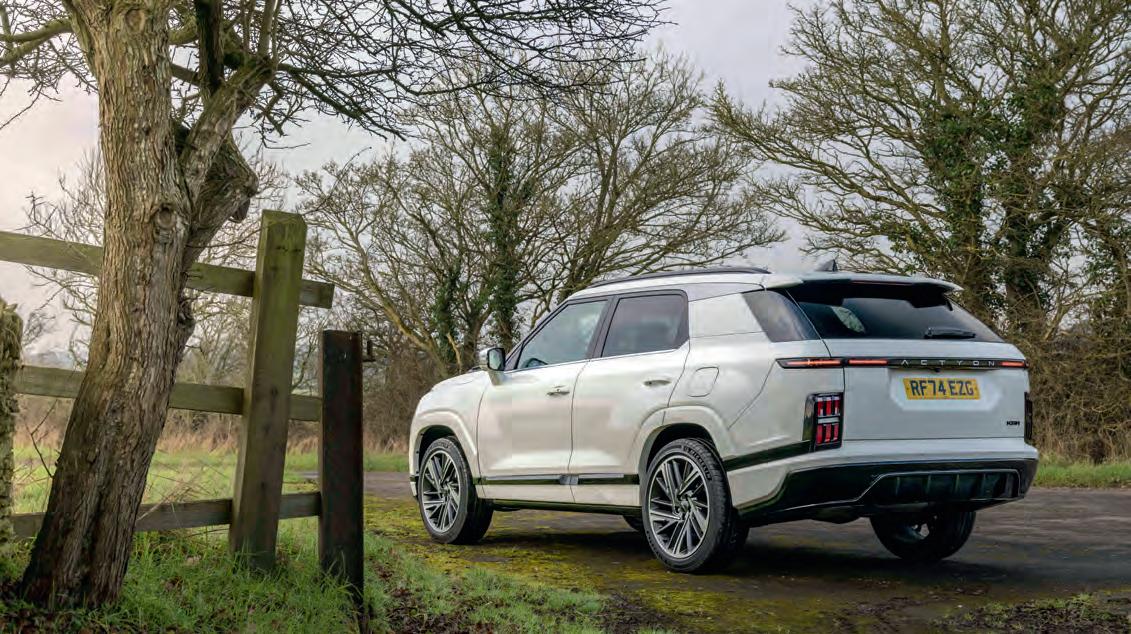












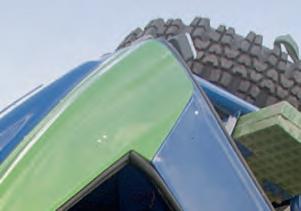

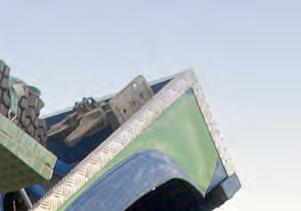




Winch competition used to be the preserve of big, heavy off-road machines. As with every form of motorsport, however, it quickly moved towards lightweight, purpose-built specials. This Tomcat was one of the first




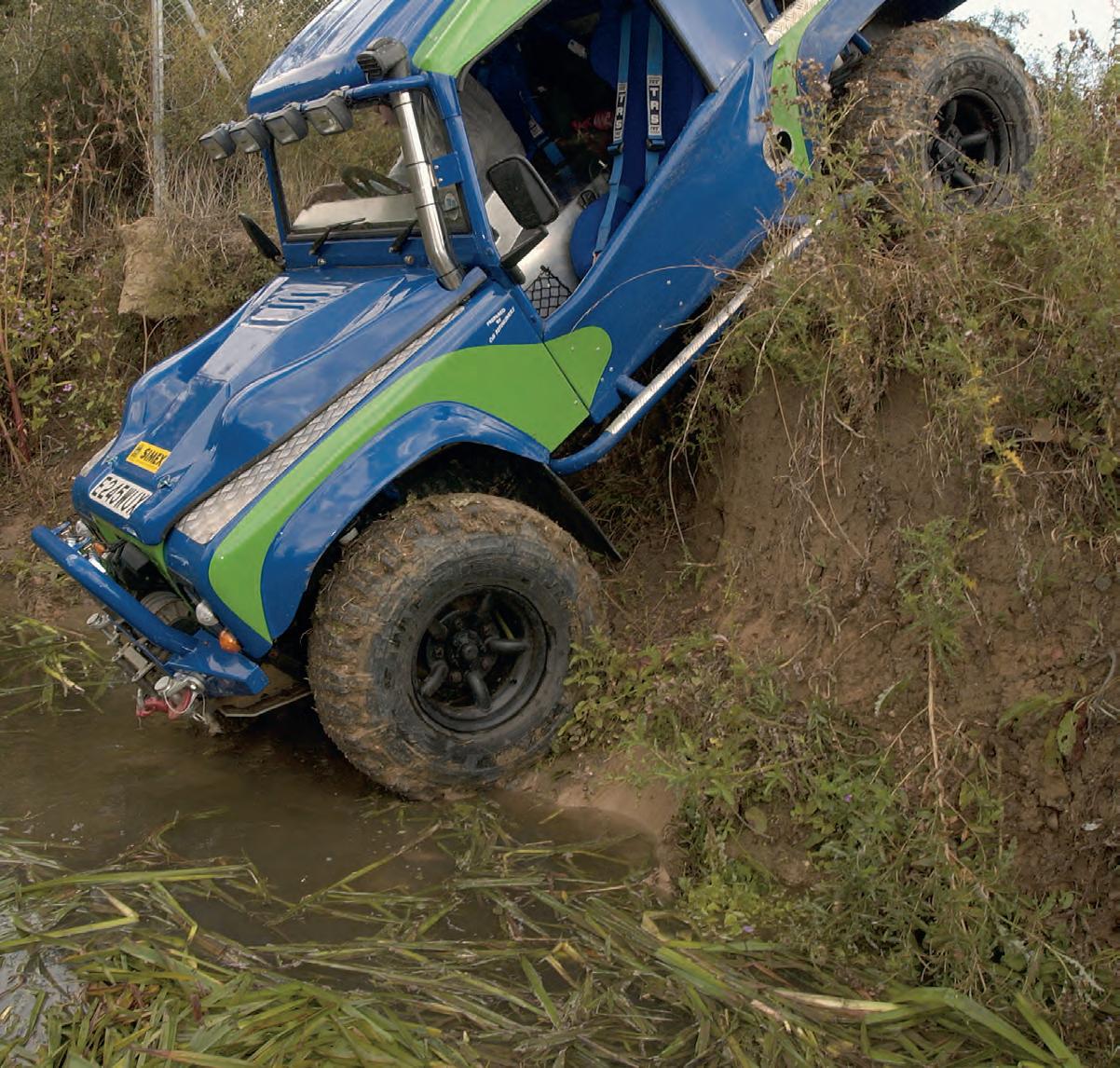

The winching game these days is dominated by spaceframe specials designed not just to cover outrageously extreme terrain but to do it quickly. Where once the top exponents of the sport would start with an everyday vehicle – a 90, Range Rover, Land Cruiser, G-Wagen, Jimny or Wrangler – and add a cage, steel bumpers, big suspension, one or more winches and so on, these days they start with a CAD package and the sort of money you hope one day to be able to spend on a house.
The build we’ve just described there actually sounds like the spec you might draw up for a green lane wagon to reckon with. And it’s been said that that’s where the original challenge events first came from – people wanting to do something competitive in their playday and lane trucks. It’s similar to the way trialling started off with farmers meeting up on each other’s land to compete in their Series Is, Champs and Willys Jeeps, then as time went on some of them started to improve their vehicles, then later those vehicles turned out to be more fun at higher speeds and a couple of decades later the top end of the comp safari game was locked out by
what are basically Group B rally cars with longer springs.
In every case, a theme in the sport’s progression has been the quest for lighter weight. The original triallers, compers and winch motors were everyday 4x4s that had been hacked about into something else; inevitably, they stood little chance once they were up against purpose-built competition cars.
The vehicle in this feature was a purpose built competition car. It wasn’t actually built for the purpose it ended up being put to but not to worry – the light weight built into it still served it well. And it was one of the very purpose built cars in the winching scene.
The Tomcat was originally developed by the late Drew Bowler as a vehicle that could be used for trialling and, in particular, comping. He built plenty of them, mainly in kit form, before selling that part of his business in the late 1990s to concentrate on his new Wildcat racecar. This went on to become hugely successful, while the Tomcat – now under new ownership –developed into a range of specials suited to every kind of off-road competition.
But by then perhaps the die had already been cast. Back in the very early days of
winch events, a round of the 1994 Warn Challenge at Red Dragon Off-Road in South Wales was won by a couple of lads called Dave Wallis and Richard Scourfield – who didn’t even have a winch. They showed up in an early Bowler 88 and, over the course of two days, Dave simply drove the entire course while Richard spent most of his time out of the vehicle rigging recoveries for everybody else.
Fast forward a decade and Chris Ould was forging ahead with a plan to do something similar. ‘I harboured an ambition to build one for some time,’ he told us. ‘When I thought about it, I realised it could be just the vehicle to make a real impact on the challenge scene.’ The logic is plain to see. Chris’ vehicle weighed in at about 1600kg – and that’s with a winch at either end. His 90 in similar guise was getting on for two tonnes, until Chris used it as a donor for his new motor.
The vehicle came to Chris in kit form, with a full chassis and cage as well as a set of body panels. The latter needed cutting down to fit Chris’ own design and he, along with his friend Barry Thomas, spent a lot of
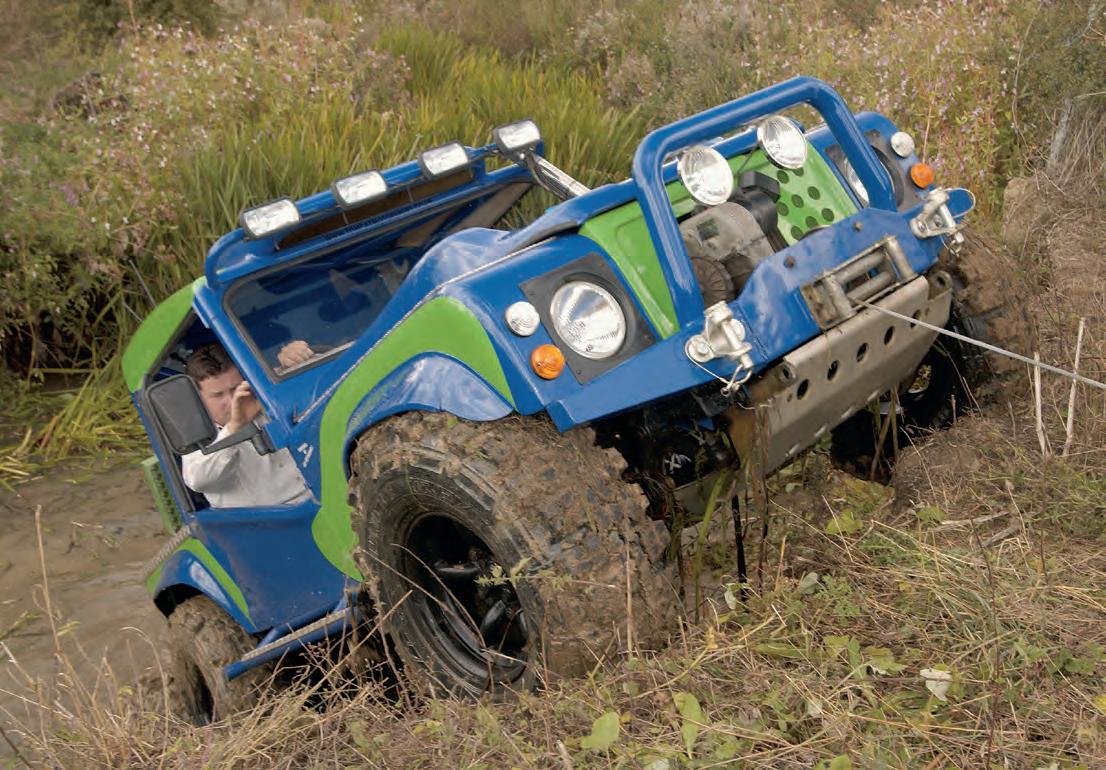
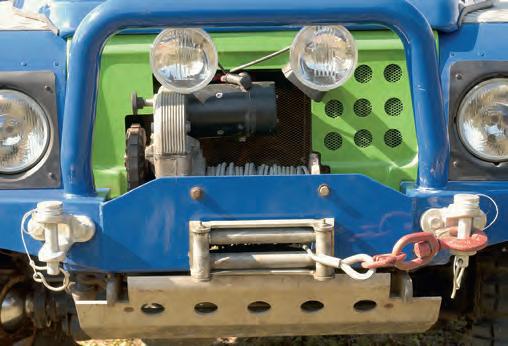
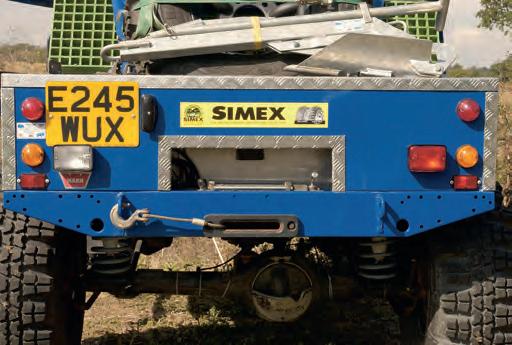
It’s a winch motor and here they are – a Warn 8274 up front and the same company’s M8000 at the back. These were the days when it was normal to compete on standard out-of-the-box winches. Both were wound with steel cable – these were also the days when there was still a debate over whether or not to use the synthetic rope that’s long since completely taken over
time getting them just right. ‘It was a very labour-intensive job,’ explains Barry. ‘We wanted to make sure the build was tidy from the start, so we decided it was worth taking the time.’
How much time would that be? Try every evening and weekend for a two-month period at Chris’ workshop. Add to that the time Chris himself spent, which included a three-week spell off work devoted entirely to the project, and you’re looking at a pretty serious commitment.
We mentioned that his old 90 yielded lots of bits for the Tomcat. These included ARB locking diffs in both axles as well as the tyres at the ends of them, a set of 34x11.50R15 Simex Jungle Trekker IIs on Matt Lee rims.
This alone dates the story back to the early days of special builds in the world of winching. Everyone was using Simexes back then, but they fell victim to EU-wide protectionist (sorry, ‘environmental’) legislation a decade or so ago and now

every time you see a tyre with the same sort of tread pattern it’s a copycat remould.
The axles, since we were on the subject, came from a 300Tdi Discovery. The props turning them were taken from a Range Rover and modified to suit the vehicle’s wheelbase and the position of its engine. This in turn is a 300Tdi Land Rover unit, mated to its original-equipment R380 transmission and standard transfer case, but for ideal weight distribution Chris wanted to mount it as far back as possible. ‘This helps balance the the vehicle,’ he explained, ‘which is essential because of its lightness compared to a standard Land Rover.’ Discovery discs and calipers provide stopping power and, being stock parts, are easy to replace.
It’s all good, familiar stuff here and while the suspension wasn’t standard it was commonplace, Pro-Comp long-travel shocks being paired with Tomcat’s own extended coil springs. ‘There’s nothing too fancy about it,’ Chris told us. ‘It doesn’t dislocate or anything. I just wanted to maximise travel while maintaining strength and reliability.’ If you’ve heard of the KISS principle, you’ve just heard of it again.
There’s also a KILT principle, where L stands for ‘light’ and you can decide for yourself what the T stands for. And not only does less weight equal more chance of not getting stuck, it means less strain on your driveline. Chris’ Tomcat ran standard Land Rover halfshafts and he admitted to not even bothering to carry spares when he was competing. It was still pretty freshly out when we met him but he’d done a few
events with no breakages, and when you consider the shock loads you get from such savagely aggressive tyres that’s saying something for the value of light weight. For comparison, our editor talks of the time, way back in the day, when his then brand new 300Tdi Defender 90 van blew a CV joint while it was parked.
An interesting counterpoint to the weight-saving theme, and an illustration of how long ago this was, is that the Tomcat’s winch bumper (designed by Chris himself) housed a simple Warn 8274, with a Warn M8000 at the back. A pair of Optima YellowTops kept them alive and, here’s the kicker, both were wound with steel cable.
Chris admitted that synthetic rope was beyond his budget at the time but also that he wasn’t totally convinced about its strength. This was an era when it was still pretty new on the scene and there was plenty of debate about it, fuelled by no end of rumour, counted-rumour, fact, fiction and at least one lawsuit. These days, you go years without seeing a steel cable, which pretty much settles the question of where that debate ended.
Chris’ view was that he didn’t really need to worry about the heavier weight of all that steel, since he had such a light vehicle to begin with. Obviously this set-up puts a higher proportion of the vehicle’s weight beyond the axle lines where you least want it, but in absolute terms he’s not wrong.
And anyway, with those Air-Lockers keeping the Simexes clawing away at the ground, he figured that the Tomcat should be less likely to get bogged than heavier production vehicles. Which is sound
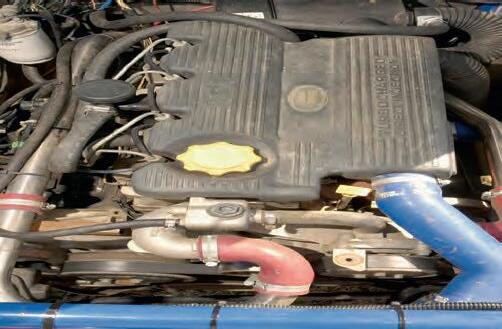
thinking, though of course as time went on more and more competitors thought it too and event organisers had to respond, the result being that the terrain in winch challenges is now many times more extreme than it used to be.
Which is of course the way it goes in motorsport. Those old farmers in their
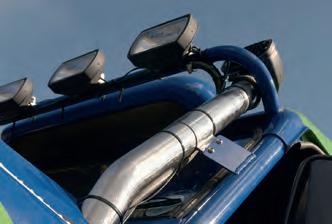
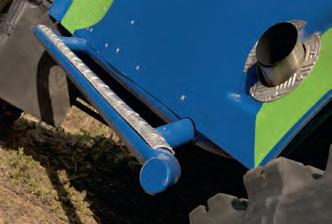
An unmolested Land Rover 300Tdi engine mated to its original R380 gearbox and LT230 transfer case is about as standard a drivetrain as you’ll find, though in this case it was all mounted as far back as possible to aid weight distribution – something Chris felt was more important than ever given the vehicle’s lower overall mass. The engine breathed in through a slightly modified Southdown snorkel and out through a side-exit exhaust. Note the hoop on the roll cage to protect the top of the snorkel from being leant up against trees and the highgrip chequer plating on the nerf bar to help Chris’ winch man jump back in without going for a big old stack in the mud
early Land Rovers, ex-military Jeeps and so on wouldn’t have believed how advanced and complicated the triallers of the future would become, and neither would the early comp safari racers in their caged-up Series IIs. By the time winch challenges were invented, perhaps it was obvious where the sport’s success was going to take it.
When Dave and Richard tore up the Warn Challenge down in Wales, they were simply showing everybody what they already knew – and by turning a Tomcat racer into a vehicle designed to win trophies at much lower speeds, Chris was simply putting the challenge scene on the diet it’s been following ever since.
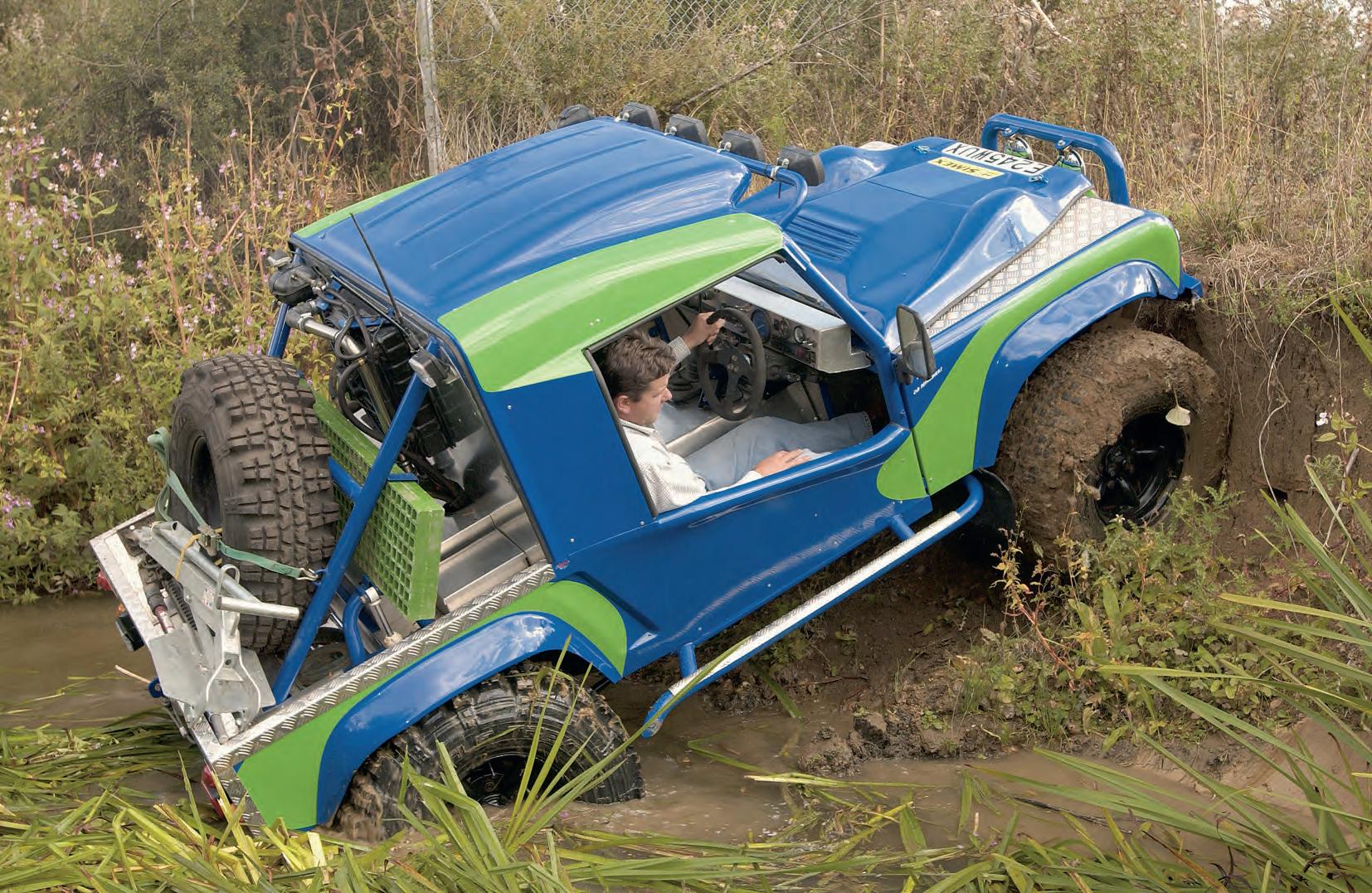



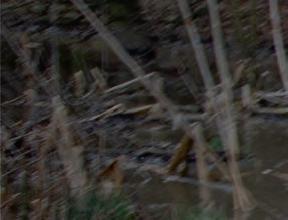



The
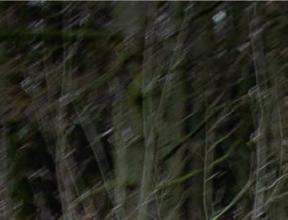
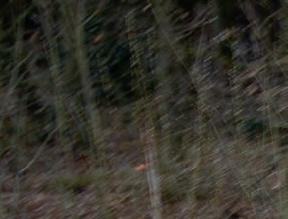

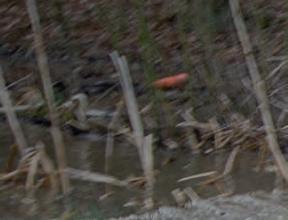
back of Steve Taylor’s Land Rover Discovery
appears to be missing, but there’s no need to panic. He’s not mad, see: just eccentric…









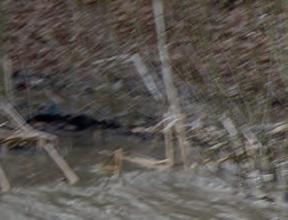
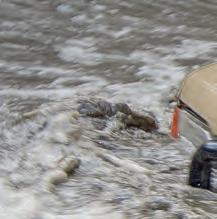


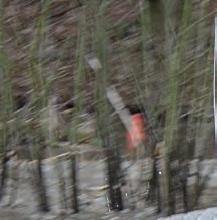




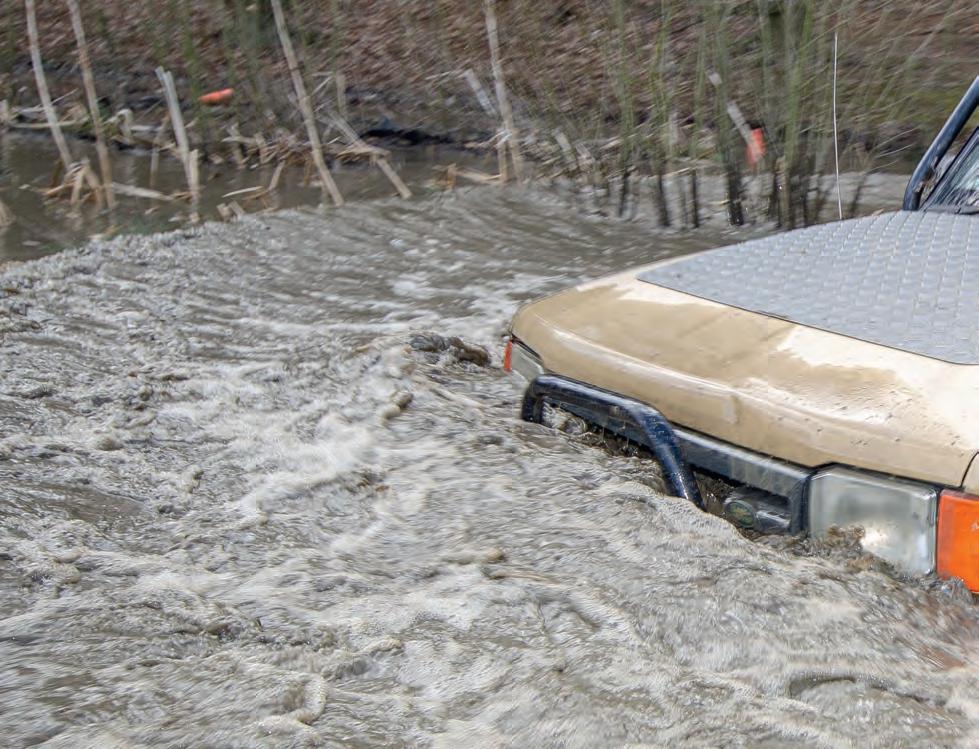
eople who do regular night shifts are pretty used to being pulled over by the police on their way to and from work. If you drive about a lot when most law abiding people are in bed (and most ne’er do wells are going about their villainous deeds), you’re going to get a lot of attention. It’s reassuring, in a strange kind of way, even if it gives you the raging hump at the time.
These days, Steve Taylor mainly just thinks it’s funny. Running the staff canteen for a major industrial employer means he’s basically nocturnal, so the cops round

his way see plenty of him on the road at funny times of night. And the truck they see him in is an eyeball-grabber all the way around the clock, let alone in the wee small hours.
The Land Rover Discovery (rems of) you’re looking at here is one of many vehicles to have graced his… well, his front garden. ‘It’s a car park,’ he explains, before correcting himself and pointing out that there are bikes in it too. ‘I like to be a bit different,’ he admits. ‘People start off thinking I’m mad, but then they realise I’m just eccentric!’

Does driving to work every day in an 82” Discovery trayback count as mad or eccentric, then? Discuss. But Steve also owns a modified Suzuki X90, and earlier this year he did a round-trip of about 600 miles in it to pick up the latest bike he’d bought. Through blizzards and then deep floods, if you don’t mind (‘my trailer was completely underwater at one point’), and straight off the back of a night’s work, meaning he hadn’t slept in 24 hours by the time he got home. Compared to that, smoking around in the remaining 82% of a Disco actually seems like quite normal behaviour.

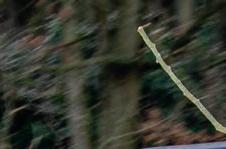




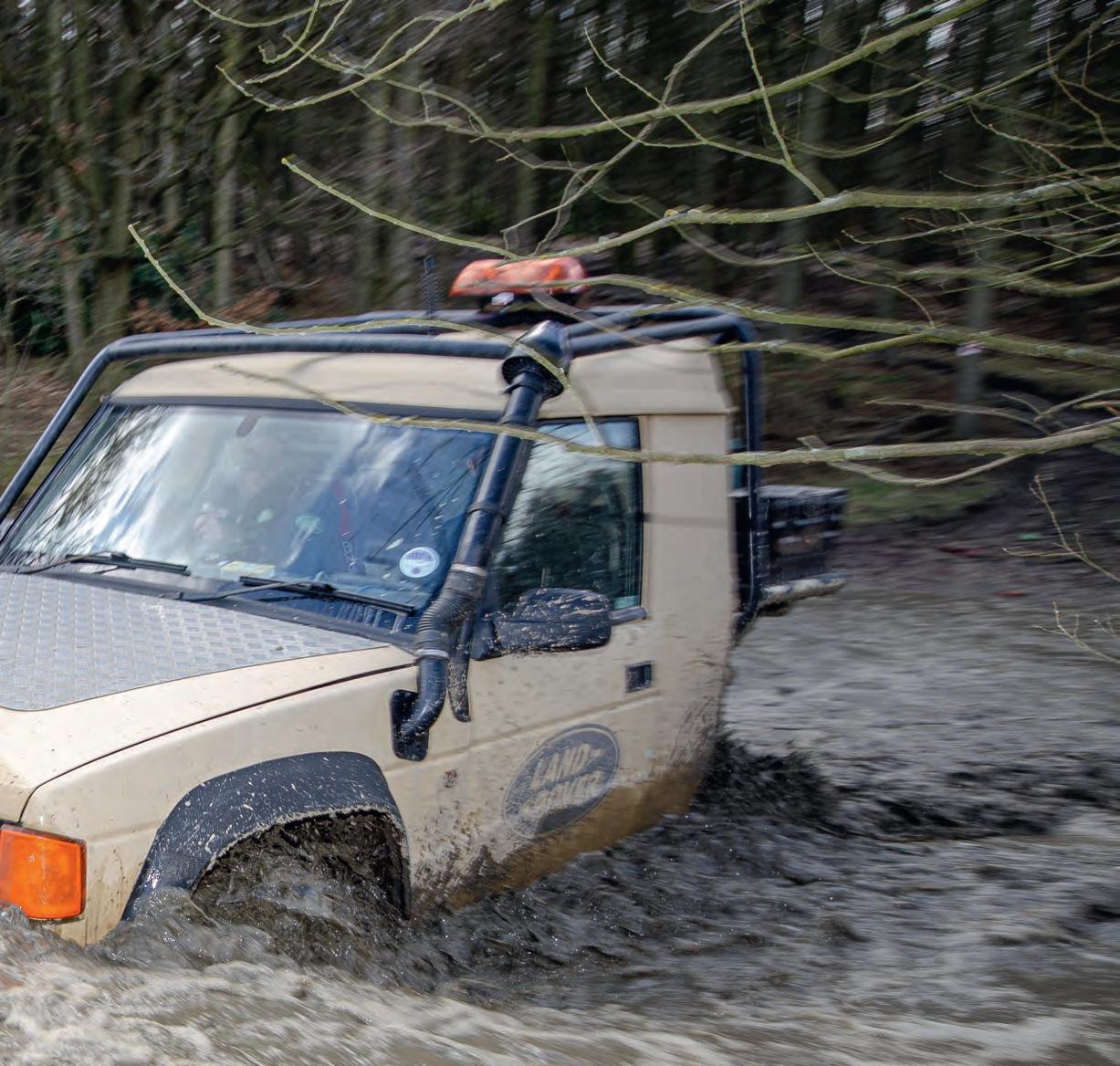
Not that this is just the world’s least appropriate commuter car, of course. You don’t take a gas axe to a Disco without reason, and by the time Steve bought it he’d been off-roading for 15 years.
You can own a lot of trucks in that time, which is just what he did. ‘You name it,’ he says. ‘Lada Nivas, SJs, Nissan Patrols, all kinds of Discos, Series IIIs… Always lifted, most with winches, some with cages.’
It was one of those Discos that paved the way for the trayback, in the shape of a lifted (natch) TD5. Steve did the same as most people who have one of these

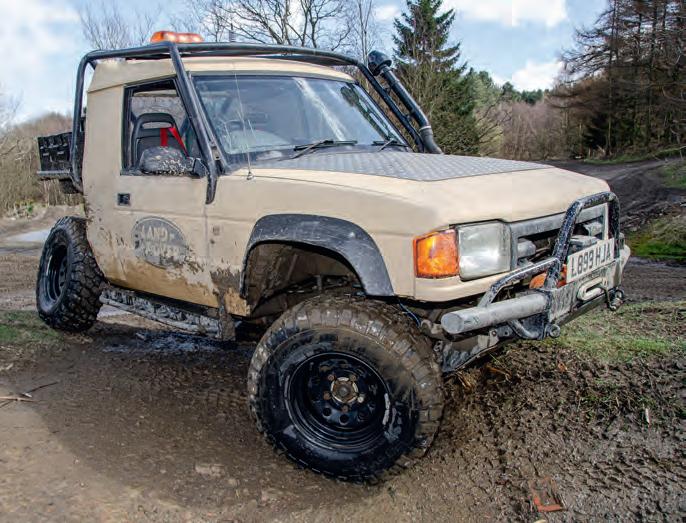


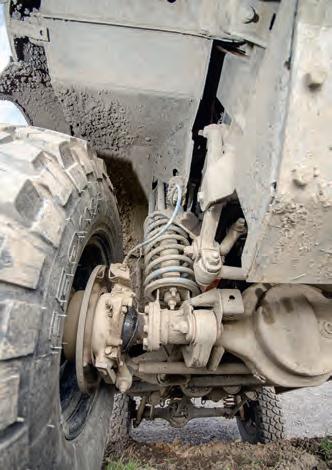
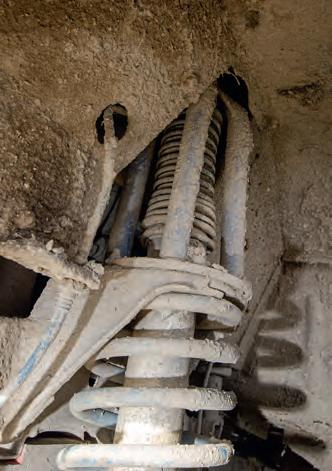
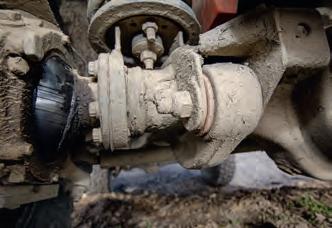
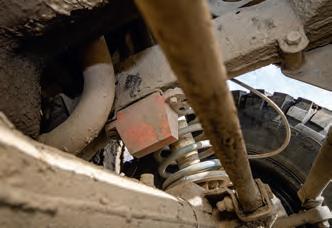
Left: Axles? Standard. Brakes? Standard. Suspension? Well, almost. Springs are a basic set of +2” jobs with enough about them to hold up the extra weight of the bumper, winch and front guard while still flexing like crazy
Above left: The axle is standard, but the radius arms holding it in place are castor-corrected and, as you can just about make out here, bushed with polyurethane
Above right: A little lift and a lot of articulation can mean all sorts of things, most of them good. To prevent one of the other kind happening, a set of extended poly bumps replaces the original items
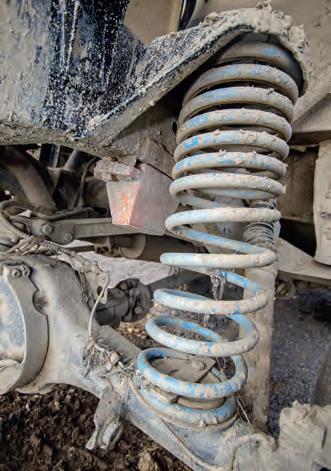
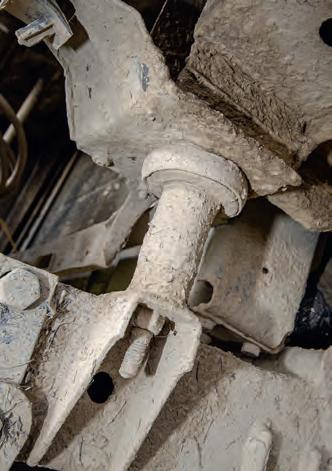
Left: The Disco’s shocks are ‘basic,’ to quote Steve. Be that as it may, they can still flex with the best of ‘em, aided by the tubular top mounts they call home
Centre: Rear springs are variable-rate units with captive mounts and no dislocation. The springs’ and shocks’ mounting positions are standard, as is the hardware locating the axle, though once again there’s a nice set of poly bump stops for when there’s, er, bump to stop
Right: With so many suspension options available, it’s comparatively rare to see body lifts on Land Rover products. A simple set of tubular mounts puts more space below the arches, however, making further room for the 35” tyres
but don’t want to be driven insane, and replaced the rear air springs with coils, but despite this he was forever catching the rear overhang on drop-offs. Says something about the sort of drop-offs, you might say. ‘I do like to go a bit extreme,’ he admits. ‘I’m getting worse as I get older!’
Something else he’s happy to confess to is letting other people do the tricky stuff in the
workshop. Describing himself as a ‘cabbage mechanic,’ he’s as practically minded as the next man but his skills were learned in the kitchen and when it comes to his hobby, he’s happy just to drive – and winch, too, you’d have to assume, because when we met him he was in the middle of a marshalling shift at Tong.
Talking of winches, that’s one of the things Steve added after buying the Disco. It had been built by a chap who needed to
raise a bit of cash to pay for his wedding, which sounds like the sort of story that could end one of two ways.
‘It was basically complete,’ he says. ‘It just needed things like a snorkel and winch, then we added the lights, ammo boxes and jerry cans and got it MOT’d. I do the basic spannering myself, but my mate Ian Shillitoe does the serious stuff.’
Talking of basic spannering, what’s in the regular maintenance regime? ‘Bearings
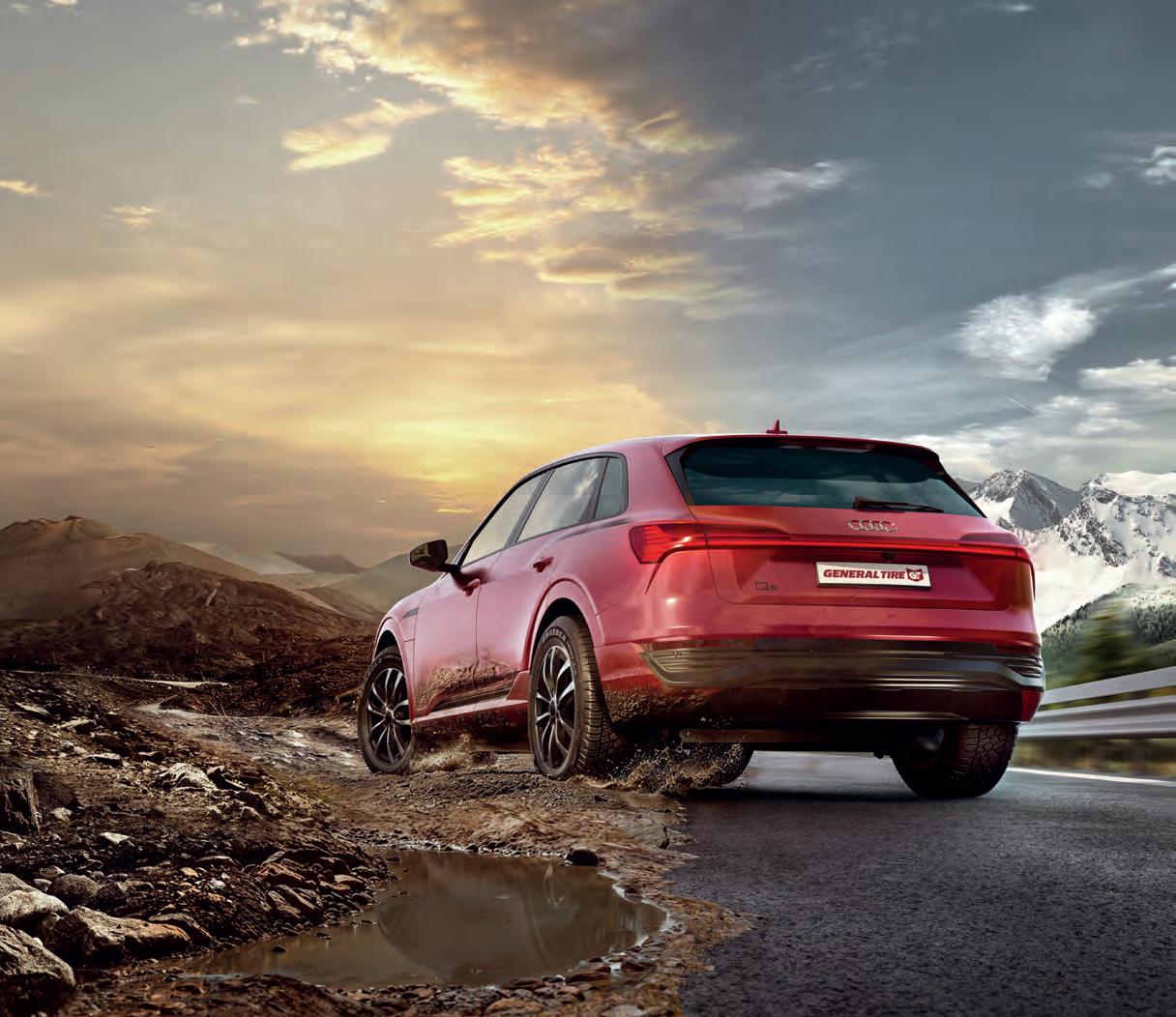




DISCOVER NEW HORIZONS AND BE READY FOR WHATEVER COMES YOUR WAY!
The GRABBER CROSS A/S is a mild all-terrain tyre designed to offer a balanced blend of on-road comfort and light off-road capability, making it ideal for SUV and Crossover drivers who need versatility without sacrificing everyday drivability in all seasons! Experience a new level of confidence and control as you embrace every journey, no matter if you are driving on smooth highways or conquering tough trails.
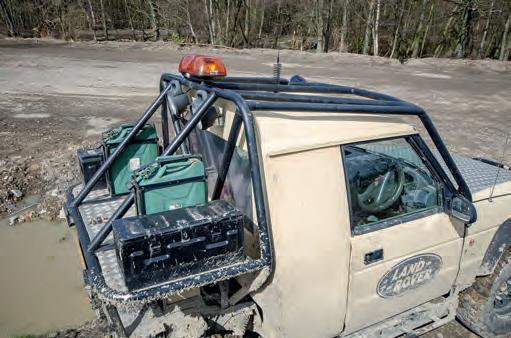
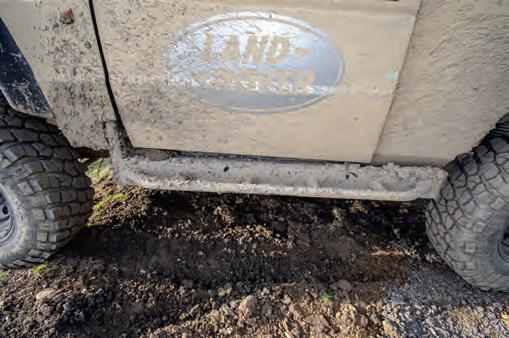
Left: Just what you want when you do your wheeling in the woods: minimal bodywork and maximum protection. The Disco’s body was cut down into an extended cab to provide plenty of room for two people, then a comprehensive six-point cage and tray structure was woven around it
Right: Rock and tree sliders start where the front mount for the roll cage emerges from the bottom of the wing. Seen here, your first guess might be that they were designed for a shorter-wheelbase Land Rover, but then you’d remember how short this one is…
and brake pads, obviously. And the rubber doughnut on the rear prop. But to me, that’s just running costs on a truck like this. Oh, I tend to replace a lot of indicator lenses, too!’
The 300Tdi engine gets a service every three months, with the result that Steve can still commend it for its strength rather than regretting the day he decided to go to the
pub rather than getting his hands oily. Behind it is a standard R380 gearbox, though he’d like to replace this with an auto. ‘It’s always in the right gear for off-roading,’ he says. ‘As I’m getting older, I’m getting lazier!’
Talking of gearing, here’s an interesting one. The Disco was rolling on 35x12.50s when Steve bought it, but he’s replaced them
with 10.50s. ‘Losing two and a half inches on the width of the tyres has improved the driving,’ he says. ‘The gearing is a lot better.’ Gnarly rubber
Eh? Now, we too thought that gearing comes from tyre height, not width. But listen to the man: it drives better. All we can
Below right: Steve admits to not knowing whether the winch bumper was built or bought. Either way, buying another one is a thing he’ll never have to do. The same can be said of the steel guard below it
Bottom right: Steve bought a military snorkel from a mush on eBay. He and his mate Ian modified it to fit, something they’ve done with every 4x4 they’ve worked on. The wing plate looks kind of odd at the angle it ended up at, but turning it round would force the flexi section into a sharp double-bend that’d do nothing for airflow
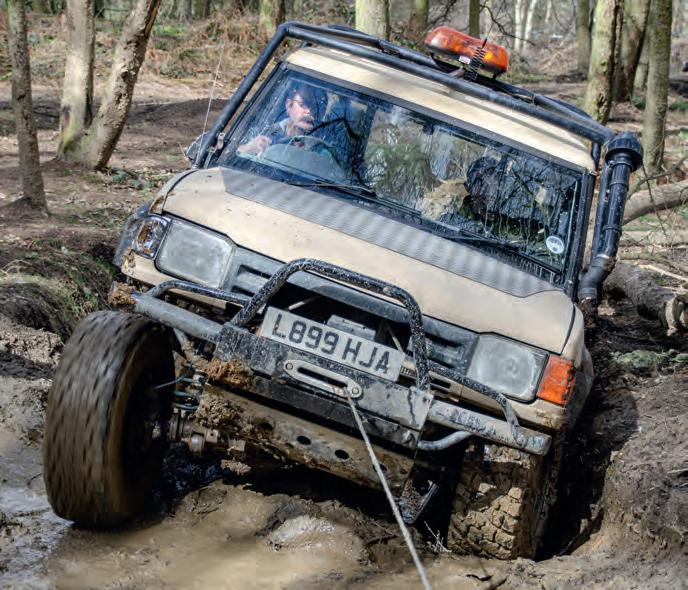
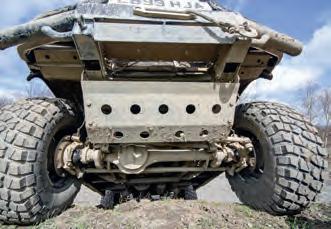
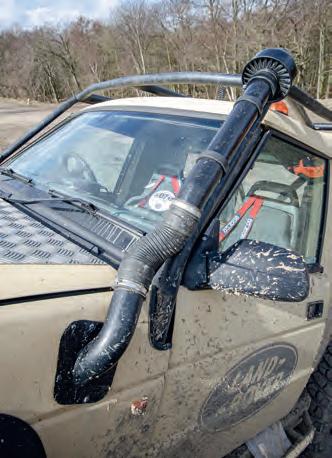
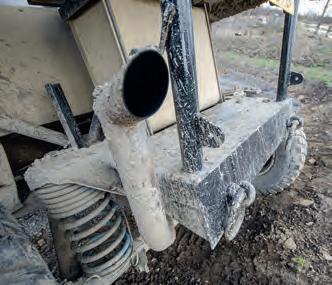
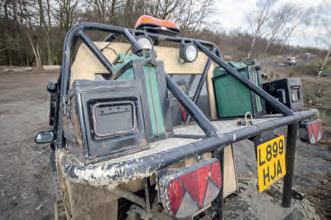
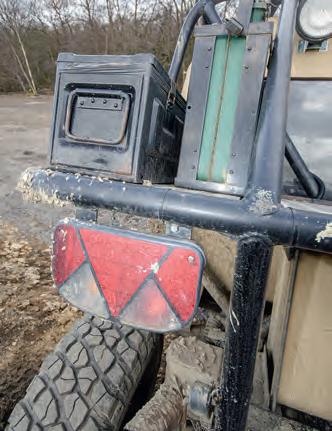
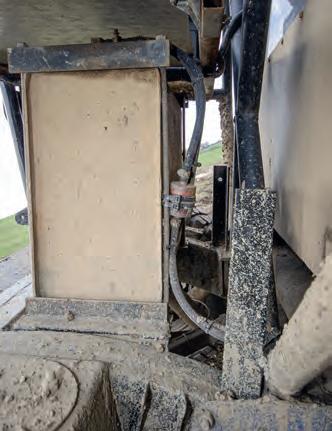
Top left: The back of the chassis has been cut down and finished off with a boxy crossmember carrying a couple of stout recovery points and the rear stays for the roll cage. Without a back body to worry about, the exhaust is run into a bit of a chimney to keep it out of harm’s way
Left: The rear tray was a blank canvas when Steve bought the truck. Since then, he’s fitted a couple of ammo boxes for his gear and a pair of cradles for his jerry cans. The centre panel is padlocked as it hinges to provide access to the filler cap
Centre: One of the things Steve did after buying the truck was to get an MOT on it. As many trayback builders have found, a set of trailer lights is the easiest way round one of the fiddlier parts of going road-legal; this is a six-function cluster from Aspock
Right: The fuel tank sits in the huge void between the tray and chassis, just behind the main hoop for the cage. Might look a bit tidier with the old mounts axed off, but it’s not as if they’re doing any harm
assume is that since the thinner tyres take less turning, the engine is able to rev more easily without the extra weight of the 12.50s (not to mention an extra 8” in total of gnarly rubber clawing at the ground), and when you consider that revving freely was never what you’d call the Tdi’s party trick, the logic does begin to stack up. Anyway, proof of the pudding and all that, and one way or the other he’s happier with tyres about him that are lean.
The original tyres were mounted on offset rims for all the usual reasons, while their replacements went on wrapped around a set of steel modulars mounted on spacers. Up front, a set of wheelarch extensions denies those friendly coppers an excuse to fire up the blues when they see him on the way to work, while at the back the width of the tray was designed to cover them just nicely.
Talking of the tray, this is part of a full six-point roll structure whose rear stays run down to it to meet vertical legs bracing the whole cage to the back of the chassis rails. These are finished off by a simple crossmember which extends no further to either side than the rails themselves, and ahead of this is a custom fuel tank mounted on a platform beneath the tray. Considering
there’s so little vehicle left, there’s a lot of space in it for stuff like this…
Fact is, Steve’s Disco is more standard than it looks. There’s nothing radical going on with its drivetrain or suspension, the winch up front is a budget effort that cost £350 including rope and, aside from the obvious body mods, it’s pretty much just a standard Discovery.
Whether that’s what he told the police first time they hauled him over on the way home from work, we don’t know. But these days, he says, they’re more likely to drop in for a cup of tea on their break. You can make up your own mind whether he’s mad driving this thing to work, or just eccentric. But it’s one hell of a talking point either way – and a bang tidy off-roader, too.
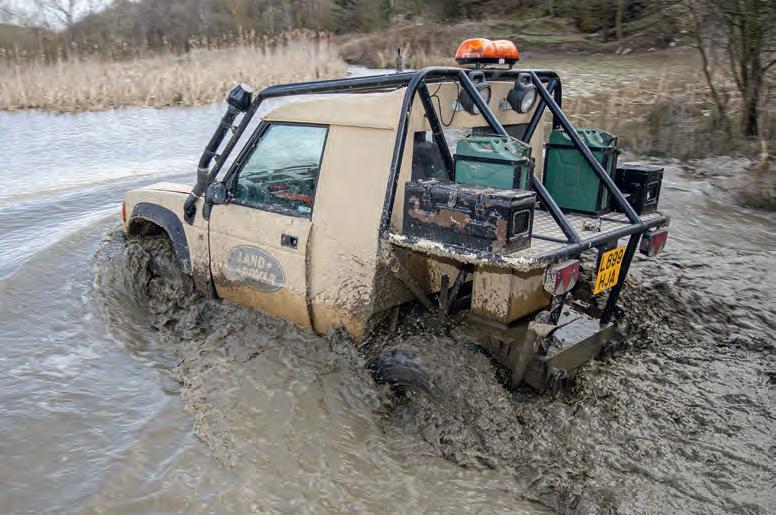








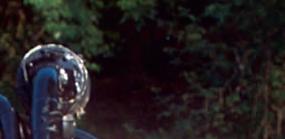




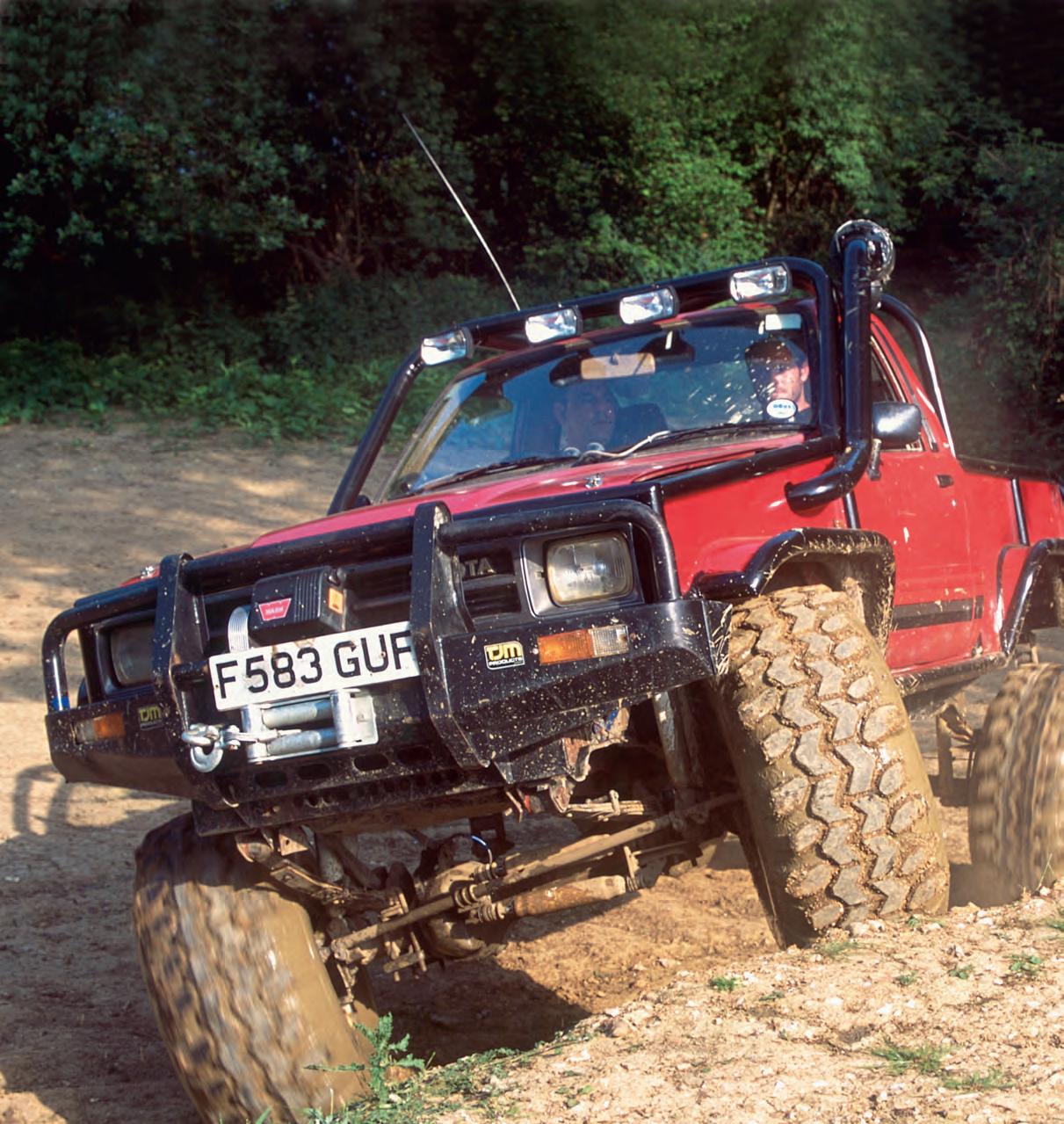

















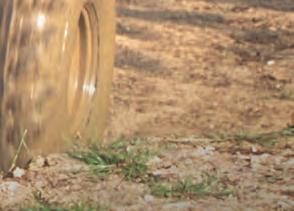





Back in the day, it was rare to see a modified pick-up. When you did, they tended not to be very subtle – but despite the way it looks, Tony Panayi’s Hilux bucked the trend

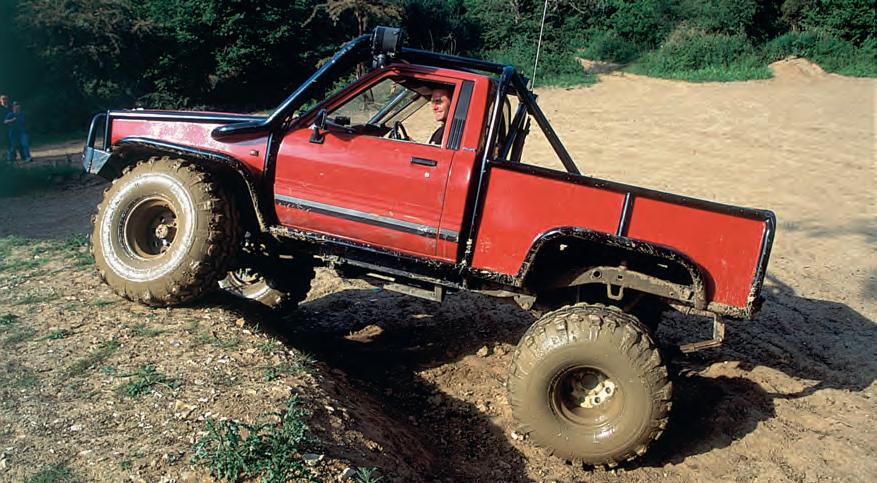





If you want to build a modified vehicle and you’re not swimming in money, these days you’re pretty likely to end up in a pick-up truck of some description.


of it and the sound of Tony’s ideas, and Tony liked Des’ reaction to both, and before long a team had formed.


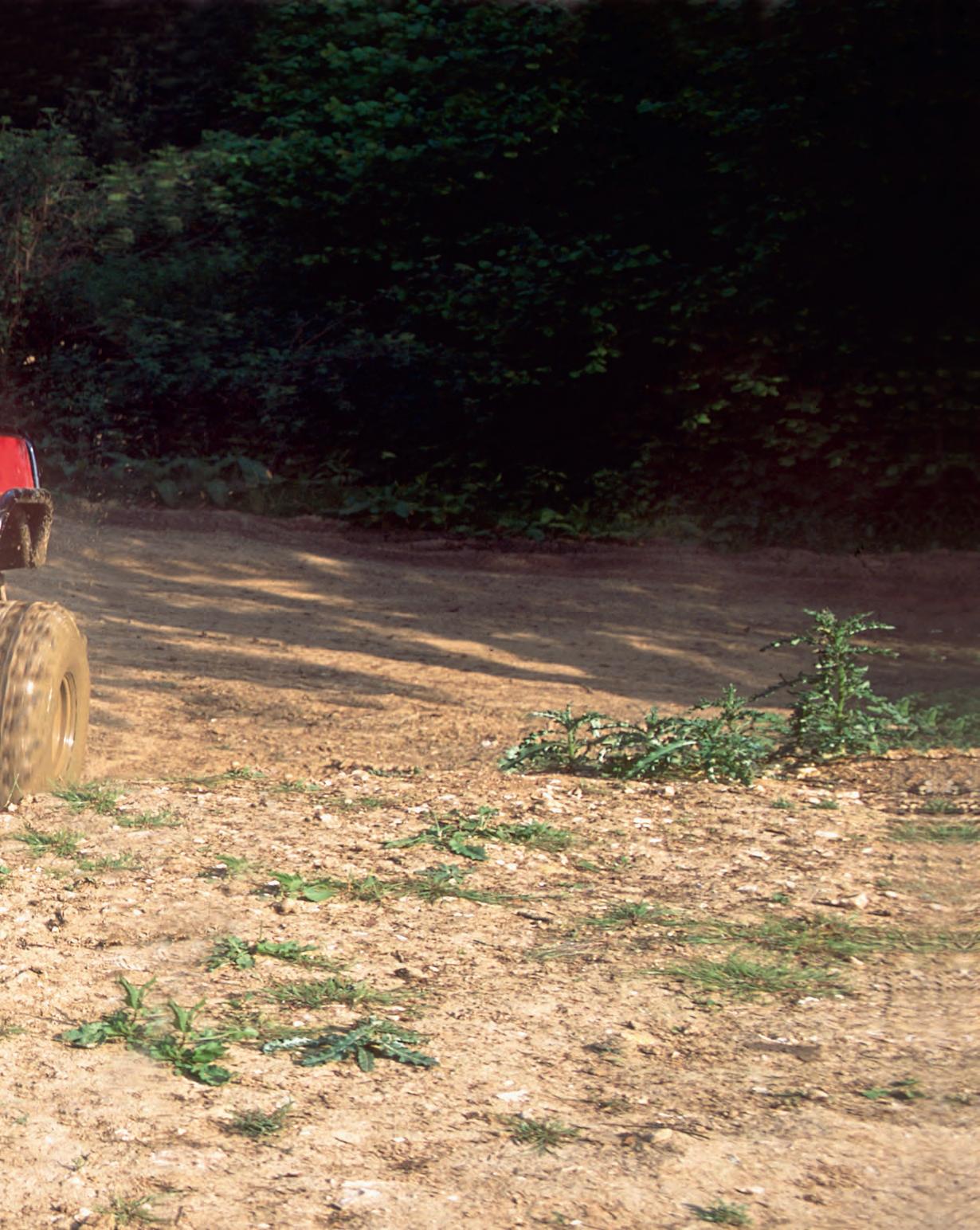


Back in the day, though, it was pretty unusual to see people off-roading them. With long wheelbases and even longer overhangs, they didn’t really lend themselves to the sort of playday-led action that was at the heart of the off-road world in the 80s and 90s.
When you did see them, they tended to be early Toyota Hiluxes. They tended to be V8-engined and they tended to be on huge tyres.



What were Tony’s ideas? Well, what you see here is how the truck looked half a decade or so later.
The Hi-Lux was actually still in full-bodied form when Tony and Des first met, and it was some time before they got down to working out how they were going to address the fact. In the interim, however, Tony pointed up the need for some trimming in a rather dramatic fashion when, having failed a hillclimb, he stuffed the truck’s tailgate into the ground.
Like this one. Its story goes all the way back to the mid-nineties, when ace mechanic Des Hitchens met its owner, Tony Panayi, at the old Thamesmead off-road site. At the time, it was running a +5” lift and 35” tyres, with a 3.5-litre Rover V8 turning them. Des liked the look


Soon, the Hi-Lux was in Des’ workshop, and not much later it was down to a bare chassis. He blew 6” off the back of the frame, which meant about 18” of overhanging bodywork. And with that, the truck’s departure angle went from achilles heel to secret weapon.







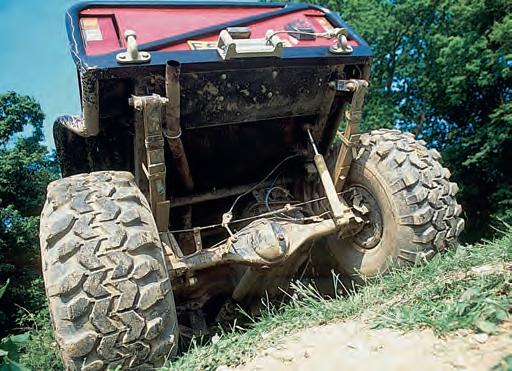
But that was just for starters. Des had convinced Tony that if he wanted to do a proper job of turning the Hi-Lux into a really serious off-roader, he was going to need a roll cage, and as it went back together this became an integral part of its structure. Using a mixture of 3mm and 5mm wall seamless tube, he fabricated a ten-point chassis-mounted cage which can’t do much for an already high centre of gravity but means that should gravity take over, the crew stands a good chance of climbing out once the rolling has stopped.
When it came to mounting the cage, Des didn’t just whack it around the cab without a pause for thought. On the contrary, this was part of an integrated plan to create more space under the bonnet, should the team ever decide that a larger engine is necessary – if you take a very careful look at the vehicle, you’ll see that the cab actually sits six inches further back than normal.
With the chassis still exposed, Des cut off the cab and rear body mounts and shifted them to their new positions, fabricating some extra panelling on the inner wings to reach. Elsewhere, the shortfall was made up by the cage, which did a nice job of filling the gap between the end of the wings and the start of the cab.
So the Hilux was now future-proofed against not having enough space for a bigger engine, and what you’re looking at here actually IS a bigger engine. Well, it’s a Rover V8 again, but this time a 3.9 EFi with its ECU moved to the glovebox. Nothing very noteworthy there, but you wouldn’t believe what Des put was behind it.
It all starts innocuously enough, with a four-speed ZF auto from a Range Rover. But
after that, everything becomes distinctly unusual. For a start, there’s the familiar full-time transfer box that comes with the ZF auto – but in a very unfamiliar form. It’s been welded up, meaning it provides fulltime positive drive to the rear output and, upon operation of what was once a simple transfer lever, also offers a home-made PTO at the front.
So far so odd. But next comes a second transfer case, this time a part-time Nissan unit which draws power off the back of the ZF box via a six-inch propshaft and distributes it to both axles via modified Toyota and Nissan props at the front and rear respectively. This meant getting the front output to talk to the Hi-Lux prop and the Nissan prop to talk to the Toyota axle but, having already married up Range Rover output and Nissan input flanges, that didn’t give Des any headaches.
Why go to all this effort? Rock-crawling, in a word (well, two). Des explains: ‘What we had discussed was a Marlin Crawler, which is an American adaptation to the Hi-Lux transfer box for rock crawling, but to try and work an auto gearbox to a Hi-Lux transfer box and then add the Marlin at a later stage was going to be fairly complicated and time-consuming. This way, we had the bits lying around. It was just a matter of “right, if we do this, we do this, we do this, we can get it all to work.”’
So now you’re looking at some unbelievably deep gear ratios. So deep, it’ll crawl down a near-vertical hill on the 38.5x16.50R15
TSL Super Swampers it’s wearing here and still travel slower than continental drift.
Those tyres are stupendously grippy and both axles are packing ARB Air-Lockers, so it won’t come as a huge surprise that Tony doesn’t get stuck very often. There’ll always be other people needing rescued, though, which is what a front-mounted Warn 8274 and a 9000lb rear Superwinch seem likely to spend most of their time doing.
Mind you, when we spoke to Des and Tony they were thinking about having a go at winch challenge competitions, which would change this. They were also thinking about the next steps in the modification programme, with four-link coil-sprung suspension at the heart of their ideas. No such thing as a finished project, and all that.
While this is in some ways a typical example of the kind of Hilux you used to see, it’s also unusual in that it was thought out perhaps more deeply than you’d assume at a glance. It looks like a monster of a thing but it was built with a subtlety akin to the more modern pick-ups we’ve become used to. But unlike most of those, it’s a true, engineered one-off – and a truck full of solutions to the issues that used to keep people away from them in the old days.
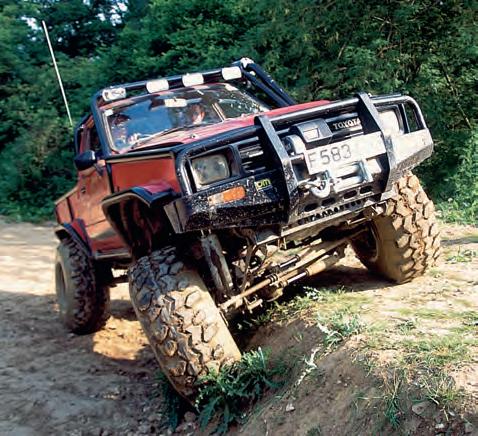
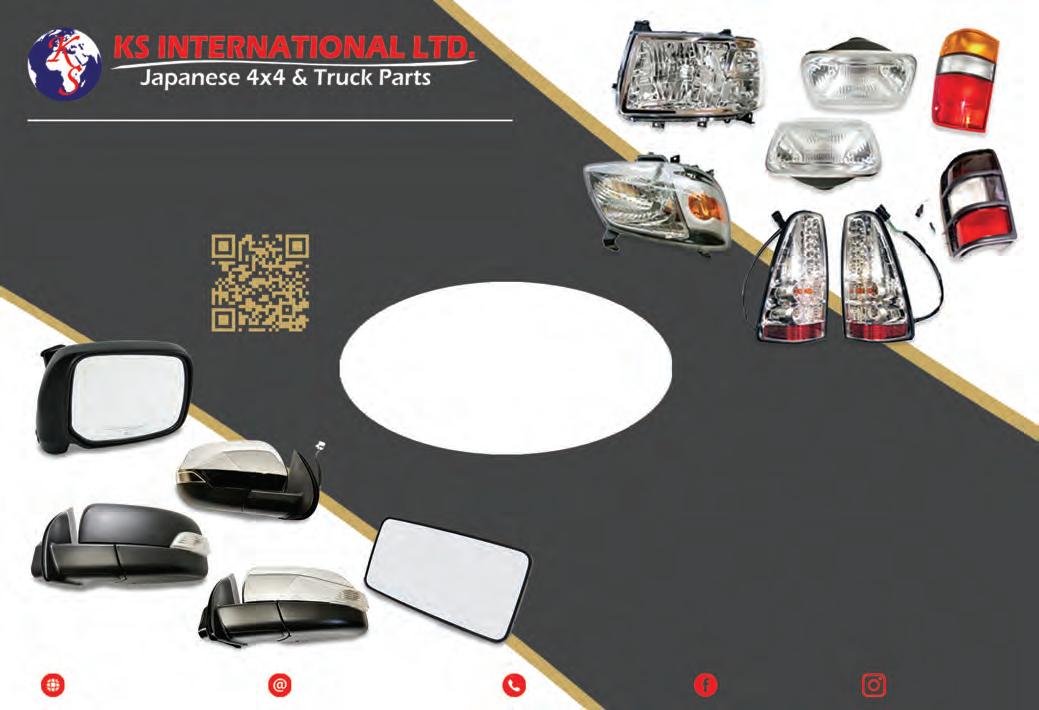
















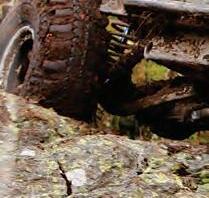
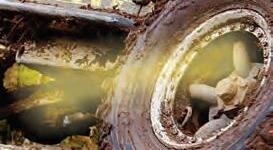

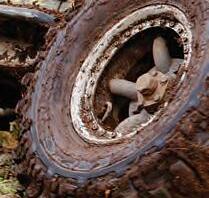






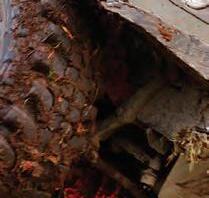



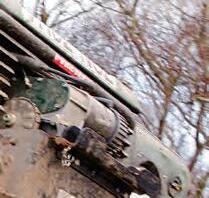




‘In wine, there is truth,’ to quote the ancient Romans. We don’t know if it was wine that Mark Lee had been drinking when he hit the Buy Now button one night, but the ancient Land Rover he’d bought has ended up as a true gem
Words Tom Alderney Pictures Mark Lee
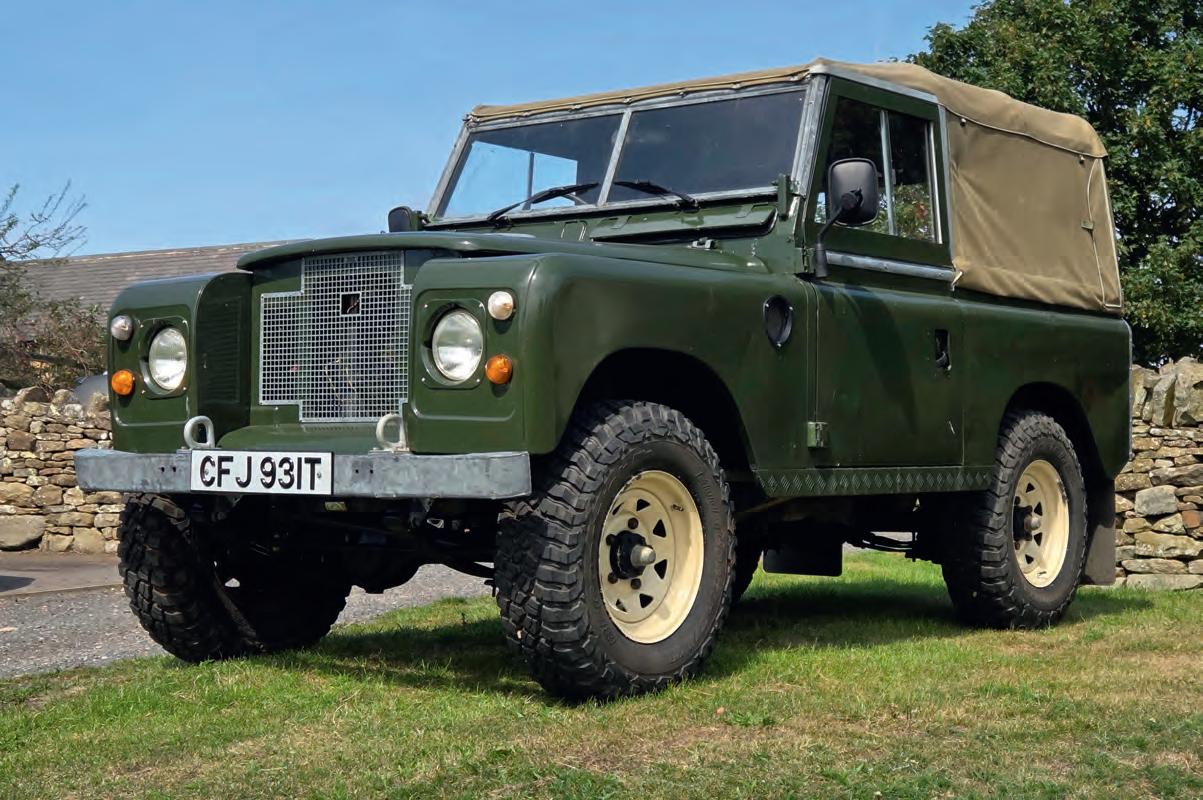
If you’ve ever sold a car on eBay, you’ll know all about the remarkable number of eager buyers who happen to be in Africa. Even more remarkable is how good they all are at discovering their ideal car for sale about thirty seconds before the auction ends, then bidding on it and winning at the last moment – though this is tempered by the terrible luck they all have, which sees their house burn down, their sister suddenly require a lifesaving operation or their town invaded by man-eating badgers, all within the next two minutes.
Of course, none of these people have ever been anywhere near Africa. We can tell
you something that their wrists have been near (in fact they’re seldom parted) but ‘my twenty grand a month contract in Angola has just been extended by eight weeks so I can’t buy my dream car after all’ is code for ‘I’ve not changed the bed sheets in my Catford hovel since I moved in.’ Still, how disappointing it must be to win an auction then discover too late that you’re on the other side of the world.
Mark Lee wasn’t quite on the other side of the world when he made what he describes as the ‘drunken eBay purchase’ of a V8-engine 1979 Series III SWB. But he lives in Consett and he hadn’t checked
where it was located. Which, as it turned out, was Swanage. As in, the last thing you pass before you fall in the Channel.
It does actually take less time to drive from Consett to Swanage than to fly between Britain and Angola. So there’s that. But then, Mark was doing it in his 300Tdi Hard-Top Defender 90. With a rented trailer on the back. And on the way home he was doing it with the Series III loaded up, and by now you might as well be flying to New Zealand. On a balloon.
It was, he confesses, ‘an ordeal.’ But then he got the 88 home and he could start enjoying it.
By ‘enjoying,’ we mean restoring. Which is definitely an enjoyable thing to do, and very rewarding. In each case, very much the opposite of driving up and down the M1. That was in August 2018. When he bought it, Mark says, the Series III was ‘unrestored’, which could be code for almost anything if he was selling it in that state. He’s not, we hasten to add – he is selling it, as it happens, and we’ll get to that later, but it’s a far cry from the sad old thing he fetched home back then.
People have used the word ‘restore’ to describe little more than a wipe over with an oily rag, but this was not that kind of job. It was the kind that started with a phone call to Richards Chassis. Not that a re-chassis is the same thing as a full restoration, and Mark wasn’t aiming to take the vehicle back to showroom condition the way some projects do (wiping out a lifetime’s history and character in the process), but he certainly was aiming to make it right.
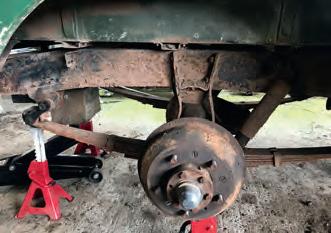
A galvanised chassis is a very good start, but obviously there’s more to it than just that. In this case, the bulkhead was still sound as a pound so Mark was able to turn his attention to the oily bits.
That engine is a 3.5. It had been in situ for a lot of years, having originally been installed using an early WE Phillips conversion plate. Mark gave it a partial stripdown, replacing the timing gear and camshaft and replacing the original inlet manifold and twin Stombergs with new kit from Edelbrock. It ‘runs well and makes a nice noise,’ to quote – and he also gave it an alloy rad and electric fan, complete with thermostat and override, so it doesn’t turn itself into a kettle when he’s sitting in traffic.
Up front, the list also contains swivels, steering arms and track rod ends. The axles hold the rest of the vehicle up on a set of parabolic springs, with new shocks keeping them under control.
Now, parabolics are a great way to make a leafer ride better – and they can transform the way it drives off-tarmac, too. And Mark wasn’t just there for the workshop stuff
‘The 3.5 V8 had been in situ for a lot of years, having originally been installed using an early W.E. Phillips conversion plate’
Down below, the axles got new brakes, brake pipes and wheel bearings all round.
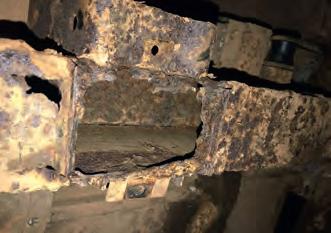
– having made it right, he started using it as a green lane wagon. Good lad. It was a truck-cab at that point, with a fetchingly chequered appearance thanks to a primer grey passenger’s door with a yellow top to go with a shade of green that looked more farm than factory.
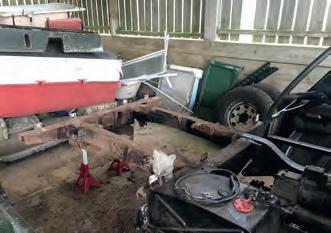
Above left: No sooner had Mark brought the Series III home than he was pulling it apart to see just how bad it was underneath…
Above centre: …which was, as it turned out, pretty bad
Above right: The back of the chassis was looking worse than the front, which is pretty standard. The 88 had spent its life by the sea and Mark reckons it had been used for reversing boat trailers into the salt water. When it’s THIS bad, anyway, anything other than a full galvanised replacement would be a false economy
Below left: The bulkhead by contrast only needed a bit of love to keep it from heading off down the same path as the chassis. It was still solid at this point and more than able to go again
Below centre: Fresh off the trailer from Richards Chassis, just over three months after Mark first brought the 88 home, this is what every old Land Rover deserves to be treated to at some point in its life
Below right: Got a galvanised chassis? Paint it black. Last thing you want to do is tell the scrotes of the world that your truck’s likely to have lots of other valuable bits on it too
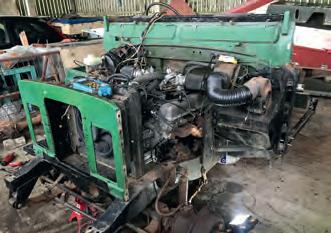

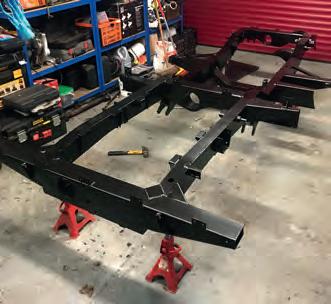
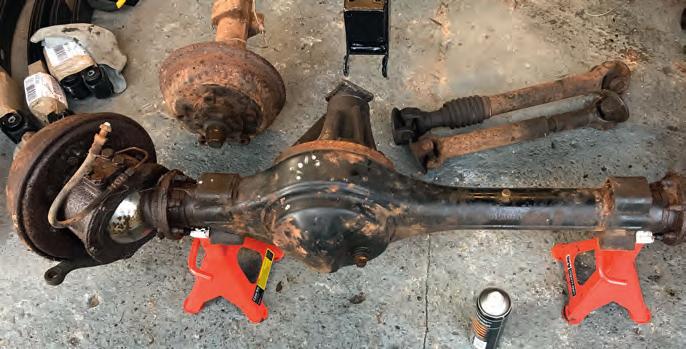
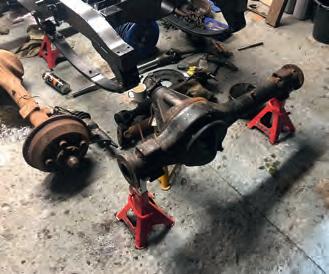
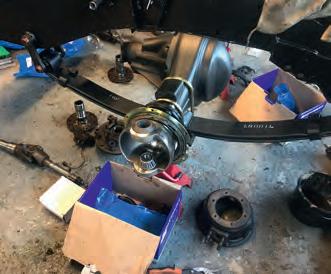
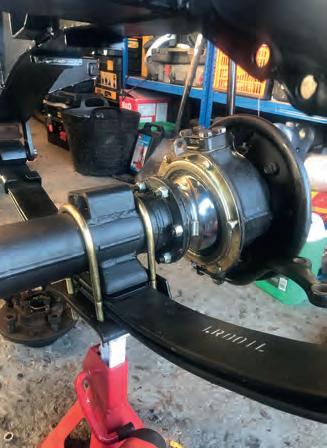
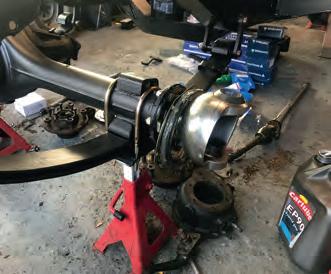
Above: As part of the axles’ refurbishment programme, which was a thorough one,, the front one gained a new set of steering swivels
Below left: Staying with the steering, the drag link and track rod made way for new ones too
Below centre: When they went back under the vehicle, the axles were going to be hung on parabolic springs
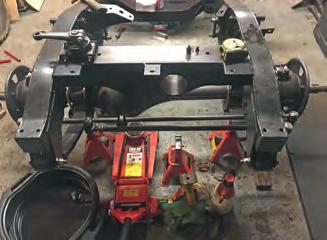
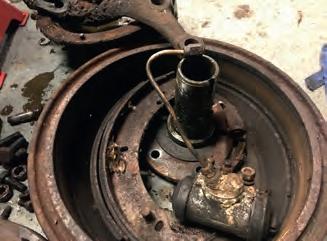
Laning means scars, of course, and no problem there, but more recently Mark has given the 88 a new coat of paint. Actually, we’ve skipped ahead with that, because after a year of running it as a second car he sold the Land Rover on to a friend. About five years passed before he bought
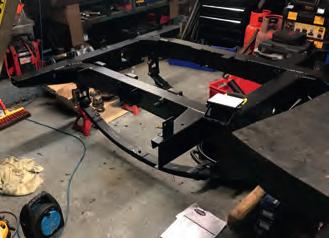
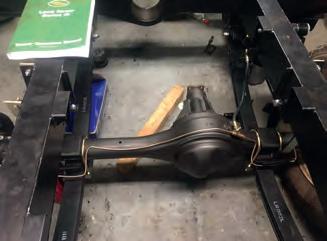
it back again (we’re assuming his friend doesn’t live in Swanage).
This was the point when he repainted it, by hand rather than spray gun, with Coach Enamel from Paintman. That’ll last. It won’t
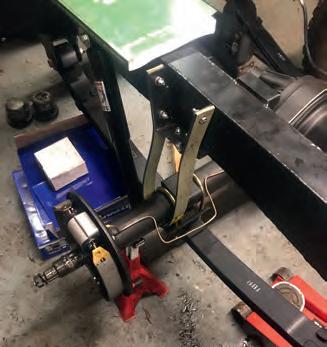
Brakes were fully renewed all round. Not before time, judging by the state of the old ones. New brake lines went on, too
have escaped your notice that it’s not a truck-cab any more, either – a set of Exmoor Trim hood sticks with a canvas tilt from Undercover Covers sees to that. ’It’s much nicer with the soft top,’ he says, as do most people who’ve experienced both – truckcabs do a fine job of being cramped, loud

The engine was reconditioned with its top end stripped and a new camshaft installed. It gained a new timing chain, too, as well as an alloy rad, electric fan and Edelbrock carb and inlet manifold
Right: Well into the rebuild here, with the tub and bulkhead back on and the engine in place – complete with a bit of bling from Edelbrock
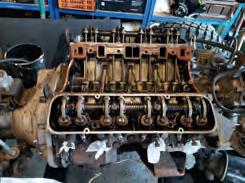
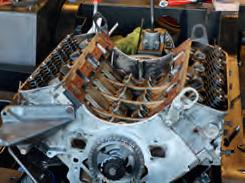
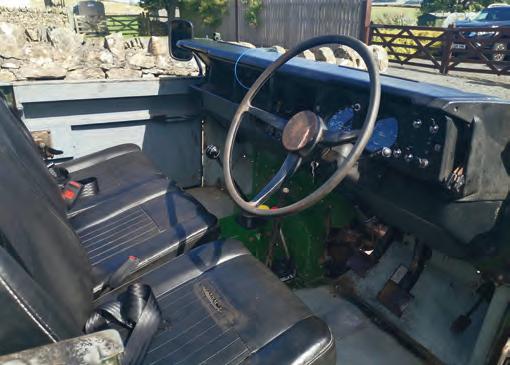
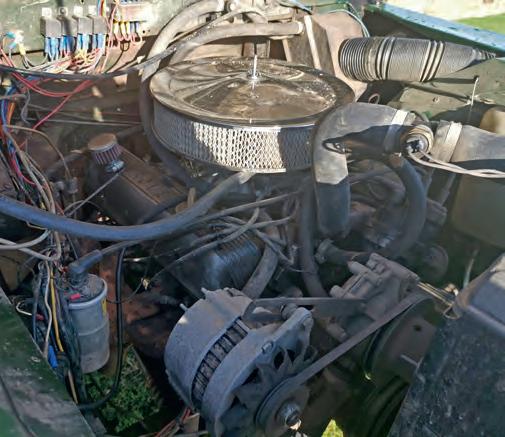
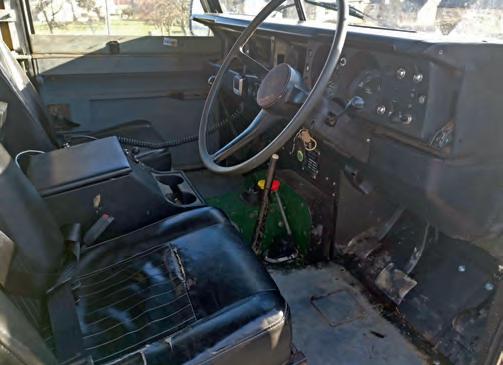
Above: You see Series trucks whose restorers have tried to turn them into some sort of boutique land yacht. But a Series truck is still a Series truck – and all the more charming for keeping the wear and tear that gives it its character, both inside and out. The floor is fully in in the second picture, and note the appearance of a cubby box for the CB and stereo in place of the centre seat that was there before
Below: It’s not quite a hot rod level of prep but Mark did knock the old paint back and smooth it off before priming the body and applying the final glory coat. Though even just taking the grille off and pulling out the sidelight housings is more than many Land Rovers have received ahead of being painted
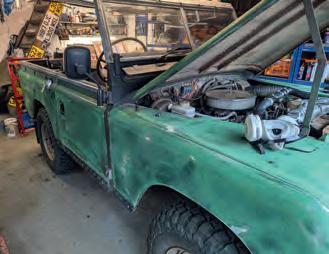
and both too hot in the summer and too cold in the winter, whereas soft-tops are all-round better and somehow manage to be less draughty, too.
Mark wasn’t going for a concours look when he repainted the 88, and with eightspoke wheels and chequer plated sills it
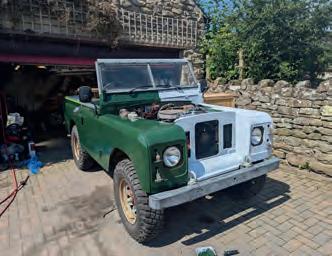
will always have a down-to-business appeal rather than looking like an ornamental lily. We reckon it’s a long, long way above average, though – there’s always something you can do (Mark suggests the engine bay wants prettying up) but to us, this is a Landy that’s begging to be used, not purred over.
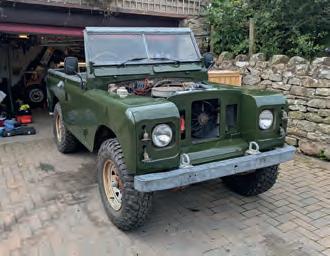
Would you daily it? You certainly could –the petrol bills might sting a bit, but nothing like as much as the depreciation on a new Land Rover. Would you use it as an off-road weapon? Without a doubt. Would you drive it halfway across the country in search of adventure? Hell, yeah.
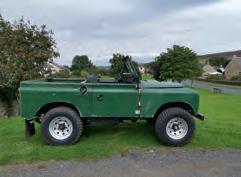

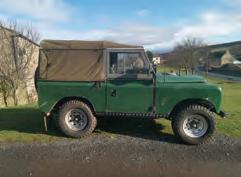
Four chapters in the Land Rover’s story. From left to right, old rust-bucket as found; rebuilt truck-cab; new canvas hood installed; and finally repainted. The rims are letting it down in this last photo, but Mark was on the case literally the following day (right), doing the same for the Land Rover’s white eight-spokes to make them white again. And what a difference it made
Below: It’s a pretty fit looking rig, this (inset), but not necessarily what you’d choose for a journey from the South Coast to Northumberland. Back in its truck-cab days (main pic), the 88 was no stranger to the green lanes of the north; it would make an even better laner now it’s a soft-top, and that new coat of paint isn’t so fancy that you wouldn’t want to scratch it
But would you trailer it the length of England behind a Tdi, that’s the question. You might, if you were to become its new owner – which is on the cards for someone, because as we mentioned Mark currently has it up for sale. Not that you ought to flinch at the prospect of just getting aboard and driving it home – in fact, while doing so you might want to take the long way round
and make the journey into a bit of a bonding process. And with that V8 singing in your ears, we reckon you’d be congratulating yourself on your purchase more and more with every passing mile.
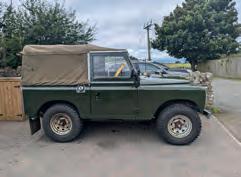
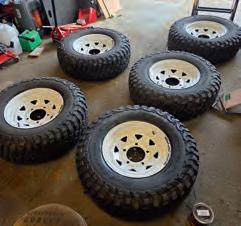
Thanks to Mark Lee for his help in compiling this article. The 88 was still for sale at the time of writing, priced at £10,995. If you’re interested, email the editor at alan.kidd@ assignment-media.co.uk and we’ll pass it on.

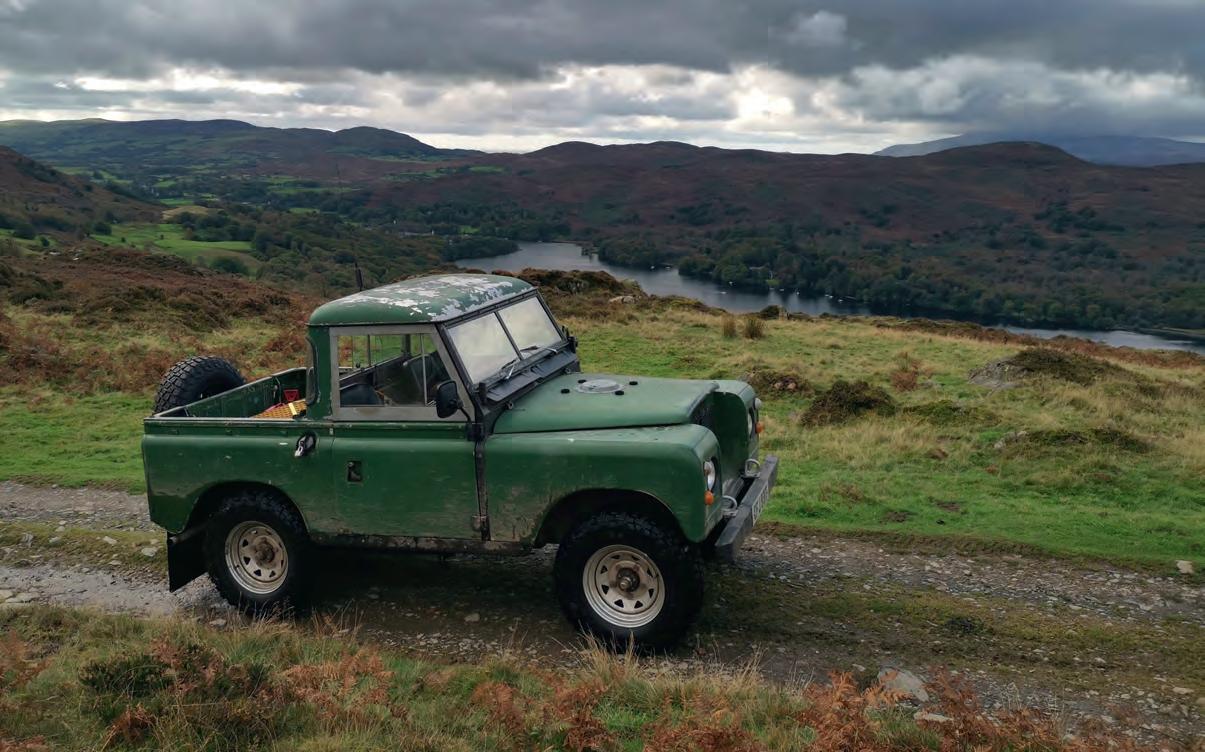








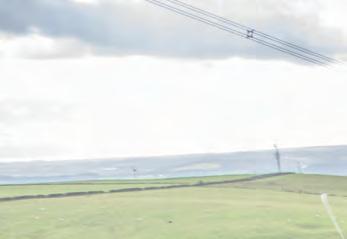


















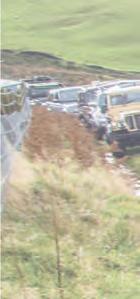








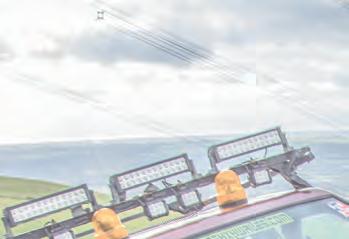




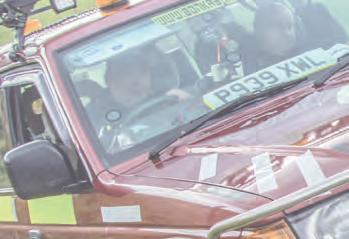
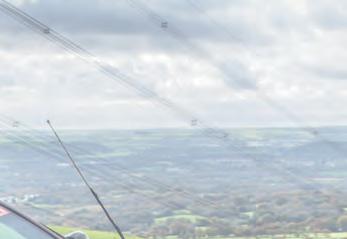











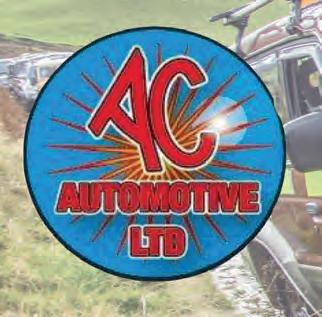








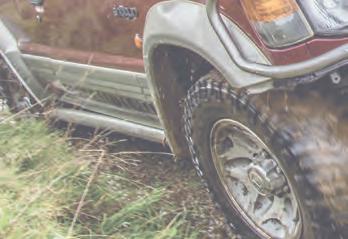
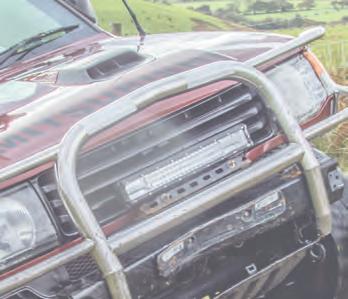






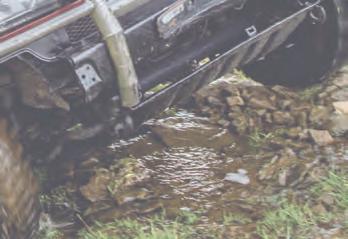


















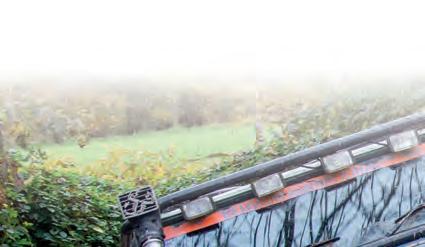
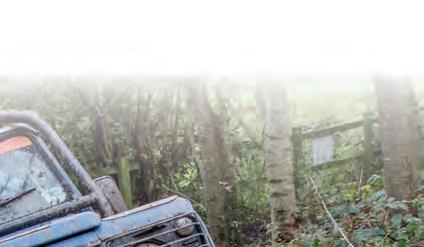
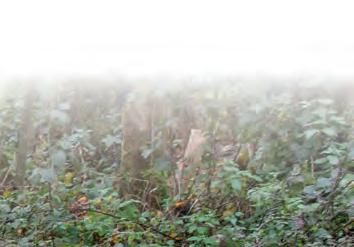
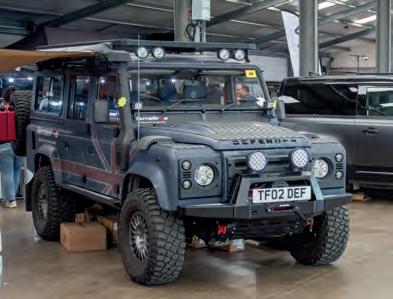

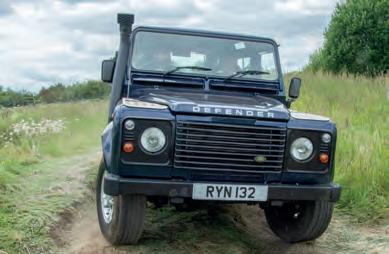












Land Rovers are returning to Stoneleigh this November for a day filled with Land Rovers!
Exhibitors old and new will join us, selling everything from parts & accessories to tyres, clothing and toys Talk to overland adventure specialists about your next trip, discuss modification options with companies with the know-how and other experienced Land Rover owners.
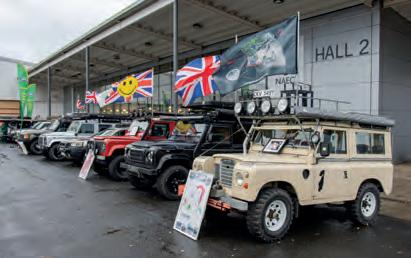
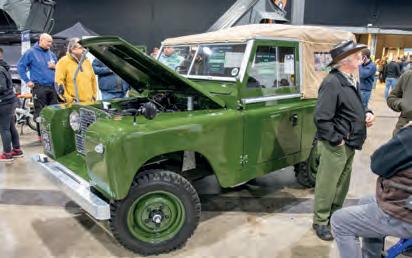
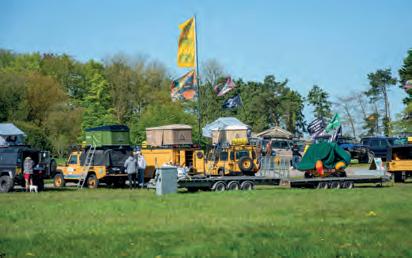
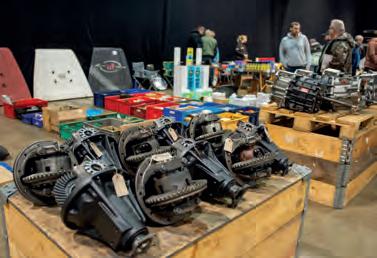
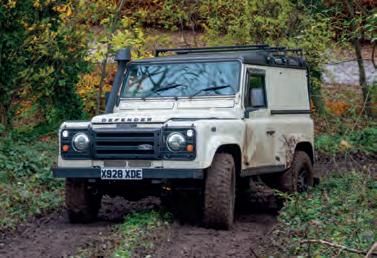
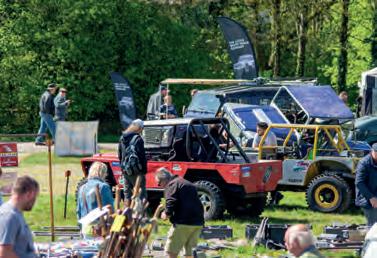
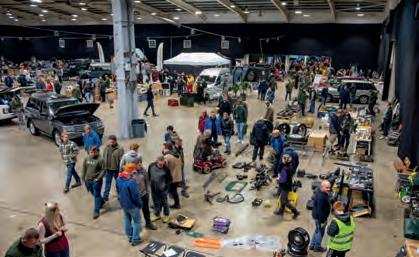
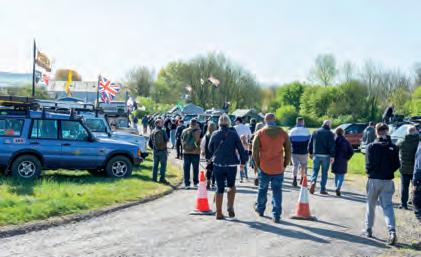
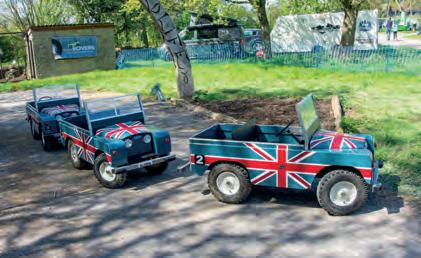










After many years spent exploring the world aboard Land Rovers, a dedicated Solihull fan takes on one of Africa’s most prized overlanding destinations aboard the Defender’s great nemesis from the east…

Words and pictures: John Pearson

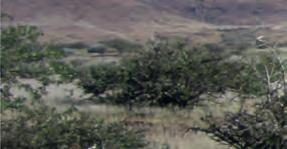








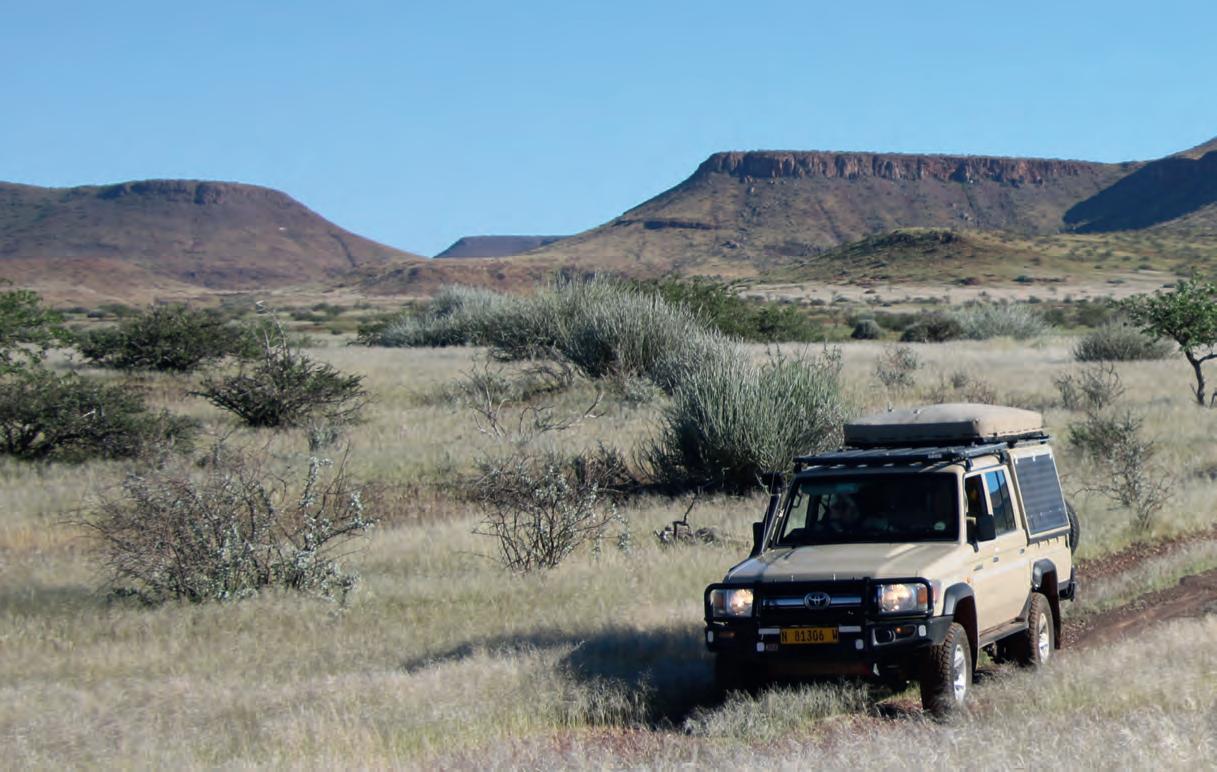
The elephant heading towards us is significantly bigger and heavier than our 4x4. It’s flapping its ears and shaking its head in agitation that we’re in its way on the track. Am I worried? Yes indeed.
A park ranger once told me that elephants see it as a sign of weakness if you back away from them, and it could trigger a charge. So, rightly or wrongly, I’ve pulled tight into the side of the track and my wife Jane and I watch in trepidation as it heads towards us from
several hundred yards away. As it gets closer, I can see its tusks aren’t especially large, so in the event of it getting really angry with us there is possibly a certain amount of damage limitation. We also have a substantial bull bar across the front of our vehicle, although I imagine there would only be one winner in an elephant versus Toyota contest.
As it turns out, the elephant stops a few yards away, aggressively shakes its head again, then bizarrely throws a stick at us before changing its mood and ambling off
into the bush at the side of the track. Panic over – but phew, what an experience. We’re in Namibia on a two-week overland safari. It’s a country I’ve visited and enjoyed several times in the past but this time it’s different, very different – I’m behind the wheel of a Toyota Land Cruiser 79, after many years of enjoying adventures around the globe in Land Rovers. As the former editor of Land Rover Owner, I’ve driven every model of Solihull’s finest – but never a Land Cruiser. So this is going to be an interesting new experience.







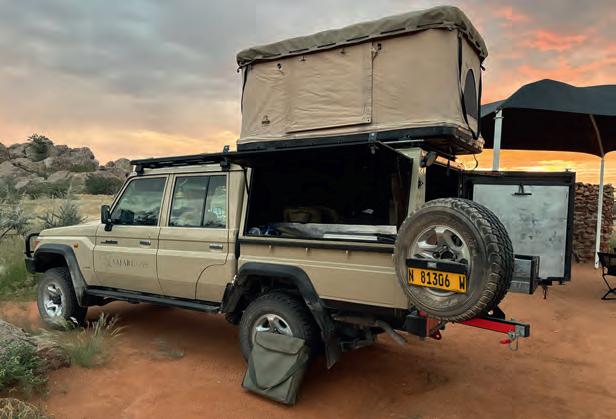

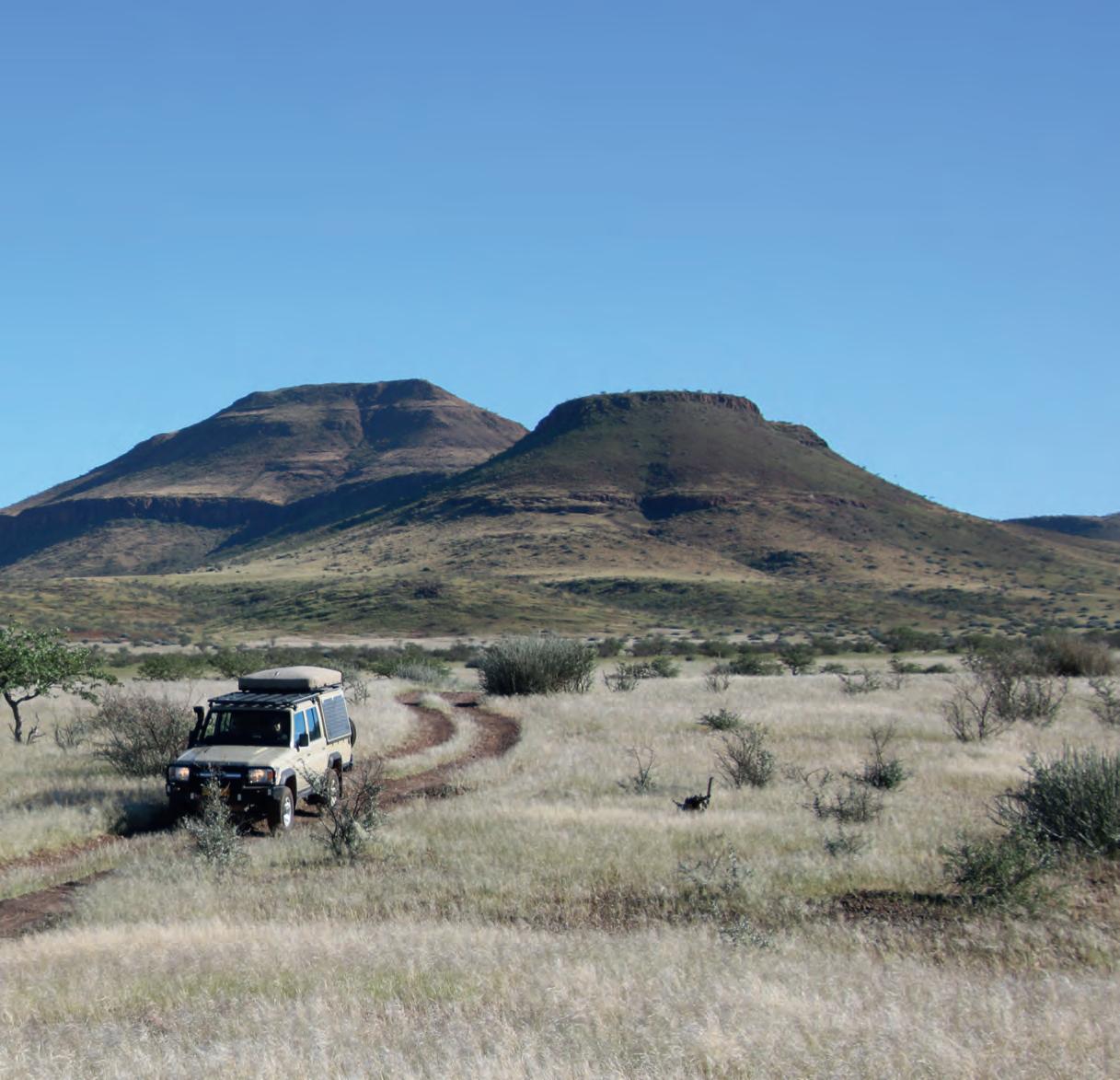
I’ve hired the extensively kitted-out Toyota from Safari Drive, which has also provided an itinerary and booked us into a mixture of mostly upmarket campsites and well appointed tented camps on a tweaked (to our requirements) version of its Classic Namibia adventure package.
It’s Jane’s first major 4x4 adventure and I want her to enjoy the luxury locations as well as camping in the Toyota’s roof tent. It’s also a first for our trip companions, our neighbours Robin and Jenny Homewood, who are in another Safari Drive Land






Cruiser. They are long-time Land Rover owners and lived and drove 4x4s in South Africa for a few years but have never done anything like this before.
Namibia is a dream destination for overland enthusiasts. Its population is just over three million, compared to the UK’s near 70 million, and our country is a third of the size – so there are lots of big, unpopulated spaces. There are more tarmac roads than when I was here before but there are still significantly more dirt roads, where a 4x4 is essential.
The vast Namibian scenery is stunning, and unusually green after considerable rain in recent times. Then of course there is the amazing wildlife – not just angry elephants but big cats, rhinos, giraffes and lots more besides.
For many years, Safari Drive exclusively used Land Rovers, with the previous owner Charles Norwood being an avid Solihull fan. But since the end of original Defender production in 2016, the current owners have embraced Land Cruisers. The 79 double-cab pickup is similar to a
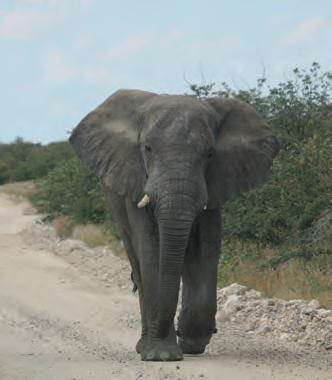
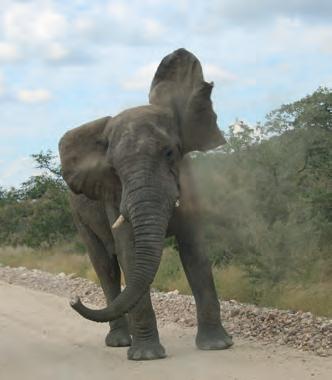
It doesn’t matter what you’re driving: elephants still have right of way. This is always a good thing to remember, never more so than when the elephant in question wants to enquire as to whether it’s you that spilt his pint. This rather alarming display of intimidation turned out to be no more than that, though the big guy chucked a branch at the author’s Land Cruiser before wandering off contendedly. Namibia was recovering from unusually heavy rains at the time of this trip, as you can clearly see on the right…
traditional Defender, with a ladder chassis, but it has coil-sprung front suspension and leaf springs at the rear. The understressed 4.2-litre six-cylinder diesel motor churns out a lazy 131bhp and 210lbf.ft.
Transmission is five-speed manual, with part-time 2WD/4WD, and it’s fitted with locking front and rear diffs – giving it awesome off-road capability.
The Safari Drive fleet all have a bespoke three-door rear canopy that’s kitted-out exceptionally well, with much thought having been given to storage. The only thing I’d add is a Jetboil to facilitate a speedier cuppa.
They’ve traditionally used soft-shell foldout Eezi-Awn canvas roof tents but have recently switched to full-length Tentco tents that pop up on gas struts. These have a bespoke top which looks like a canvas shower cap, secured by a rubber strap that fits over hooks all around the perimeter. It
also has a comfortable mattress designed to Safari Drive’s specifications.
After a night in Windhoek’s Olive Grove guest house and a visit to the quirky Joe’s Beerhouse for cold beers and huge game steaks, Safari Drive’s Namibia base manager Jens Denk gives us a full briefing around the Toyotas. Then it’s down to the local supermarket to stock up with provisions before heading 120 miles north to the first campsite at Okonjima. It’s tarmac all the way until we turn on to the access dirt road to the site, but at least this gives us the chance to familiarise ourselves with the Toyotas before getting into any more challenging terrain.
After passing through several gates it’s wow, hello, there’s a family of baboons… and further on, a number of zebras and giraffes. Woohoo, we’re definitely in Africa!
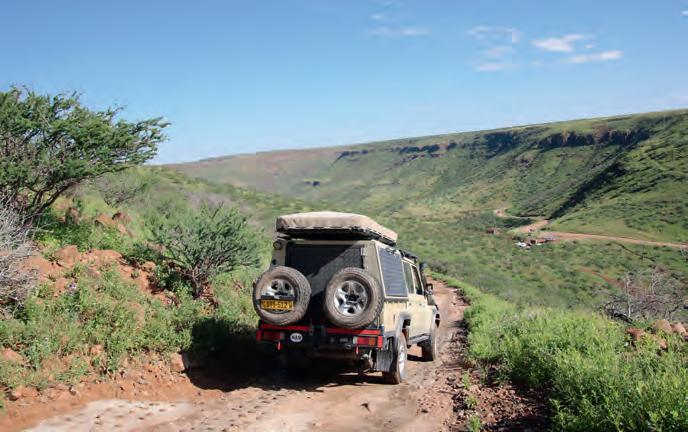
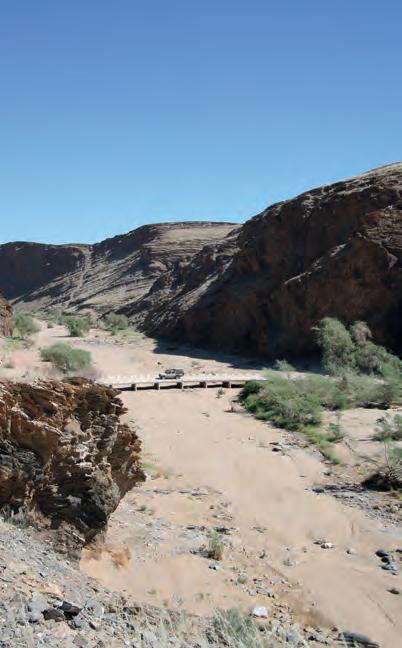
The campsite is charming and wellmaintained, with a piping hot shower and a toilet cubicle that’s open to the bush. We cook steaks and jacket potatoes on the camp braai, struggling to get the supplied firewood going. But it’s a lovely feeling being back out here in Africa and we’re transfixed by the night sky, with zero light pollution making the stars and galaxies appear truly magical.
So, you might be wondering, what’s it like driving a Toyota after more than a quarter of a century of Land Rovering? The answer is that it’s strangely familiar, really. It’s undoubtedly a big, heavy truck – solid and reassuring. Power delivery is effortless and there’s a delightful bass growl from the big-six’s exhaust.
The cab is more spacious than a traditional Defender’s, with better leg and elbow room. All-round visibility is good and I get on fine with the controls, but Jane finds the clutch a little heavy. Throttle control is excellent, the steering delivers decent feel and the brakes are powerful enough for the Toyota’s weight, yet not over-sensitive.
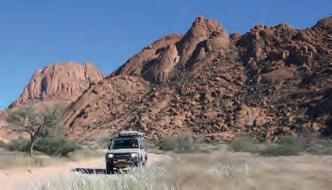


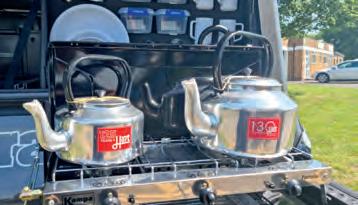

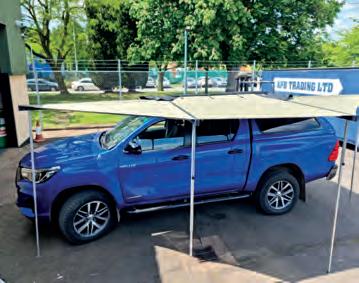
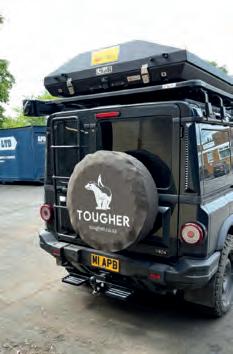
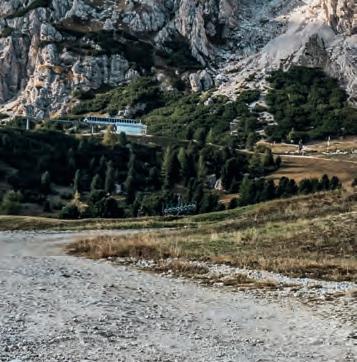





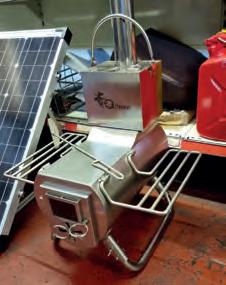
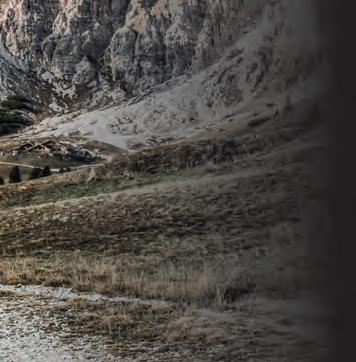
• Escape Gear
• ...and many more!


• Aluminium canopies
• Roof tents and roof racks



• Off-road fridges and 12v gear
• Drawer systems and slides




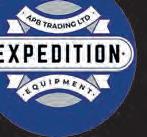


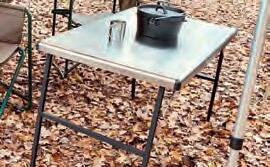


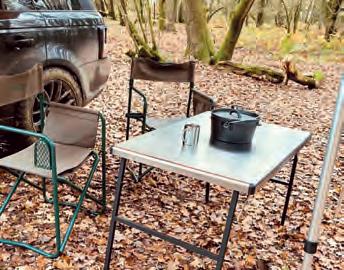

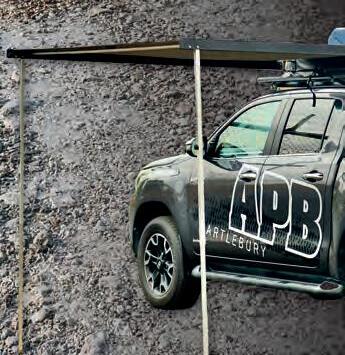


• Bumpers, side steps and vehicle protection
• Campsite essentials, tables and chairs



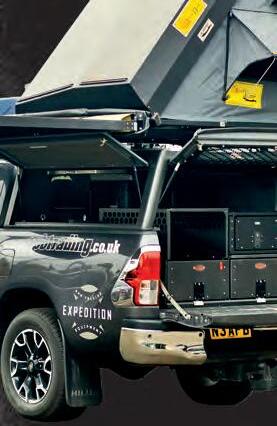












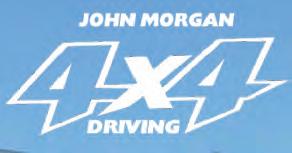



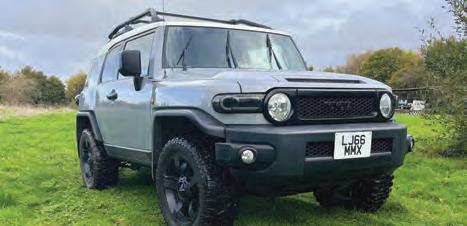
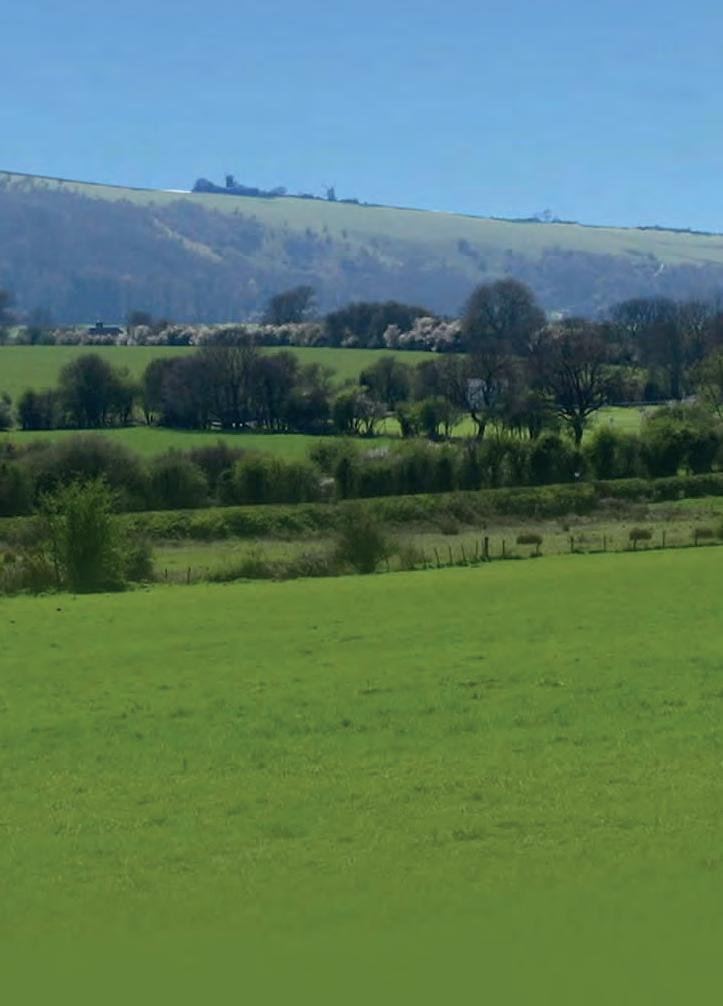


Cynghordy Llandovery Carmarthenshire, SA20 0NB Tel: 01550 750274 e-mail: info@cambrianway.com www.cambrianway.com

Family run guest house and self catering cottages with spectacular views, en-suite bedrooms, comfortable lounge bar and excellent home cooked food. Pressure washer, drying room, map room with local lanes marked, on-site 4x4 course, guides and GPS hire available.
A very popular venue for both individuals and groups of 4x4 enthusiasts

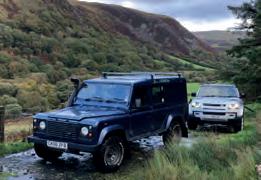
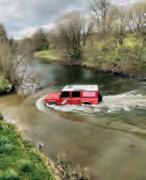






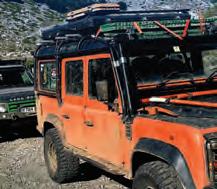
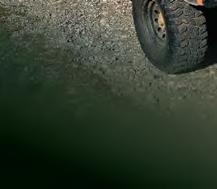

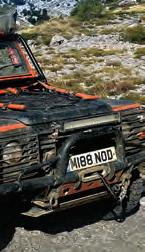
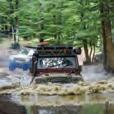
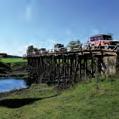


info@4x4adventuretours.co.uk www.4x4adventuretours.co.uk @4x4AdventureOverland 4x4adventuretours


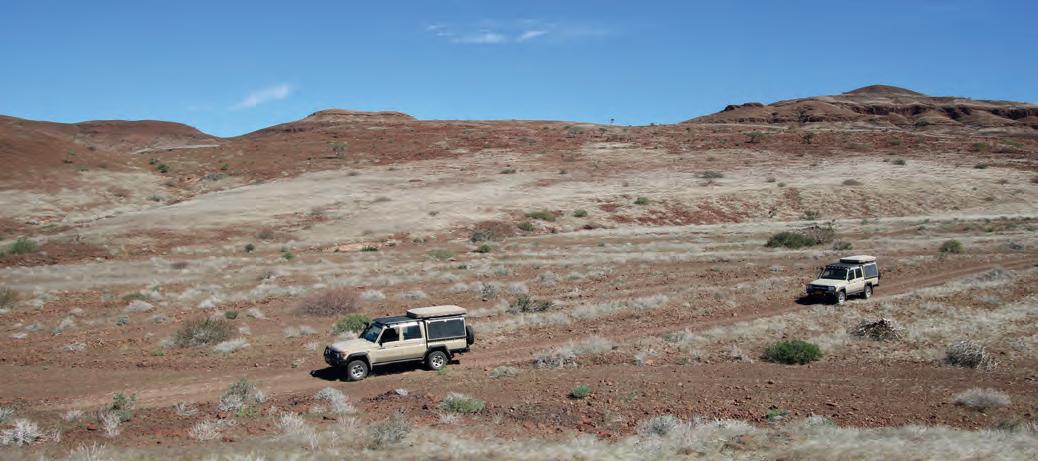
I am, however, having trouble adapting to the indicator stalk being on the right of the steering column. I’m okay when thinking about what I’m doing, but when making a subconscious manoeuvre I usually end up with the wipers going instead of the indicators.
Shifting from 2WD to 4WD and then to 4LO is via an L-pattern. It’s easy enough going back to high range, but occasionally I have to stop and go backwards before it will engage 2WD again.
I haven’t used Dunlop tyres for years but the 265/70R16 Grandtrek all-terrains deliver decent grip and aren’t especially noisy on the tarmac. Safari Drive has set the pressures to 1.8bar at the front and 2.4bar at the rear, which they reckon should be okay for all the conditions we’re likely to encounter.
There’s a Safari snorkel and a mighty ARB bumper up front, topped by that sturdy bull bar. Everything about the Land Cruiser is tough. As with a traditional Defender, it’s built to get you where you want to go, without compromise.
Next day we’re back on the tarmac – 215 miles of it – going from Okonjima to our next overnight stop, the Onguma Tamboti campsite. This is another upmarket site where the camping bays have their own toilet and shower, and there’s the added bonus of a central bar and restaurant overlooking a floodlit waterhole. We’re here for two nights and on the second evening are treated to the magical sighting of a leopard coming down to the water for a drink, seemingly oblivious to the viewing audience across the small pool.
Having got the long, uneventful tarmac stretches out of the way during the first part of our trip, now we’re getting into the much more interesting dirt roads, starting with a drive across the Etosha national park. Dominated by a massive salt pan and measuring almost 23,000 square kilometres, this is reputed to be one of Africa’s greatest wildlife sanctuaries. And it would be normally, but the day we drove through the vast savannah and among the many acacia and mopane trees, most of the wildlife had gone into hiding. Or, as was explained to us, there had been so much rain the animals had no need to go to the waterholes to drink.
But things were going to get a lot more interesting at the next two-night stop over, at the luxurious Ongava tented camp on
a private game reserve – and not just because it’s where we had the elephant experience I mentioned at the beginning. The camp’s central bar, dining and lounge area overlooks a waterhole, where we see a variety of wildlife. Lions are reputed to visit it on occasions; we don’t see any here but do get to see one on a game drive.
The terrain gets more interesting now, even though we have to divert from our intended off-road route due to a mighty storm which we manage to dodge around. After the town of Kamanjab, there are some delightful rolling hills dotted with impressive kopjes (rock formations).
We’re back in the roof tent tonight at the Hoada campsite in Damaraland. Nestling among more kopjes, this has good facilities with a log fire under the donkey boiler providing hot water for the shower.
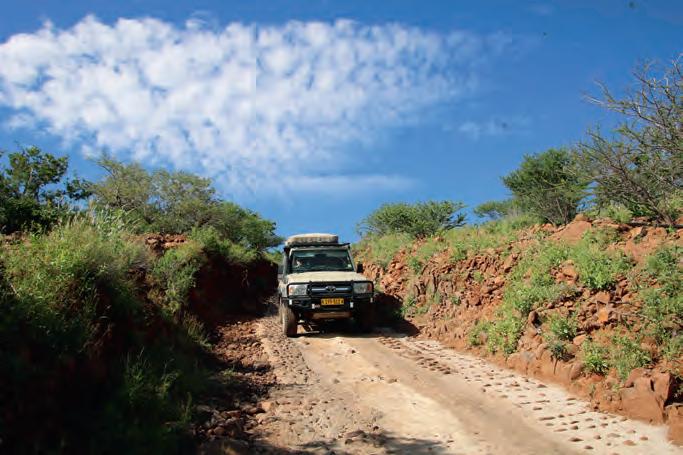
The Safari Drive self-drive package is luxurious but inevitably expensive. The Classic Namibia itinerary we chose starts from £2785 per person in low season (we went in April) for four people sharing a vehicle. High season (July to October) prices are steeper, from £3543 – or £5050 if only two in a vehicle. But these rates include the vehicle rental, route planning and charges for the campsites and tented camps (most of which were all-inclusive for meals, some even including free drinks), plus hotel accommodation at the start and end of the trip and airport transfers. With Safari Drive you get full suppor t in the event of a medical or vehicle emergency, with a satellite phone supplied. They also provide lots of pre-adventure info and videos, plus a detailed specific itinerary booklet containing absolutely everything you need to know about the destinations and how to find them.
Safari Drive runs self-drive adventures in seven countries: Namibia, Botswana, South Africa, Tanzania, Malawi, Zimbabwe and Zambia. Pay a visit to safaridrive.com for details.
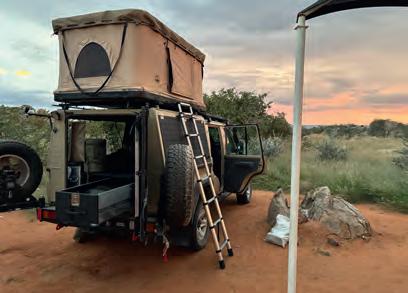
There’s a braai in front of that and I’ve bought some charcoal to supplement the not-so-cooperative firewood, which results in us having a decent fire for cooking.
The scenery gets even better as we approach the dramatic Grootberg mountains, which are a stunning contrast to the rest of Namibia. The Land Cruiser is
It is obviously possible to do a Namibian self-drive trip on a lesser budget. There are plenty of 4x4 rental companies offering vehicles with roof tents, fridges and full camping equipment from just over £1000 a fortnight. You’d have to pay for campsites etc on top of that, of course.
taking the haul up the Grootberg Pass in its stride but I’m down into low range second and then first for the steep climb up to the 1557m Grootberg Plateau, where we’re having a late breakfast at the community owned Grootberg Lodge. The views up here are top wow factor and the breakfast is superb. Well worth the detour.
The descent to the main track is also breathtaking for the views back over the pass and for the sheer drop to the side of the track. Not that it’s a problem in the Toyota: just leave it in first gear low-range and trickle down, totally under control.
Our next destination is the remote Etendeka tented camp, in the north of Damaraland and on the edge of the Namib desert. And when I say remote, I mean literally in the middle of nowhere. The track into it takes over an hour to drive, twisting and turning through more wonderful scenery and dipping in and out of numerous dry river beds.
I’m increasingly impressed by the off-road controllability of the Toyota. It’s delightfully smooth at the bottom end of the rev range, delivering reassuring grip. The terrain into Etendeka has a mix of loose rocks and sand but it never feels like it will lose traction and there’s no need to call upon the services of the front and rear lockers, even on loose and slippery rock crawls. The coil front/rear leaf spring set-up initially felt a little firm, but it delivers a decent ride on what are some pretty rough sections.
I was interested to learn that most people visiting Etendeka have to phone to get driven in by the staff. Only Safari Drive clients in the Toyotas are allowed to drive themselves in.
I’ve been to Etendeka when I visited Namibia over 20 years ago, when I met the owner Dennis Liebenberg, a big Land Rover

fan. He’s still running the place but is away on business, so no chance to catch-up.
Improvements have inevitably been made since then, but it still has the same feel that I recognise. And the open-air showers still have buckets with roses underneath which you fill with hot water. It too has magical night skies.
We’re here for two nights, going for a guided walk in the morning before relaxing in the swimming pool. But it’s the evening sundowner drive that is the highlight for me, not least because we’re in an old Defender game-viewing vehicle. Last time I was here it was V8-powered, but an Isuzu 4-cylinder diesel has subsequently been transplanted under the bonnet. Ranger Boas is a competent off-road driver and it’s impressive where the Land Rover takes us without fuss or failure. Having a gin and tonic in the middle of amazing scenery as the sun dips behind the mountains is just one of life’s memorable occasions.
Next morning, Jane drives us out along the twisty, undulating, rocky and sandy track out to the C43 – her first major 4WD excursion behind the wheel.
I have a plan to tackle some interesting 4x4 routes west of the main track. And it is a lot more enjoyable, with some wonderful scenery among the mountains. Or at least it is until the mapping stops working when my iPhone loses the signal. Then it becomes slightly more stressful as I revert
to using an actual paper map, compass and a bit of guesswork to get us back out to the main route. We’re never lost as such, but it seems to take forever before the Toyota emerges through the back of a small village and on to the C39.
Tonight we’re back in the roof tent at the community-owned Granietkop campsite, which nestles under a giant pile of granite boulders near Twyfelfontein in Damaraland. It’s another superb site, with individual toilet and shower, donkey boiler and braai. And the two ladies running the site office are delightful. Cooking and eating a meal then sitting chatting with cold beers in this dramatic location under the starry night sky is one of those times to be savoured.
The terrain is getting increasingly sandy as we head south-east towards the next stop at Spitzkoppe. It’s a lovely drive through scenery that’s like a cross between the Canadian prairies and Puy-de-Dôme in France’s Auvergne region. There are alternative routes but in view of yesterday’s aberration, I’m being less adventurous and sticking to the gravel roads.
And anyway, the advice from Safari Drive is to get to the site at Spitzkoppe early to ensure we bag a decent camping spot as it’s not possible to book one in advance. Unfortunately we’re still too late, both to get a meal at the restaurant (which closed at 5pm!) or to bag a good location. It’s another dramatic granite backdrop, significantly bigger than the
Granietkop one, but we tour around the busy site for ages before chancing upon an unoccupied spot.
It’s windy, the toilet is a long-drop in a corrugated iron shed and the showers and flush toilets are a two-mile drive away. I guess we’ve been spoiled by the delightful locations at Granietkop, Hoada, Okunjima and all, but this is disappointing.
To make matters worse, the wind gets stronger through the night, thumping against the sides of the roof tent and blowing the canvas top completely off Robin and Jenny’s tent. Fortunately it’s easy enough to refit.
We’re going west towards Henties Bay on the coast, initially through savannah before the terrain becomes sandy desert as we enter the Dorob National Park. The going is straightforward, apart from occasional corrugations.
We have lunch at the excellent Fishy Corner restaurant before going south down the tarmac Skeleton Coast road to the seaside resort of Swakopmund. There’s been a lot of development here in recent times, but it still retains some of the characteristic 19th Century German colonial architecture I remember from previous visits.
We’re staying overnight in a wellappointed chalet in the Desert Breeze resort, overlooking the magnificent coastal dunes. And in contrast to yesterday, we’re dining out in the evening, in style, at the town’s Tug restaurant. This delightfully
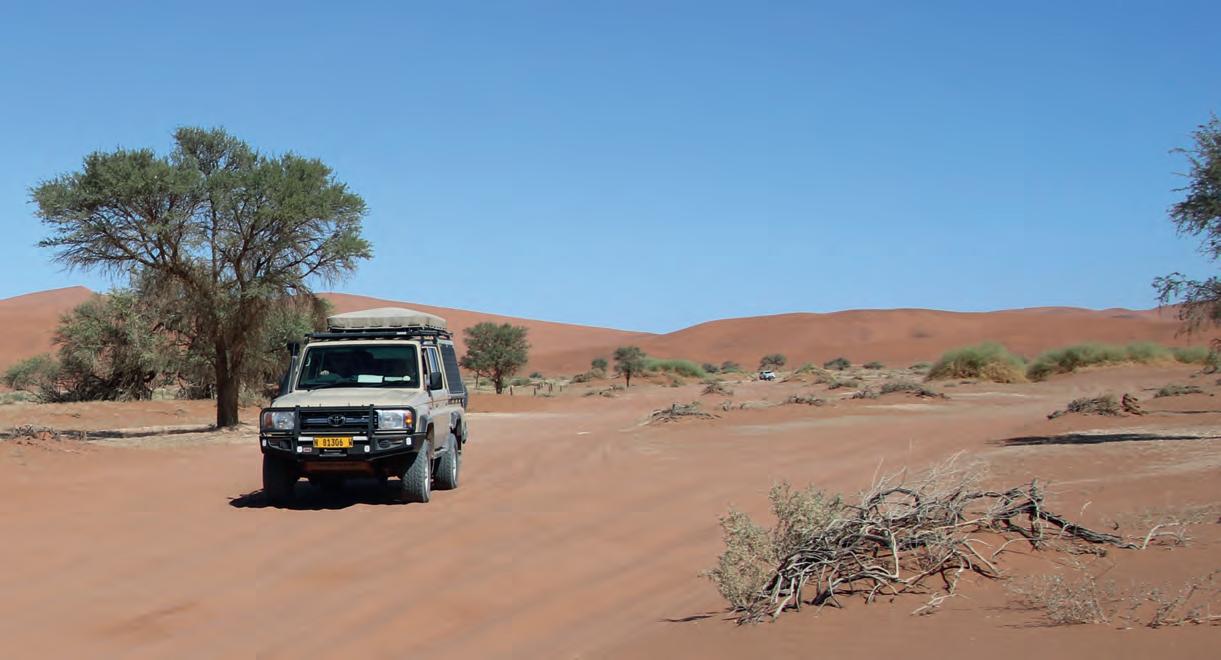
• Language: English is Namibia’s official language and is widely spoken, although there are around 30 different languages.
• Currency: Namibian dollar (credit cards widely accepted, and South African Rand welcomed too). Exchange rate at the time of our visit was just under 25 dollars to the pound.
• Cost of fuel: Diesel £0.90/litre. There are a surprising number of filling stations even in remote areas.
• Maps: Safari Drive supply a KML file of the route and overnight destinations to upload on to Maps.me or Google maps on your mobile. I also used a Reise 1:1,200,000 paper map as back-up. The Land Cruisers also have their own sat-navs.
• Camping: All sites were pre-booked by Safari Drive but there are plenty of sites listed on-line, including Booking.com.
• Food and drink: Compared to the UK, eating out is significantly cheaper.
• How we got there: There are no direct flights to Namibia from the UK. The options are UK-Frankfurt-Windhoek or UK-South Africa-Windhoek, which we chose.
• Anything else I need to know? Namibia has recently introduced a tourist visa, which stings you for around £80 per person. It’s wise to apply online in advance, and you need to have a printed version to show at immigration.
Oh, and talking of immigration, getting through the country’s antiquated, labourintensive entry procedure is nothing short of purgatory, with a couple of other flights arriving simultaneous to ours at the Windhoek airport and the resultant lengthy queues taking literally hours to process. When I had to return to the back of the queue after finally getting to the official’s booth and discovering there was a problem with my visa, I just kept telling myself it would be worth it once I got into the country. And, of course, it was.
characterful eating house was built around the wheelhouse of a steam-powered tugboat back in the 1990s; it’s no surprise that it’s packed because the atmosphere is wonderful and the food superb.
It’s typically foggy the next morning as we continue south to Walvis Bay. This is caused by the cold Benguela Current, which sweeps up the coast from the Western Cape of Africa, meeting the hot desert air.
I’ve been to Walvis Bay before, after a week-long adventure along the massive Sossusvlei dunes from Luderitz. We’re heading down to the harbour for lunch at Anchors restaurant before turning inland again towards the Mirabib campsite in the Namib Naukluft National Park. It’s an increasingly rough track, corrugated, with numerous potholes, and it gets even worse as we turn on to a narrower track that takes us eventually to the site. We can see the rock outcrop where we’ll be camping as we cross the Tropic of Capricorn, but it still takes a while to get there.
Is it worth the long, rough drive? No. There’s no-one here, no other guests and no-one running the place – we find it

abandoned, with no-one emptying the bins and long-drop toilets. The consequence is that the toilets are unusable, being brim full and fly-infested hell-holes.
We still have a lovely evening despite it all. And looking on the positive side, it certainly is a spectacular location, with ostriches and antelopes of various kinds nearby. It’s slightly unnerving for the others to be completely alone here but although Namibia does have its petty crime problems in the major population areas, I feel safe.
Next day, there’s the drive back out on that rough track to endure, but the morning sunlight on the distant mountains makes it look more spectacular. Then we’re on to smooth, straight tracks before the scenery gets increasingly dramatic. The Kuiseb Canyon looks like Cheddar Gorge on steroids. It’s the road that keeps on giving, riding along the crest of 1000 hills.
Then the Gaub Pass is another deep canyon, with the road hugging the mountainsides, and steep drops to the side. The road gets bumpier and dustier, and increasingly busy as we climb to the top of the pass.
A shredded tyre at the roadside is a stark reminder of the punishing treatment
the vehicles are getting on these tracks. But they’re standing up well to it and we’ve not needed either of the two spare Dunlops mounted on the rear.
The terrain becomes a vast savannah with distant mountains. We stop at the Solitaire bakery for lunch. Located in the middle of nowhere, this has a busy restaurant, a repair shop and general store.
The track becomes increasingly corrugated after Solitaire but smooths out around 10 miles north of the C27 to Sesriem. We’re staying a couple of nights in a well-appointed bungalow at the Namib Outpost lodge. It’s a great place to round off our African adventure, with pools, an excellent restaurant and attentive staff. We even get to sleep under the stars in an outdoor four-poster bed, which is a magical experience.
But another big attraction – literally – is the lodge’s relative proximity to the mighty Sossusvlei sand dunes, some of which are up to 300 metres high. As I’ve mentioned, it is possible to join a group adventure driving the dunes from Luderitz to Walvis Bay – which I did around 20 years ago – but today we’re just taking the tourist route, visiting the slightly underwhelming Sesriem Canyon and then
driving in to view the biggest dunes. It’s fun driving on what eventually becomes a deep, sandy track and the views of the orange dunes are immense.
I drive in using high range, first and second gear, while on the way out I experiment with low range third and fourth. Either way, the Toyota makes easy work of it, chugging its way through without needing to use the front and rear lockers.
It’s 325 miles of mostly gravel roads back to Windhoek – where the heavy traffic is rather a shock after a couple of weeks spent in the middle of nowhere. It’s certainly been a thoroughly enjoyable adventure. The driving, the scenery and the destinations have mostly been excellent, as has the Toyota. It performed and drove well throughout and it’s fair to say it was never pushed anywhere near the limit of its capabilities.
I’m impressed with Safari Drive, too. The awful toilets at Mirabib were just a one-off – the vehicle, its equipment and storage and the routes and accommodation were outstanding. I may be a long-time Land Rover man – but the switch to Toyota has been seamless. Our Land Cruiser was comfortable and capable, and I thoroughly enjoyed driving it.
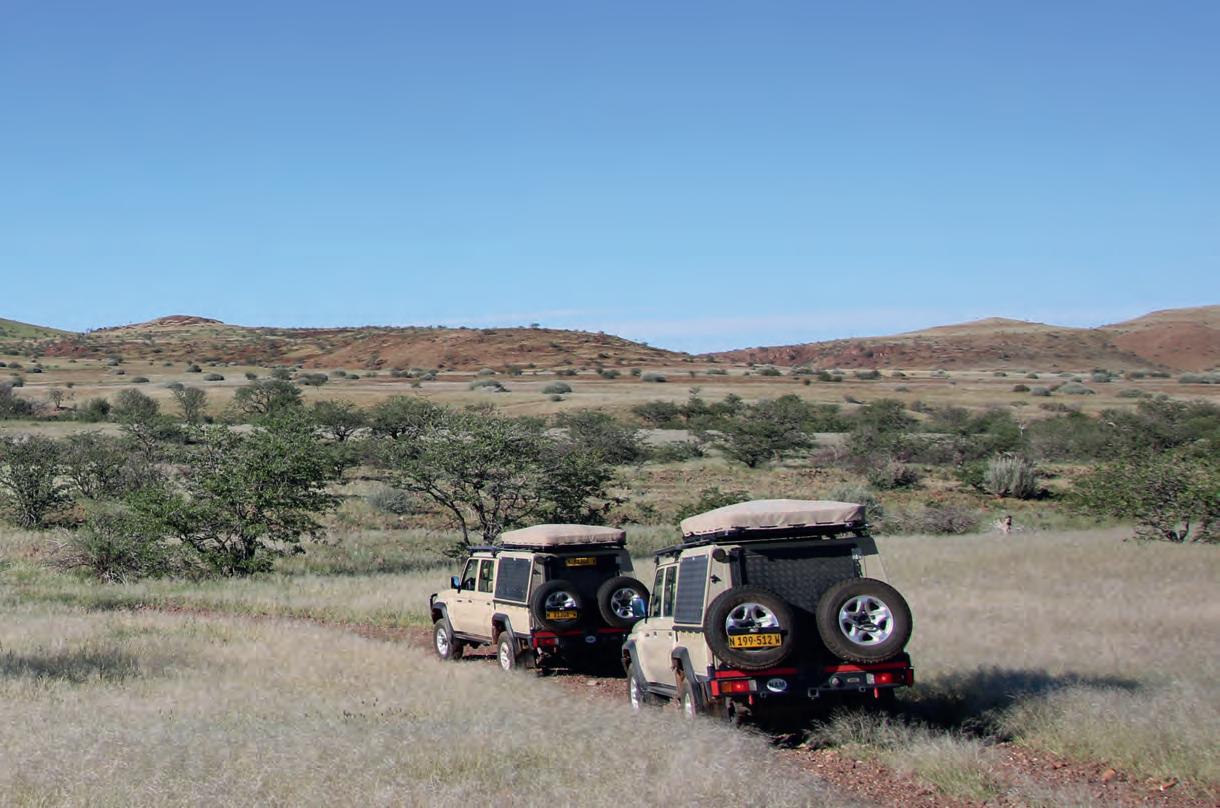

Our roadbooks guide you through the countryside on a mixture of surfaced and unsurfaced roads. The tracks we use are public rights of way, either Byways Open to All Traffic or Unclassified County Roads, all commonly referred to as green lanes.




Elsewhere, let common sense and courtesy prevail. Keep your speed down, be ready to pull over for others and show the world that we are decent people just like them.
We’ve deliberately made it as easy as possible to follow the route, using a mixture of instructions, tulip diagrams and grid references. We normally only include junctions at which you have to make a turning or don’t have right of way, so stay on the main road or continue straight ahead unless we tell you otherwise.


You’ll find a guide to using grid references on the legend of any OS map. Our aim is for you to be able to do the route without maps, whether paper or online, but you should certainly take a set with you.


The notes on thee pages advise you of how suitable the route is for your vehicle. These are just guidelines, however. We’ll warn you of any hazards or difficult sections, but the nature of any green lane can change quickly. Wet weather can make a huge difference to the conditions underfoot, and what’s wide open in winter can be tightly enclosed and scratchy in summer. The responsibility is yours! Our roadbooks are designed to be safe to drive in a solo vehicle. We do recommend travelling in tandem wherever possible, however. The risk of getting stuck can be greater than it appears – and even the most capable of vehicles can break down miles from anywhere.
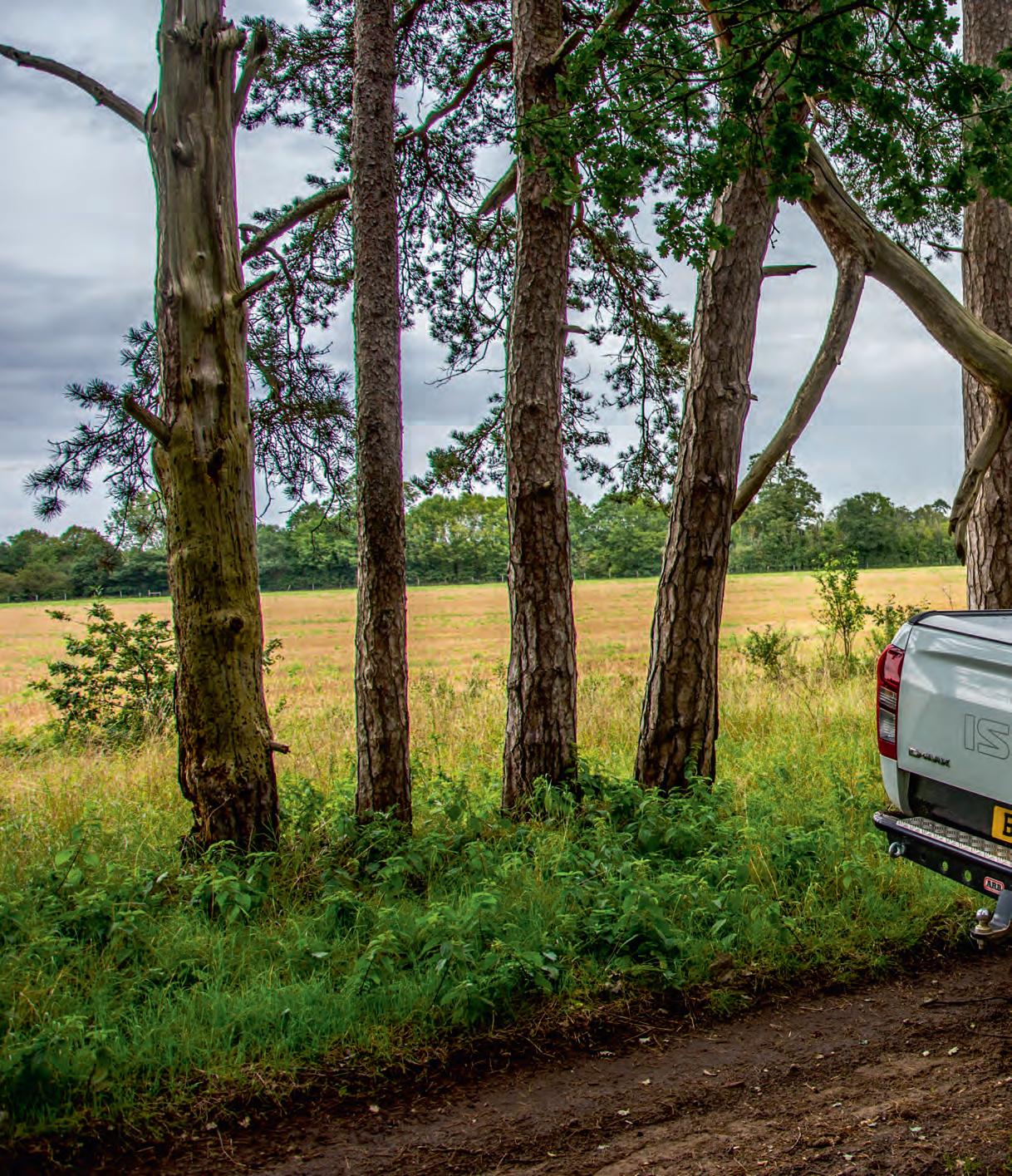
Anti-4x4 bigotry does exist, but it’s less common than you’d think. By and large, it’s limited to organisations which just want to get the countryside all to themselves.
These organisations are beyond being reasoned with, but it’s rare to encounter real hostility even from their rank-and-file members. If you’re friendly towards the people with whom you share the countryside, the vast majority will respond in kind. There are always bad apples, but no more so than anywhere else.

Likewise, most local residents will accept your presence if you’re driving sensibly. What suspicion you do encounter is likely to be from farmers worried that you’re there to steal from them, so be ready to offer a word of reassurance. Once satisfied that you’re not after their quad bikes, their mood will lighten.

Keep your speed right down
• Pull over to let walkers, bikers and horse riders pass
• Leave gates as you found them
• Scrupulously obey all closure and voluntary restraint notices
• Ensure you have a right to be there. We research the routes on our roadbooks very carefully, but the status of any route can change without notice
Irresponsible driving is a big and serious issue on green lanes. In particular, you must always stay on the right of way. Never drive off it to ‘play’ on the verges or surrounding land, even if you can see that someone else has; doing so is illegal and can be tremendously damaging.


This kind of illegal off-roading is a key reason why green lanes get closed. If you see others doing this, they are NOT your friends. They’re criminals, and you are their victim. If it’s safe to do so, film them in the act and pass it to the police.
Be prepared to turn back if the route is blocked, even illegally
• If you find an illegal obstruction, notify the local authority
• Stick scrupulously to the right of way
Always remember that you are an ambassador for all 4x4 drivers
DON’T…

• Go in large convoys: instead, split into smaller groups
• Drop litter. Why not carry a bin bag pick up other people’s instead?
• Go back to drive the fun bits, such as mud or fords, again
Cause a noise nuisance, particularly after dark
• Get riled up if someone challenges you. Be firm but polite, stay calm and don’t let them turn it into a fight





This route combines a series of unsurfaced roads through century-old forestry in the heart of East Anglia with wide open byways across lush arable farmland. The trails here are typified by their sandy nature – which, while it’s not the Sahara, is almost unique within the UK. You’ll come across plenty of other vehicles on these rights of way, as well as lots of walkers, yet you’ll also feel a tremendous sense of isolation as you explore a route which, while it’s not extreme, is still a real off-tarmac adventure
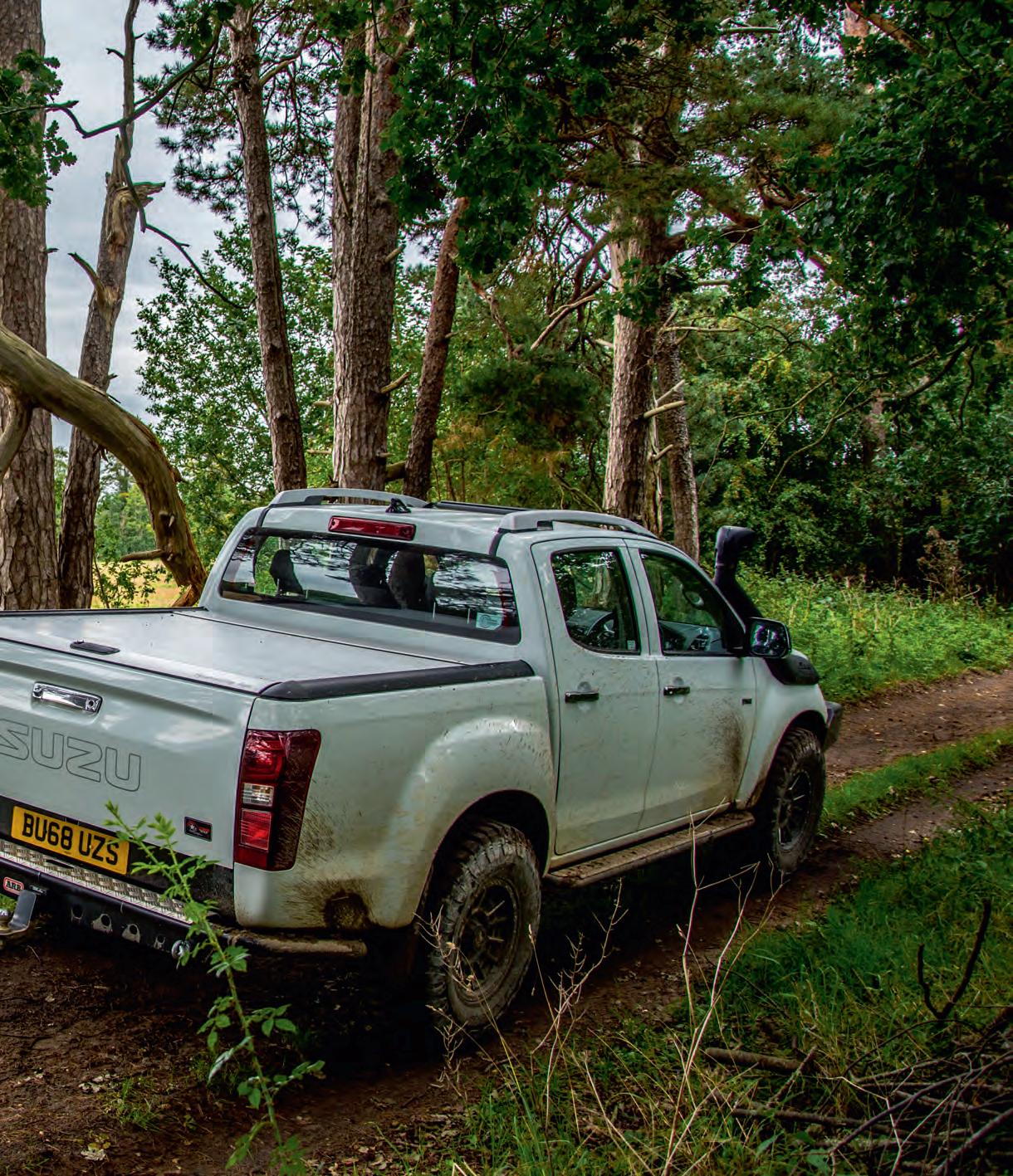
The rights of way in the final part of this roadbook are currently closed for maintainance. Suffolk County Council has pledged to get them open again as soon as possible, however it’s possible that this may not happen until well into 2026 or even the early part of 2027. Be ready to turn back after Step 63 if the signposts instruct you that the lanes ahead are still closed – or better still, check their status on the council’s website before travelling.

START Eriswell (TL 723 781)
FINISH Elveden (TL 813 797)
HOW LONG? 56.4 miles / 5-6 hours
TERRAIN
Low-lying forestry and farmland HAZARDS Occasional moderate ruts; surface water; farm traffic; loads of other users; many dangerous road junctions
OS MAPS
Landranger 143 (Ely & Wisbech)
Landranger 144 (Thetford & Diss)


TYRES Suitable for road treads, but very low profiles may struggle in places
WEATHER Take care when very wet
LOW BOX Not necessary
SOFT-ROADERS
Largely suitable for most models
SCRATCHING A little here and there
DRIVING
One or two tight and uneven bits. Lots of junctions with fast roads DAMAGE No reason why it should happen

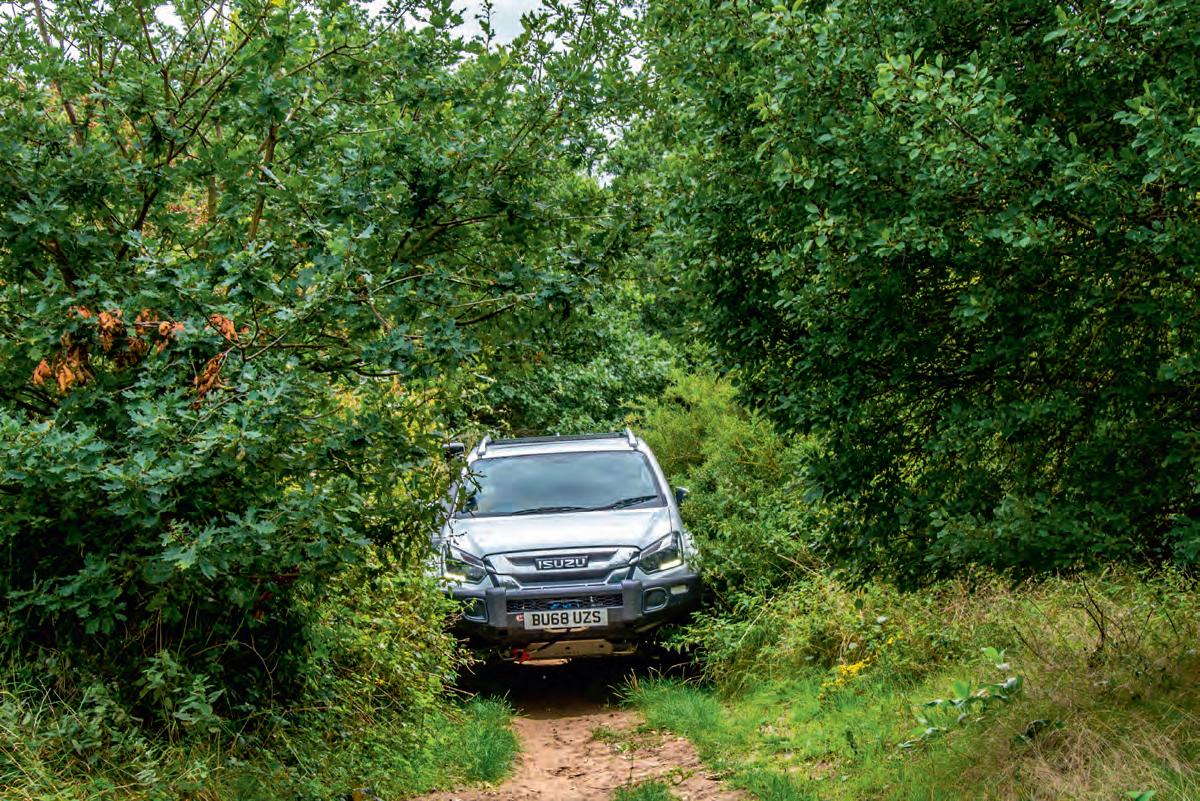
Step

1 0.0
TL 723 781
Start outside The Chequers in Eriswell (it’s just along from the village sign and looks a lot like a house, so it’s easy to miss). Zero your trip with the pub, or indeed the sign, to your right, and set off heading more or less north

3
Step
2

1.15
3.15 Step

4 4.5




Step 1: The route starts opposite the Chequers in Eriswell. Blink and you’ll miss it…




Step 9 (right): Here’s where you finally discover why we’ve taken you through a housing estate


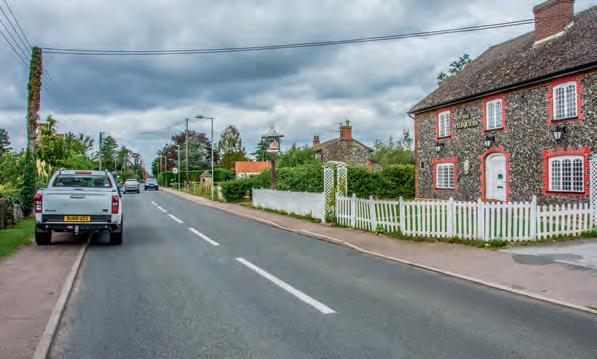
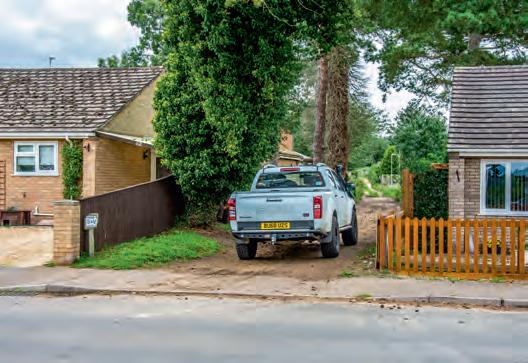



This is shortly after you’ve come in to Brandon


is taking you into a housing estate, so keep your speed down and your eyes open


road gets narrower and becomes tree-lined




The track has been wide open up to now, but it becomes enclosed and a little scratchy for a spell. It looks like singetrack as you approach, though it’s not that bad once you’re into it
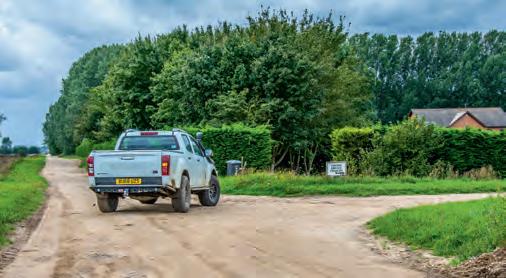


Step 18: It’s not hard to spot this junction. You’ll see the sign to Cross Drove Fishery pointing your way, too







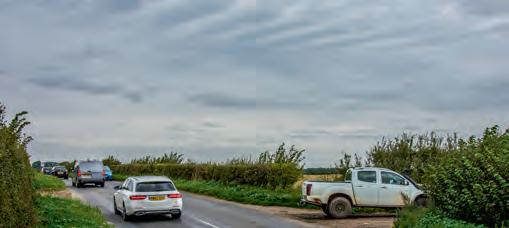







Step 22: The track on the right is unmarked, and not very easy to spot in advance. This is a busy road, too, so take great care













Step 26 (right): This one’s easier to spot – it’s just as you reach the end of the village Feltwell 134 Methwold 6 B1112

3.1 TL 722 888 This one is quite hard to spot in advance, and it’s not signed. You’re on a busy road, too, so keep your speed down and be ready to indicate as far as possible in advance Step
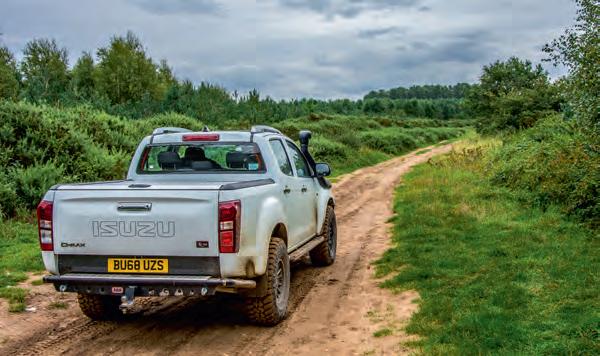
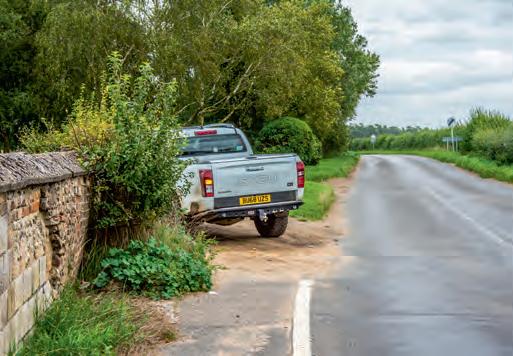








Step 33: Watch out for a series of quite severe crests – you shouldn’t be going fast anyway, but if you are the consequences will serve you right…




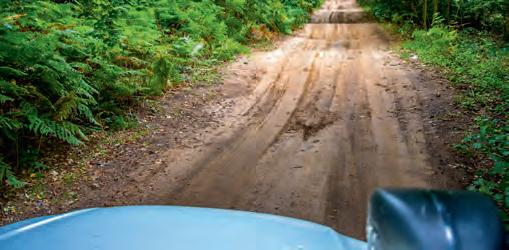









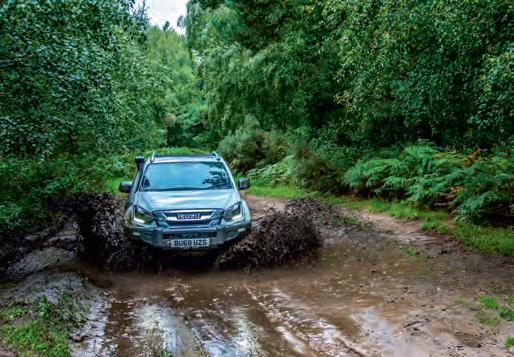






Step 38: The right of way goes across the lay-by then climbs up and over a main road. Needless to say, it’s a big fat caution all the way through this junction



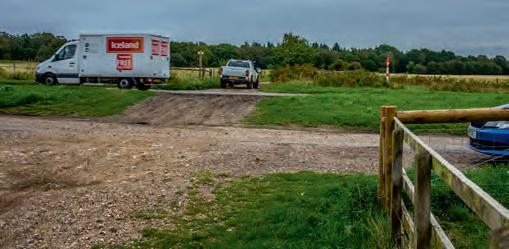





The track splits in two for a short spell and is apt to be flooded. The main route through the middle (which we took in the photo on the opposite page) subsequently had the wreckage of a caravan chassis dumped in it, below the water line, and this was guaranteed to get you stuck; this has since been removed, but we’d suggest skirting round the hole just in case
Caution here. The right of way heads straight across the lay-by then up and over the road. Assume that absolutely no-one will understand what you’re doing ZERO

The track becomes a little enclosed and stratchy

Keep it slow past the house

Caution – it’s blind as you emerge, and traffic approaching from the left will be coming over a blind crest


Stay on the main track all the way along here

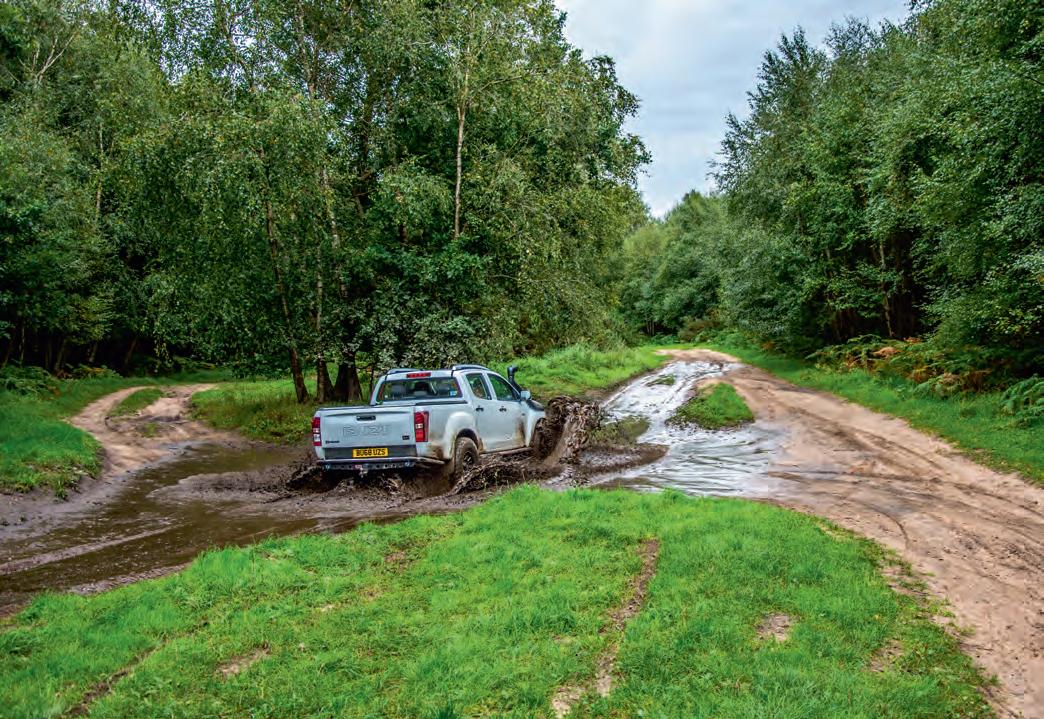











Step 55: Yes, that’s a no vehicles sign you see. The good news is that it actually relates to another right of way which leaves the road at the same junction and doesn’t apply to yours




Step 58 (right): The trail is easy to spot as you approach, but this is a busy road junction and other drivers will have no idea what you’re doing






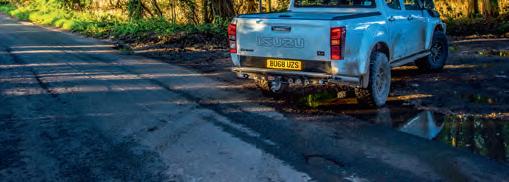

TL 938 794
You’ll see an official ‘no vehicles’ sign at the junction – this relates to another byway which goes out at about one o’clock. The one you’re taking, back over your shoulder (it’s actually 90 right, then right again very soon after), is not affected

4.7

57 1.3
Step

1.7
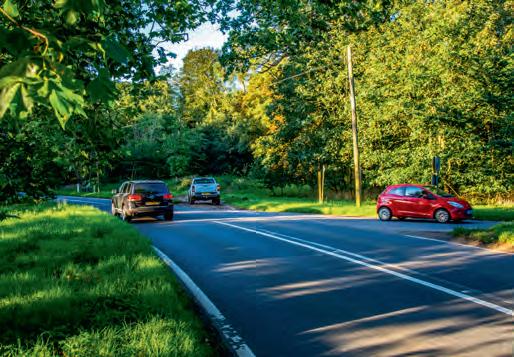



Ixworth A1088
TL 895 788
Immediately after the 90 degree left-hander, fork out to the right on a sandy track. It’s good and visible, and signed as a byway, but other traffic on the road will have no idea what you’re doing
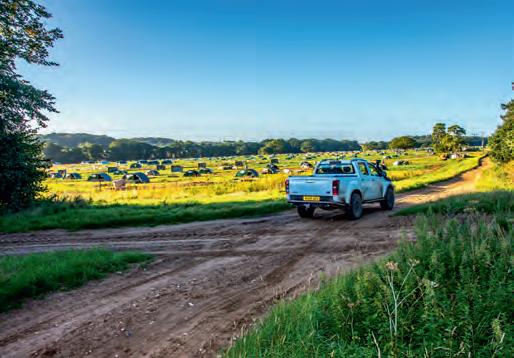
Step

Continue straight ahead past the silos, keeping them to your left. The track gets narrower after this
Caution – this is a main road ZERO TRIP



Step 64: This crossroads comes a little way after another similar junction. Look out for the tree ahead, and the byway signs





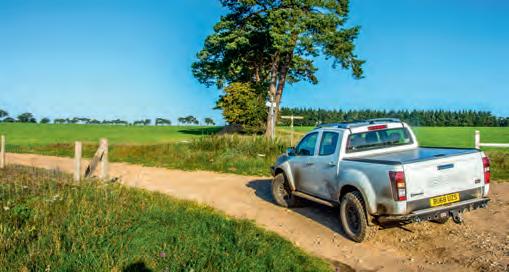
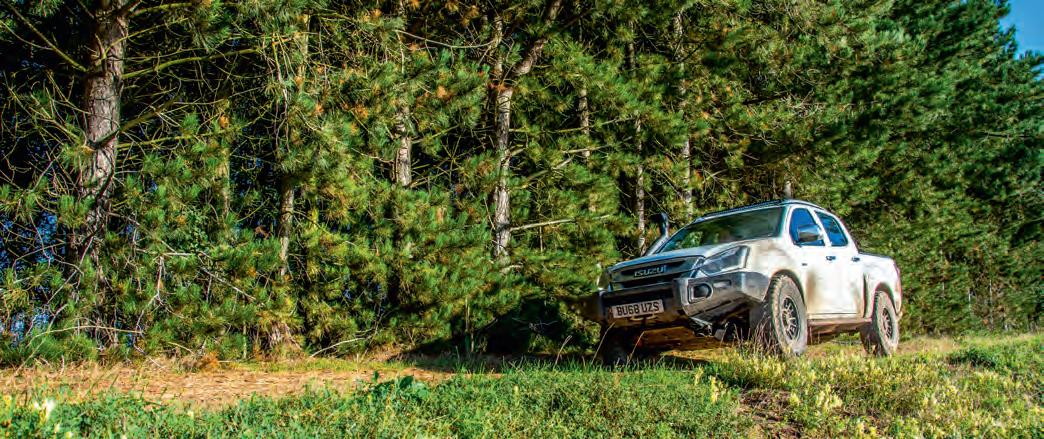

63 0.1

64 1.45

65 2.05

TL 886 761
The lanes beyond this are currently closed until February 2027. Suffolk County Council intends to reopen them as soon as it’s safe to do so, however, so check on the council’s website before travelling – and be ready to abort this final part of the roadbook if the closure signs are still in place
Don’t turn too early – there’s a similar junction a little way beforehand, however it has ‘no access’ signs so you won’t struggle to get the right one! Yours has wooden byway signs pointing to right and left

67 2.85

68 3.2
What has been a very smooth lane becomes very bumpy just before the junction

69 3.4
Note the deep ditches to either side of the byway as it crosses the open field Step 66 2.6
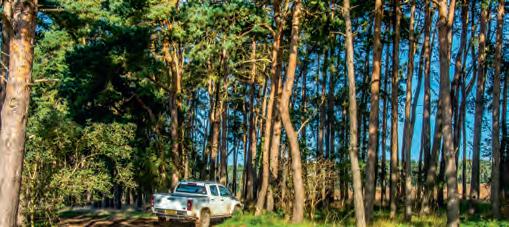


Swing right then turn left on the main track. There’s an outside chance that it might be a bit wet here…

3.55

5.05





Step 67: Wind left into the trees then immediately right again to follow a very well defined track across a field









Step 68 (right): This junction was well flooded, and that was after a fairly dry period of weather…

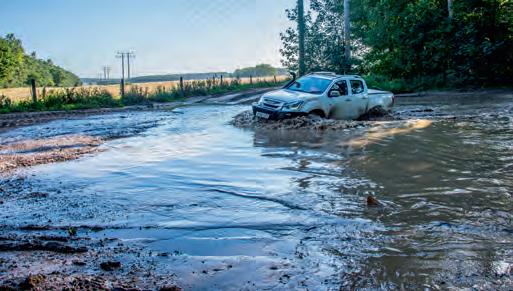








Early 5.0-litre TDI Touareg turned into one of the most unusual modified vehicles we’ve ever featured









A new approach to modding a 4x4 pick-up
Achingly beautiful restifed Land Cruiser Majestic roadbook in the North York Moors
WINTER 2026 ISSUE: ON SALE 20 NOVEMBER




























